|
Nancy's Travel Journal
Belgium and the Rhine River, August 2017
We've been to Europe many times, but never to Belgium or the Rhine River. So we signed up with Grand Circle Cruise Line for a river cruise along the Rhine and Mosel Rivers, including Belgium, the Netherlands, Germany, France and Switzerland. Before the cruise we spent a few days on our own in Brussels and Bruges.
|
Friday, August 11, 2017
The trip begins! Delta was good to us. The flight from San Diego to Atlanta is on time – actually arrives 3 minutes early. Helpful in catching our 5:30 pm connecting flight to Brussels (and in the same terminal). There is a God!
The plane is full – but no obnoxious travelers (except for me, maybe) – and the kindest flight attendants. The cynic in me says they were great because the passengers must fill out an evaluation to be collected upon disembarking. The attendants even risk their lives to get alcohol to the passengers during the turbulence – disobeying the captain’s orders. In spite of the cold, pasty lasagna, the full glasses of wine made everything lovely.
Saturday, August 12, 2017
Our plane arrives in Brussels about 9 am. After a long line to clear customs, we gather our bags and figure out how to catch a train to the heart of town – where our hotel and main attractions reside. Bill is a master at getting around, and in no time, we are in Grand Central Brussels, just a half a block from our hotel, Hotel Le Dixseptieme (French for Seventeenth)
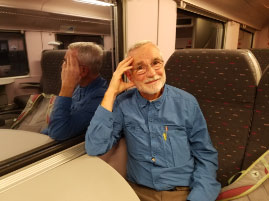
Bill--Heading for Brussels |
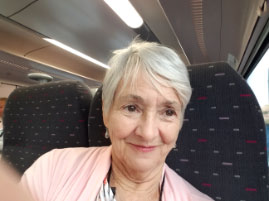
Nancy--Almost there |
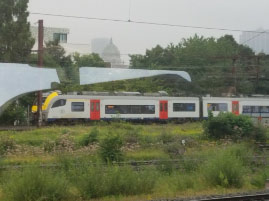
View from the train |
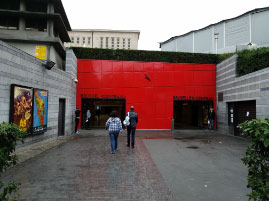
Brussels Central Train Station |
Our hotel is a winner -- it’s a prim, proper and peaceful place – but our room isn’t ready until 1 or 2. We leave our bags in the lobby and hit the town.
It’s cold and drizzly and we’re completely jet lagged. We first walk to the Grand Place (main square) and try to identify which building is which. (A copy of Rick Steves helps a lot!) Town Hall is the biggest building and right across from the King’s House (which is now the City Museum). We find the former Guild Halls and the Swan House – a former bar where Karl Marx and Fredrick Engles met in 1848 to write the Communist Manifesto. We marvel at the artful layout of the produce on the main square – it brings such color to a gloomy day.
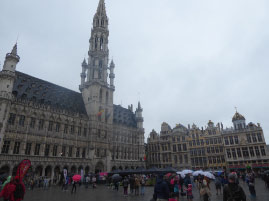
Around Brussels |
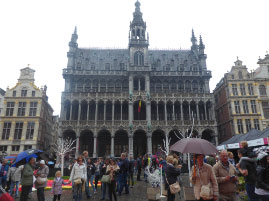
Around Brussels |
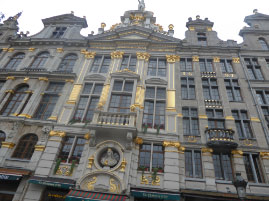
Around Brussels |
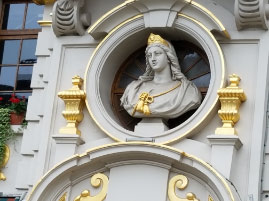
Around Brussels |
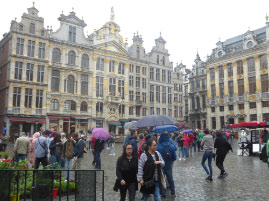
Around Brussels |
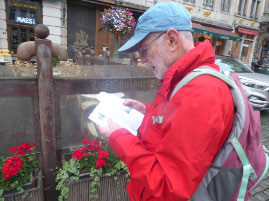
Around Brussels |
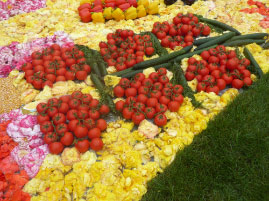
Around Brussels |
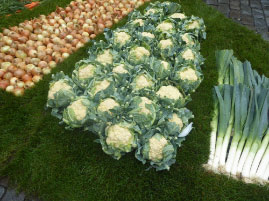
Around Brussels |
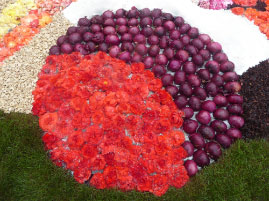
Around Brussels |
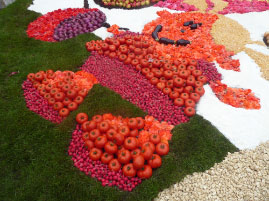
Around Brussels |
We next must take care of business and spend some time finding a store that sells SIM cards for Bill’s phone. Mission accomplished at the Orange Store.
We do a quick Rick Steve’s walking tour and end up at a fancy mall (like the one in Red Square) with beautiful shops. We have a long lunch at a nice café. The waiter wasn’t interested in serving, but we didn’t mind. In our jet-lagged stupor, it is just nice to sit a while and people watch.
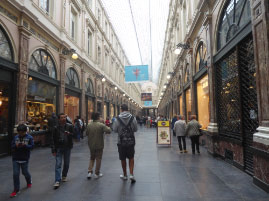
Brussels |
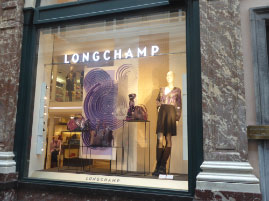
Brussels |
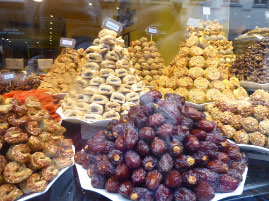
Brussels |
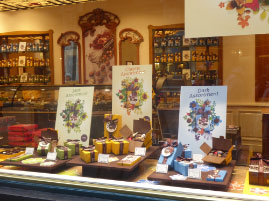
Brussels |
After lunch, we walk down to see the little statue of the boy peeing, Manneken Pis (translated from Flemish “little pee man.” The peeing boy, standing only 24 inches, is a small bronze fountain statue from the 17th century and has become a symbol of Brussels. The little guy didn’t do much for us – but even in the rain, he brought out the crowds. We see other statues we like much more – and we can enjoy them all to ourselves.
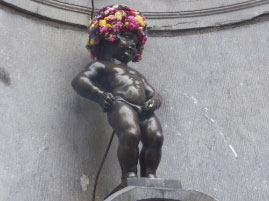
Manneken Pis |
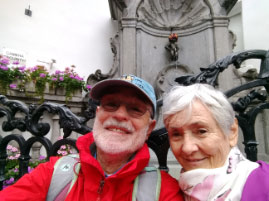
Bill and Nancy with Manneken Pis |
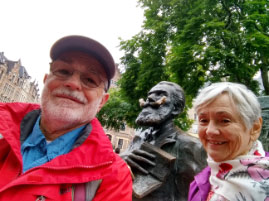
Bill and Nancy with Karel |
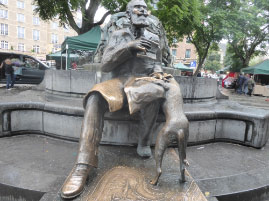
Karel Buls Statue |
We return to the Grand Place hoping for a “free tour” as advertised, but no luck. The increasing rain dampens our spirit so we return to our hotel, hoping our room is ready. It is a delightful room with a lovely sitting room overlooking the garden. This is one classy place. Our room is named after Rik Wouters (1882 -1916), a famous Belgium painter and sculptor. We learn more about him and see his works the next day in the Académie Royale des Beaux-Arts. His style resembles Cézanne and Renoir. Wouters quickly became popular as a young man, but then the Great War and his illness put a damper on the rest of his career.
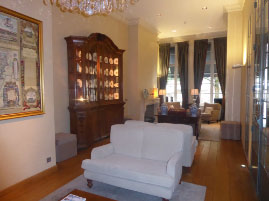
Hotel Le Dixseptieme |
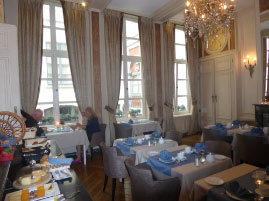
Hotel Le Dixseptieme |
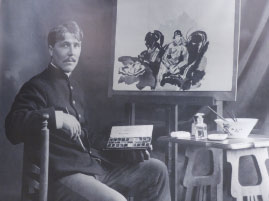
Rik Wouters |
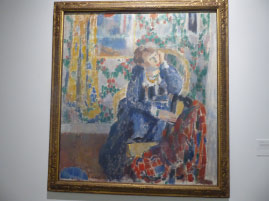
Rik Wouters painting in our room |
I take a much needed nap. Bill tries to stay awake. About 5 pm, we venture back out in the drizzle looking for a place for a simple dinner.
We have trouble finding the place as we follow our jetlagged version of Google. We do find some interesting sites – love these crazy Belgiuns.
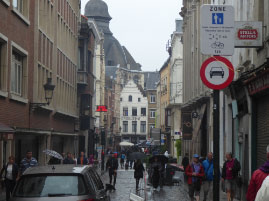
Brussels |
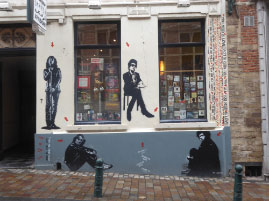
Brussels |
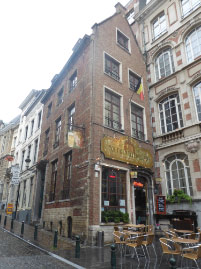
Brussels |
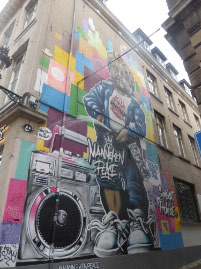
Brussels |
Finally we get serious finding a place for dinner. The first recommended stop only offers brunch. Bill never gives up and finally, we find “Fin De Siecle” -- a local bohemian French restaurant and order a “plate” – steak, potatoes and salad.
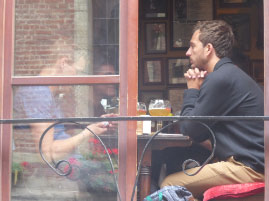
Fin De Siecle |
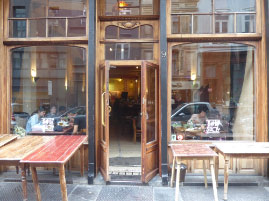
Fin De Siecle |
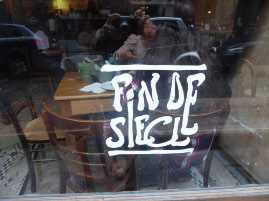
Fin De Siecle |
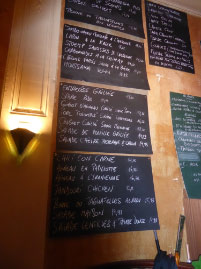
Fin De Siecle |
We walk back to the hotel stopping for a street Belgium waffle smothered in chocolate. The waffle is way too gooey and not easy to eat. Of course, I manage to drip chocolate all over myself!
We get back to the room about 8:30-ish and call the kids. Zion just got home from Boston. She sounds so happy.
We go to bed and both sleep fitfully most of the night -- to be expected changing time zones.
P.S. Trump made the day very difficult with his inflammatory statements against North Korean Presedent, Kim. Both have deep emotional problem and I wish they would just drop their drawers and see once and for all who has the biggest penis – my guess is the little peeing boy statue beats them both. Hard to enjoy life when it could end at any minute.
Sunday, August 13, 2017
We have a lovely breakfast in our lovely hotel – thanks to the Donald and his buddy Kim for giving us another day. Also thanks that the rain is gone and our spirits are lifted.
We take a walking tour to the “newer” part of town in the “Royal Quarter,” located on atop the Coudenberg (Cold Hill). In medieval times, Charles V built a vast palace. The palace was destroyed in a major fire in 1731, but the foundations can still be seen in the underground Coudenberg Palace museum (Place des Palais 7).
A statue of a Christian knight, Godfrey of Bouillon (ca 1060–1100), posses triumphantly on top of Cold Hill. Godfrey was one of the victorious leaders in the first Crusade in 1096–1099 and is glorified in mediaeval legends as a Christian knight without fear and reproach. Belgium first declared its independence after the rebellion in 1830 against King William I of the United Kingdom of the Netherlands. Leopold I, once a German prince, became the first King of Belgian and reigned between July 1831 and December 1865. This noble statue was inaugurated in August 1848 in the presence of king Leopold I and his new government. By the way, I am crazy about these statues – it’s a quick way for me to learn some history.
Radiating out from the main statue is a grand view is Parc Royal, the Royal Palace and the museum quarter. It is also home to the Belgian government with stately ministry buildings and the federal parliament. This is the area we targeted to cover on our last day in Brussels and so we start.
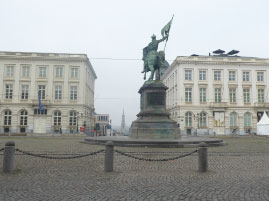
Brussels Royal Quarter |
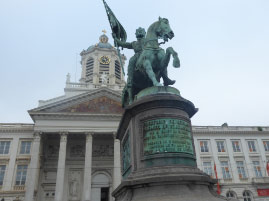
Brussels Royal Quarter |
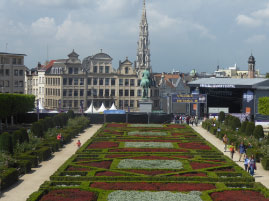
Brussels Royal Quarter |
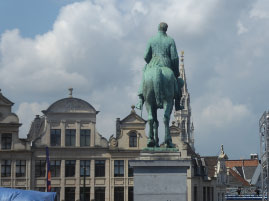
Brussels Royal Quarter |
Directly behind horse’s butt, we enter a neoclassical church, Saint Jacques-sur-Coudenberg, in the historic square of Place Royale in central Brussels. The church was built in the 1730s. During the French Revolution, the church abbey was made into a Temple of Reason, and then later into a Temple of Law. The church returned to Catholic control in 1802. On July 21, 1831, on the front steps of the church, Prince Leopold took the oath that made him the first King of Belgium. For that big event, the chapel was not that remarkable. (However, I am always fascinated by the confessionals – must be former life stuff.)
We scurry down the block to see Norte Dam – which is remarkable, stopping at a couple of statues along the way.
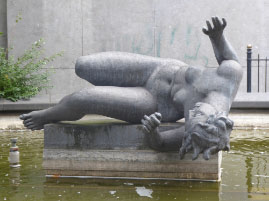
On the way to Notre Dame
|
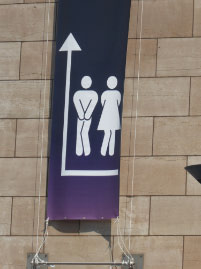
On the way to Notre Dame |
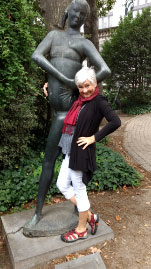
On the way to Notre Dame |
We are disappointed that Norte Dam is closed, but right across the street is a lovely little park – Jardin (means garden) du Petit Sablon
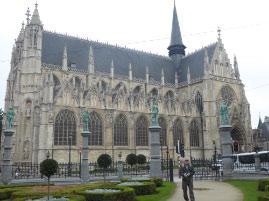
Église notre dame du sablon |
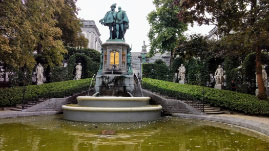
Jardin du Petit Sablon |
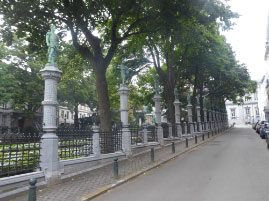
Jardin du Petit Sablong |
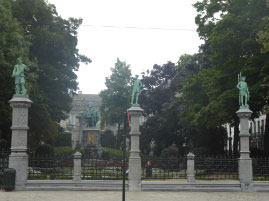
Jardin du Petit Sablon |
I am so taken by this interesting park. In the center is a nice fountain and a statue of two Flemish men -- Counts Egmont and Horn -- who were martyrs of the 16th century. One was Catholic and the other Protestant, but both tried to prevent Spain from bringing the Inquisition into Belgium. The Duke of Alba on the orders of the King of Spain charged them with rebellion and treason and had them both decapitated in 1568.
The statue of the two pals is surrounded by 12 figures from the 15th and 16th centuries. They are Free Masons – no women allowed – and they each hold tools of their trade (occupation). On the fence surrounding the garden there are 48 smaller statues. I am amazed at this little pocket park is one of the most interesting spots in the city. Man, the history I can learn here – very special.
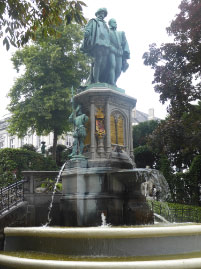
Jardin du Petit Sablon |
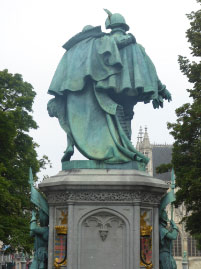
Jardin du Petit Sablon |
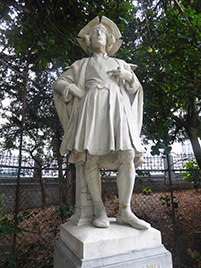
Jardin du Petit Sablon |
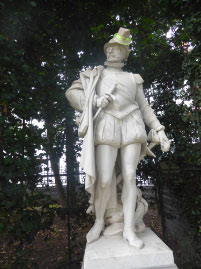
Jardin du Petit Sablon |
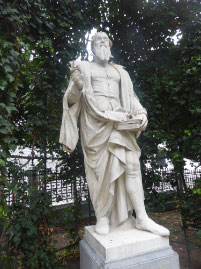
Jardin du Petit Sablon |
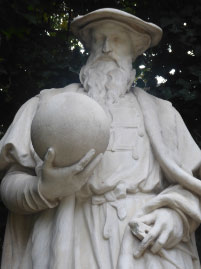
Jardin du Petit Sablon |
Next, we check the “Infantry Memorial of Brussels” off our list. It’s located outside the magnificent Palace of Justice (at the Place Poelaert). The Infantry Memorial honors the memory of the Belgian foot soldiers who fought in World War I and World War II. The monument needs a little renovation – the panoramic views of the city below are fabulous.
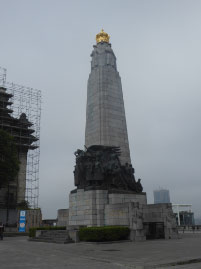
Infantry Memorial of Brussels |
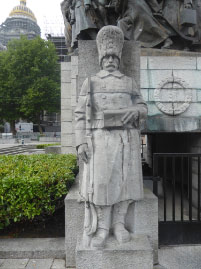
Infantry Memorial of Brussels |
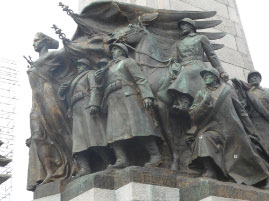
Infantry Memorial of Brussels |
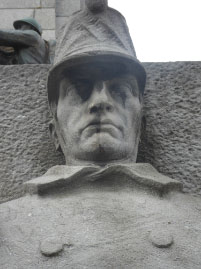
Infantry Memorial of Brussels |
We buy our tickets to see the Place Royale. The Royal Palace of Brussels is the official palace of the King and Queen located right in the center of the nation's capital. We visit the Royal palace and opulent rooms with chandeliers and inlaid wood floors.
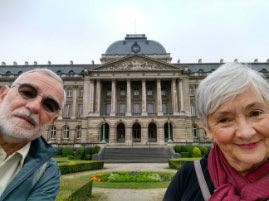
Royal Palace of Brussels |
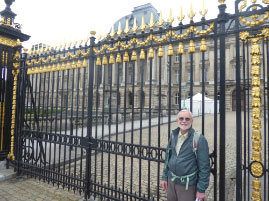
Royal Palace of Brussels |
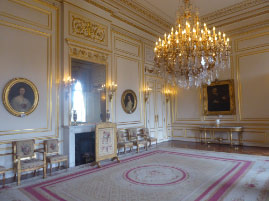
Royal Palace of Brussels |
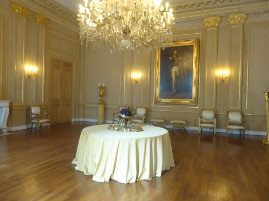
Royal Palace of Brussels |
There are a couple of interesting exhibits – “What heaven is like” and an odd collection of Prince Karel (AKA Charles) – brother of King Leopaold (grandfather of today’s king).
NOTE: I suspect that Karel was gay. He was a brilliant artist, lived 80 years and never married. It was fun seeing the photos of him growing up – as a kid, in the military, going to the Belgium Congo to take more land and rubber (for car tires), to help his father increase his already enormous wealth. Crazy, fascinating life – helped me put some pieces of history into context.
We share a tuna sandwich next door at the Museum Café in a garden – very relaxing.
We decide to knock off one more museum before we head to Bruges. The Fine Arts museum is daunting for two weary travelers. I don’t know why – but I have a passion taking photos of people as they move through an art museum. This one was no different – indulge me with my mini collection.
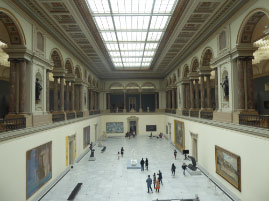
Fine Arts Museum |
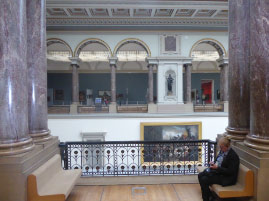
Fine Arts Museum |
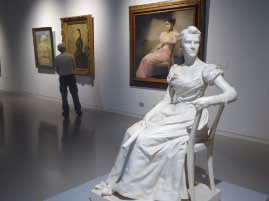
Fine Arts Museum |
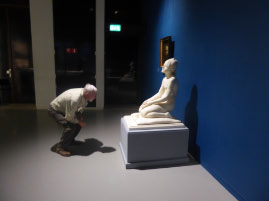
Fine Arts Museum |
Now on to checking out the great works of art. We visit the old master’s section -- stuff from the 1500’s. Several paintings depicting the generic religious stories are set in 15th Century Belgium. Many of the earlier ones present a major “scare” factor – devils, snake-like monsters coming to rip apart earthlings, etc. My favorites are the country scenes – amazing details of village life back then. I could study these paintings for hours – and make Bill completely crazy.
The impressionistic gallery is nicely laid out. Of course we must visit Rik Wourters collection because our hotel room bears his name. I really like impressionistic stuff because you can feel what life was like during that period – the rich, the poor, the opera, the joys and the struggles.
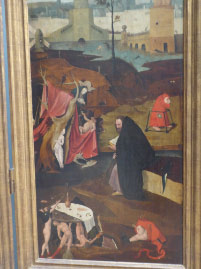
Fine Arts Museum |
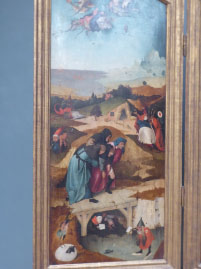
Fine Arts Museum |
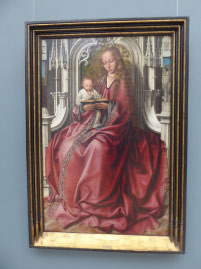
Fine Arts Museum |
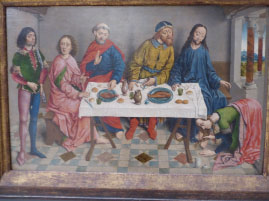
Fine Arts Museum |
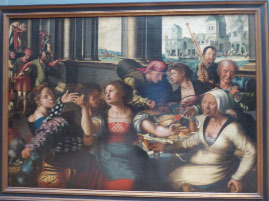
Fine Arts Museum |
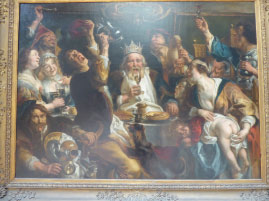
Fine Arts Museum |
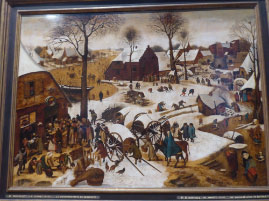
Fine Arts Museum |
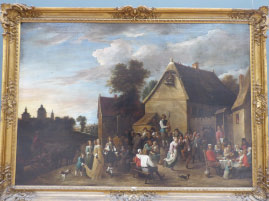
Fine Arts Museum |
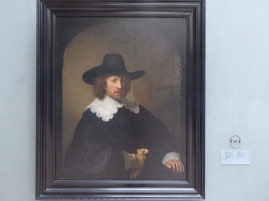
Fine Arts Museum |
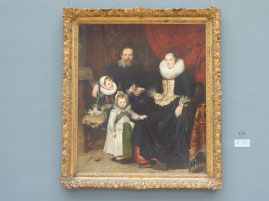
Fine Arts Museum |
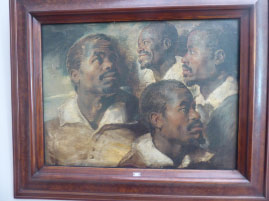
Fine Arts Museum |
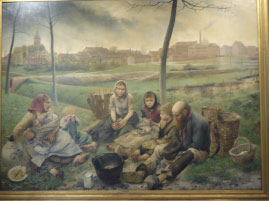
Fine Arts Museum |
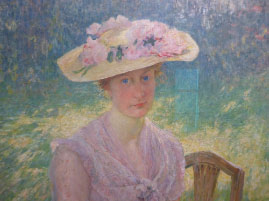
Fine Arts Museum |
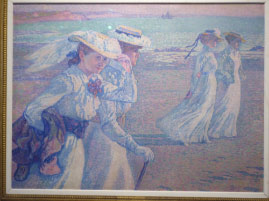
Fine Arts Museum |
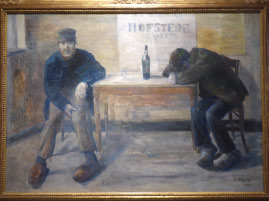
Fine Arts Museum |
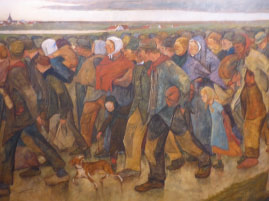
Fine Arts Museum |
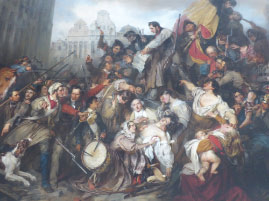
Fine Arts Museum |
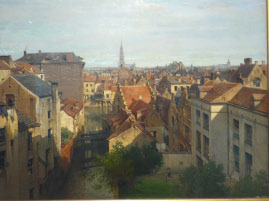
Fine Arts Museum |
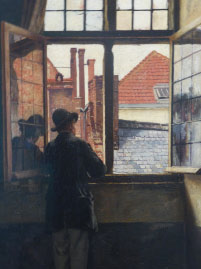
Fine Arts Museum |
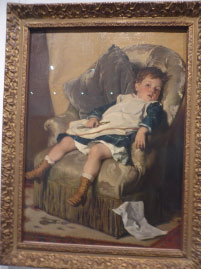
Fine Arts Museum |
We are on visual overload so we nix taking on the museum’s Modern Art section and head back to our hotel to grab our luggage. We roll it to the Central RR station about a block away from our hotel. We are 45 minutes early, but almost miss or train because of a last minute change to another platform. We run like crazy. Thank goodness for the kindness of young strangers, who carry my luggage up and down the stairs.
We spend most of the hour-long train ride writing in my journal and catching glimpses of Belgium’s beautiful countryside, interrupted by small towns. I see green, green grass and red, red buildings – my oh my!
Nancy’s Footnote about Brussels:
Brussels is an enigma – The old wealth and grandeur with a touch of Van Gough’s Potato People permeates the place. Brussels is not classy or fashionable like France, nor grand like Italy. It’s the scrappy underdog that achieves greatness and then falls back only to emerge again. In Medieval times, it was at the top of its game … then came 1830’s and the French Revolution. It climbed back to get hit hard again during WW I and WW II. Now it seems to have found it’s footing when it was designated headquarters for the EU – I love an underdog. You go Brussels – Give ‘em hell.
We arrive in Bruges. I want to take a taxi from the train station to our hotel, but Bill votes for a bus. The bus wins because there is a line at the taxi stand no with taxis in site … while the #12 bus is loading. We get off at the Market Square. I’ve been to a lot of Market Squares in my time, but this one takes the cake – breathtaking. Our hotel is only a couple of blocks away.
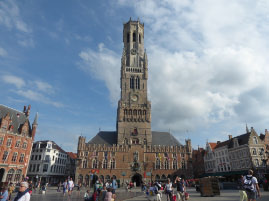
Bruges Market Square |
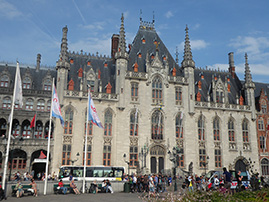
Bruges Market Square |
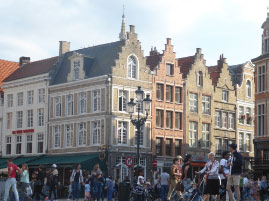
Bruges Market Square |
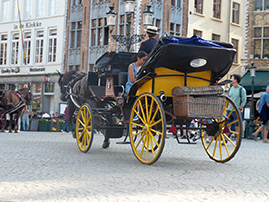
Bruges Market Square |
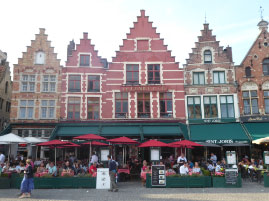
Bruges Market Square |
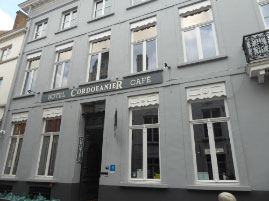
Hotel Cordoeanier |
We love the location of the hotel-- Hotel Cordoeanier--BUT BOY IS IT SMALL! (It will prepare us for our cabin on the boat.) We can’t put things away because there’s no place to put them. We do our best – and then have a beer at the hotel pub – Rose Red.
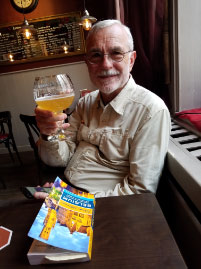
Bill at the Hotel Cafe
|
We take the most beautiful walk on our way to a great little restaurant by the canal. Twilight time – my favorite part of the day.
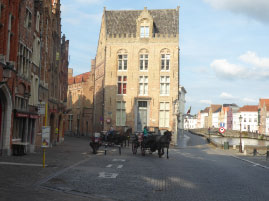
Bruges |
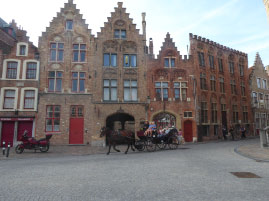
Bruges |
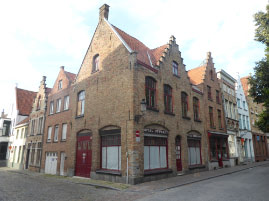
Bruges |
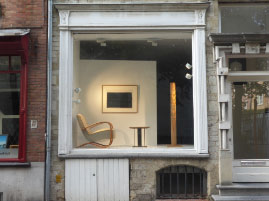
Bruges |
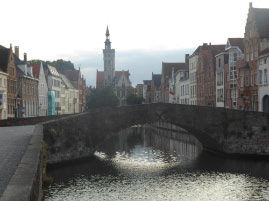
Bruges |
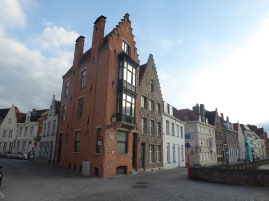
Bruges |
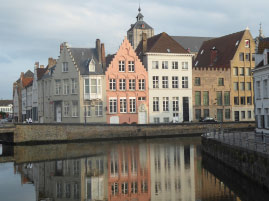
Bruges |
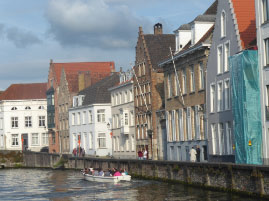
Bruges |
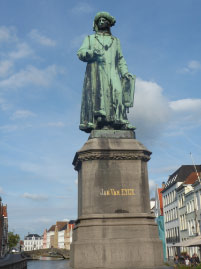
Bruges |
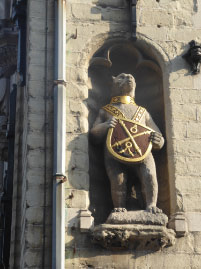
Bruges |
I fall in love with the little café-- Café-Bistro Terrastje--with delicious home cooking and a wonderful, no nonsense server. We have the chicken potpie without the crust and as promised, REAL Belgium waffles. The walls of the soul-full old restaurant is covered with American Jazz memorabilia from the 1930’s. I feel so at home there and wish Zion, (on her way to becoming the next Sarah Vaugh) could see all this. (Little did we know that Zion and her family would be having Easter dinner here on her springbreak. They loved the place too!)
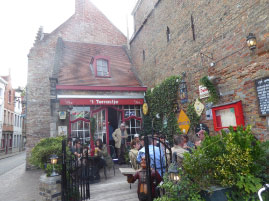
Café-Bistro Terrastje
|
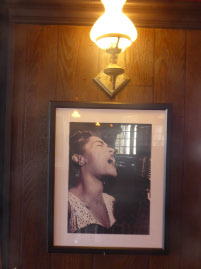
Café-Bistro Terrastje
|
We take a long meandering walk after dinner. I am having so much fun taking pictures and am sad when the sun takes my light away and we have to go back to our tiny room. We get back about 8:30 pm. Bad news – the TV doesn’t work. Good news – we don’t have to watch Bad news!
We take turns getting ready for bed. We, along with our stuff, barely fit into the room … but Bruges is beautiful! Let the Bruges adventure begin.
Monday, August 14, 2017
After a good rest and a simple, fresh breakfast, we are feeling energized and ready to see Bruges. We watch the square wake up and check out the “downtown” area.
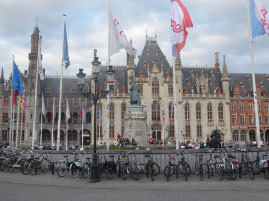
Bruges |
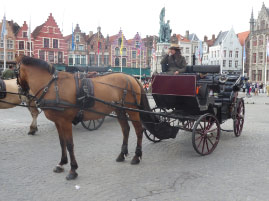
Bruges |
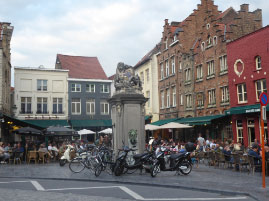
Bruges |
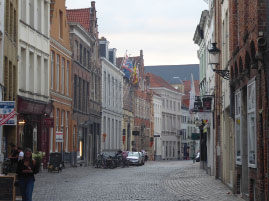
Bruges |
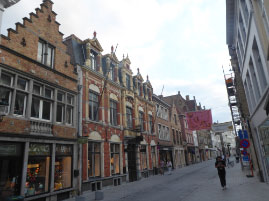
Bruges |
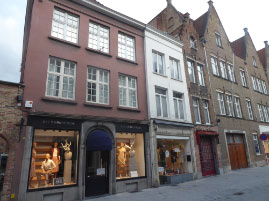
Bruges |
We climb the Bell Tower – all 366 steps and learned the importance of the Bell Tower / Town clock. It served as the warning system for fires, for enemies coming, and celebrations. Interesting to see how the bells are driven by a “Player-piano type drum.” We are treated to a deafening concert as we watch the bells do their thing. The best part of the Bell Tower were the magnificent panoramas of the city below bathed in the morning sun. I take hundreds of photos – only post four to spare you.
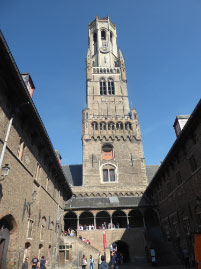
Bruges Bell Tower |
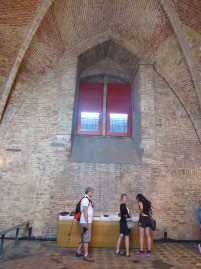
Bruges Bell Tower |
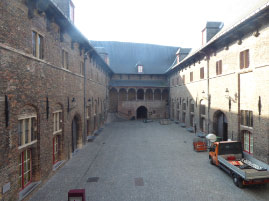
View from the Bell Tower |
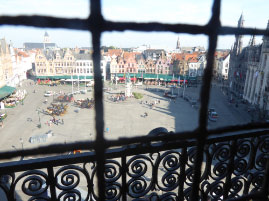
View from the Bell Tower |
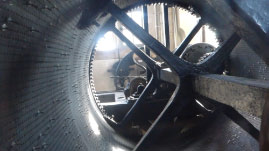
View from the Bell Tower |
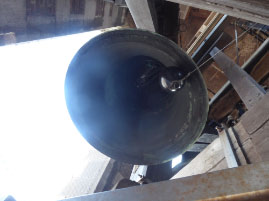
View from the Bell Tower |
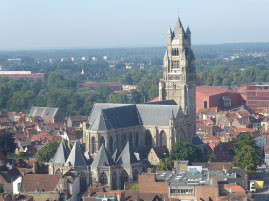
View from the Bell Tower |
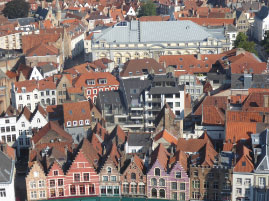
View from the Bell Tower |
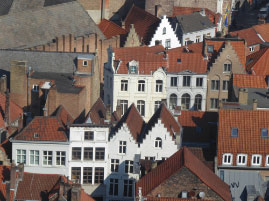
View from the Bell Tower |
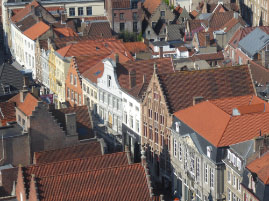
View from the Bell Tower |
Next we visit the “Historium” – an elaborate Disneyland production that occupies one of the vast old buildings located on the square. In spite of the very high “corniness” factor, I learn a lot about medieval times in Bruges around 1435. This great trade city was in its heyday then with tremendous wealth. There were lots of travelers / businessmen on the road doing “business and looking for love in the Turkish bath. A great artist, Ivan Van Dyck lived in town and was commissioned by the wealthy merchants. (We saw his statue yesterday.)
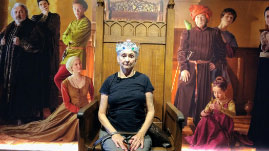
Nancy at the Historium
|
After our laser / hologram / wowie zowie “Historium” tour, we have a drink and enjoy fabulous views of the main town square – Can this place be real?
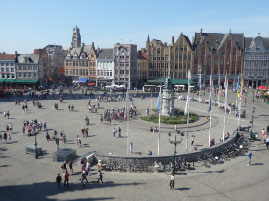
Bruges |
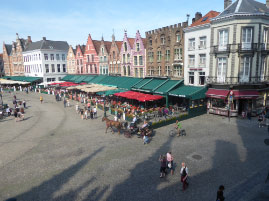
Bruges |
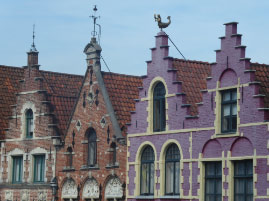
Bruges |
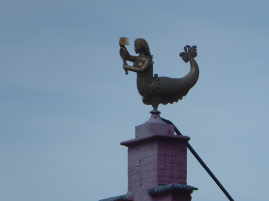
Bruges |
We have a 1 pm reservation for the Brewery tour at the Half Moon. We almost miss it because our quick lunch stop at a sidewalk café wasn’t quick enough due to our lost order. We finally grab a sandwich to go and dash to the Brewery just in the nick of time. It’s a great tour. We learned about hops, wheat (mash), fermentation, use of water, bitter, etc. Our guide tells us that it is far more complicated to make beer than wine. The Brewery started in 1856 with Henri Mai I. The business was handed down through generations – from Henri I to Henri IV – then to a daughter and now, her son. The original brewery is the museum we’re visiting. They’ve done very well and the beer is great! We sample their goods after the tour.
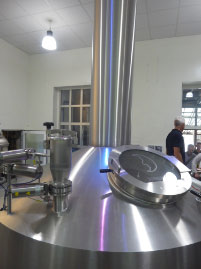
Half Moon Brewery |
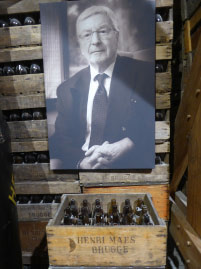
Half Moon Brewery |
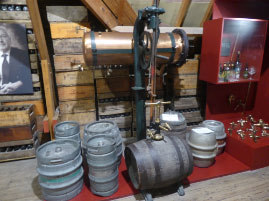
Half Moon Brewery |
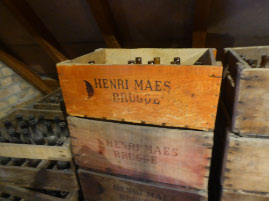
Half Moon Brewery |
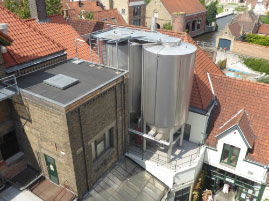
Half Moon Brewery |
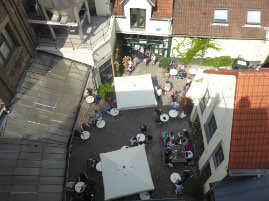
Half Moon Brewery |
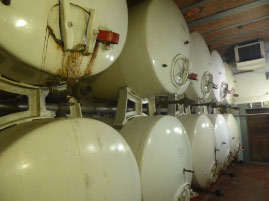
Half Moon Brewery |
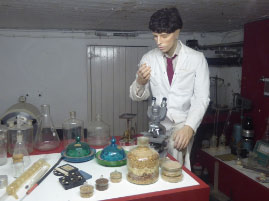
Half Moon Brewery |
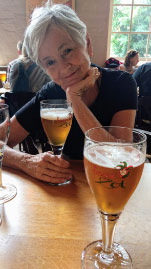
Half Moon Brewery |
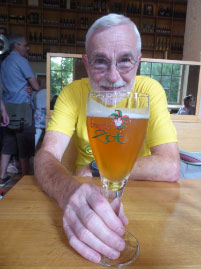
Half Moon Brewery |
Next stop is the Church of Our Lady – a memorial to power and wealth, dating back to the 13th, 14th and 15th centuries. Its 377 feet high tower remains the tallest structure in the city and the second tallest brickwork tower in the world.
Their claim to fame is a delicate marble carved Madonna and child created by Michelangelo around 1504. It is one of the few works of Michelangelo outside of Italy. It was originally meant for the Siena Cathedral, but was purchased by two merchants (and brothers) from Bruges. I witness people in awe of the piece, some even in tears. I thought it was nice – but it didn’t prove to me that Michelangelo is the true genius, as promised by our tour book.
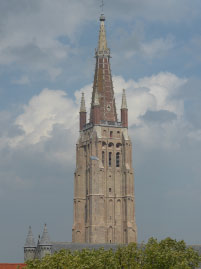
Church of Our Lady |
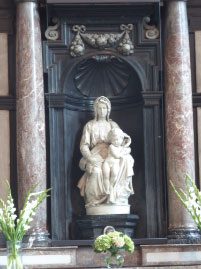
Church of Our Lady |
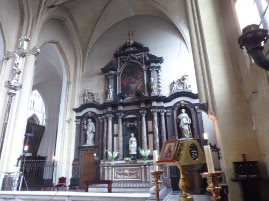
Church of Our Lady |
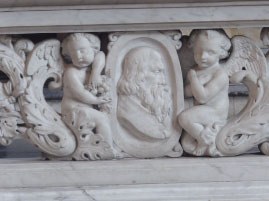
Church of Our Lady |
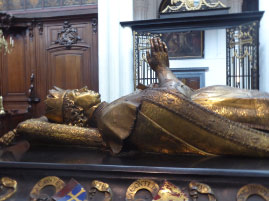
Church of Our Lady |
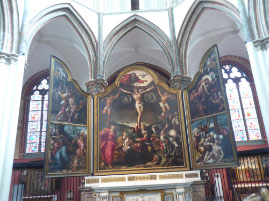
Church of Our Lady |
Next, we make our way to the Basilica of the Holy Blood. The chapel contains a phial that reputedly contains Christ's blood brought back from the Crusades. The blood is rarely on display and we are on overload, so it really didn’t matter. We walk through the crowds in a daze and then head back to our tiny little hotel room. (Little did we know that our kids would see the actual blood the following Easter. They got a close up view and were impressed with the phial.)
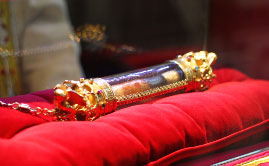
Phial with Jesus's blood
|
We relax a bit and then go to an excellent Italian place called Carlito’s, right around the main square. It’s the real deal – real Italian food served by real Italian waiters – wonderful evening. I love pasta. I love Italy. I love gluten! I love gluttony! Back at our hotel, we plan our last morning in Burges and manage a little “wiggly” room in our tiny bed.
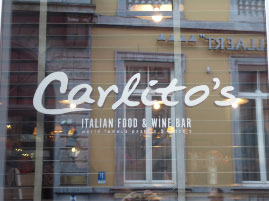
Carlito's Restaurant |
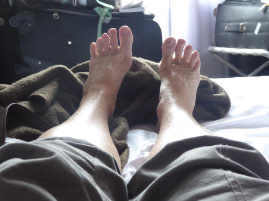
Back at the hotel |
Tuesday, August 15, 2017
First thing in the morning, we go to St. John’s Hospital and see the Memling collection. The place was a former monastery and hospital complex. It opened in 1180 to care for all the refuges and visitors who made pilgrimages to Bruges to see Jesus’ blood. All the antiquated medical instruments fascinate me. The museum also contains several paintings of the greatest of Flemish painters – Han Memling has two important pieces – St. John’s alter piece and miniature shrine to St. Ursula (1489). While we were inside, a major thunderstorm brews overhead. The thunder bolts came with a bit of a shake.
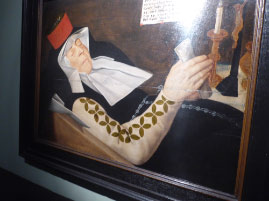
St. John’s Hospital and Memling collection |
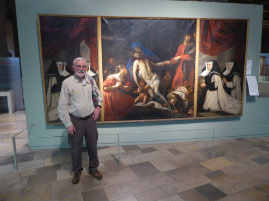
St. John’s Hospital and Memling collection |
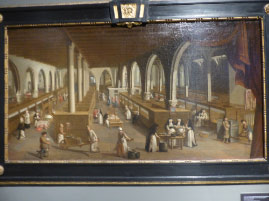
St. John’s Hospital and Memling collection |
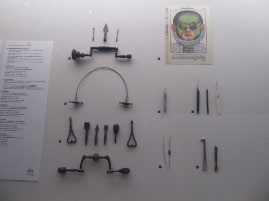
St. John’s Hospital and Memling collection |
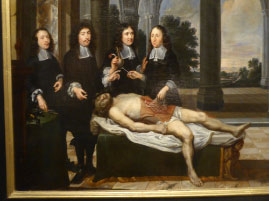
St. John’s Hospital and Memling collection |
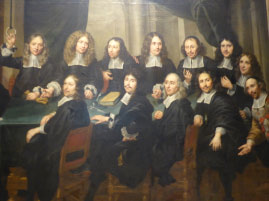
St. John’s Hospital and Memling collection |
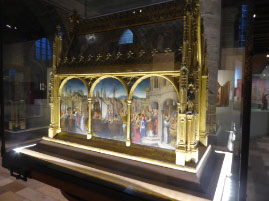
St. John’s Hospital and Memling collection |
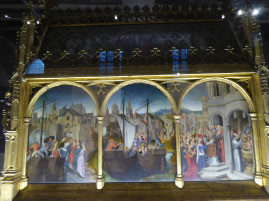
St. John’s Hospital and Memling collection |
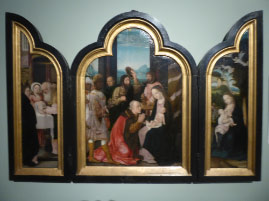
St. John’s Hospital and Memling collection |
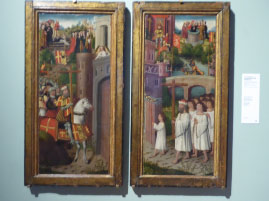
St. John’s Hospital and Memling collection |
After the rain lets up, we make a quick stop at the old pharmacy (Apotheek), just around the corner from the hospital. I really enjoy the hospital complex.
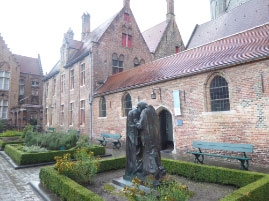
Apotheek
|
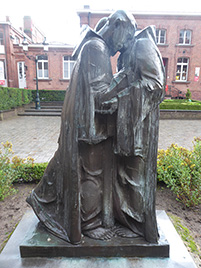
Apotheek |
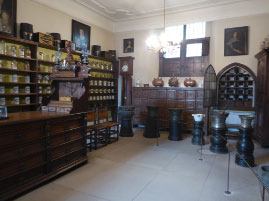
Apotheek |
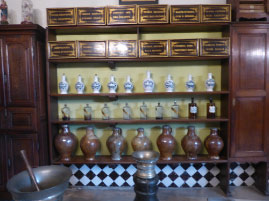
Apotheek |
We walk back to the hotel to pick up our luggage. On we way, we see a model of the Bell Tower and know we’re going to miss this magical place.
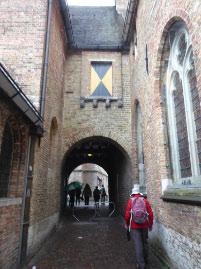
Walking back to our hotel |
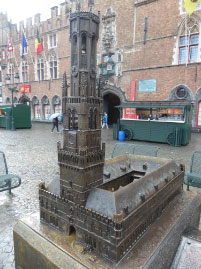
Model of Bell Tower |
We wait for Bus #2 or #12 at Market Square to take us back to the the RR station. While we are waiting, a taxi rolls up and says to us “It’s a holiday so there’s no buses today” … but I point out that one was just behind him. Cabbies everywhere are just the same – can’t trust them … except in Japan.
At the train station, we grab a quick lunch and catch the train to Antwerp by 12:26 pm. It was a smooth ride – except for the piercing sounds of a loud child who continually interrupted my “Train of Thought!”
We arrive in at the most incredible train station in the heart of Antwerp and find the INFO office. The friendliest woman told us how to take the metro to the banks of the Schelde River to find where our boat, MS River Rhapsody, is docked.
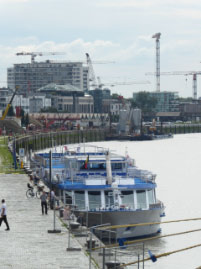
We spot our boat |
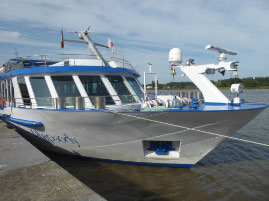
MS River Rhapsody |
Dragging our luggage, we make two metro stops (no ticket) and then emerge into the middle of a crowded, lively market place. We did have some trouble finding our boat because the tide was so low, you couldn’t see the boats beneath the pier. A crew member, on his way to board the boat, identifies us two pitiful gray-haired Grand Circle / OAT-types with luggage in tow. He quickly grabs our bags and leads us to the boat. Nice to have somebody take good care of us -- our cruise now officially begins.
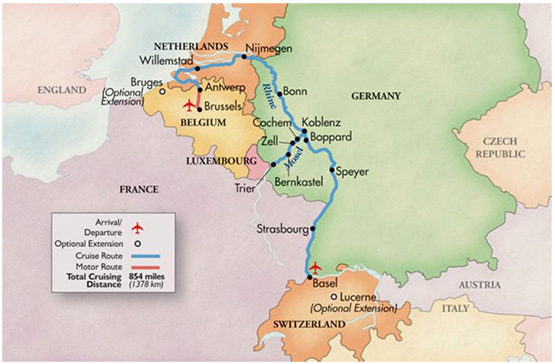
Cruise route |
Surrounded by the friendliest crew and staff ever, we find our way to the room (#325). We are happy – nice, comfy place and much larger than our hotel room in Bruges. We unpack and then attend The Welcome Cocktail Party to meet the guides. (We are assigned to Paulina – she’s THE BEST!) The Captain, nicest guy ever, leads us through a safety drill.
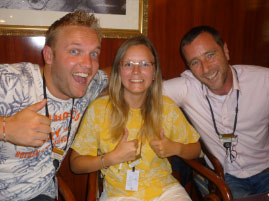
Cruise Directors |
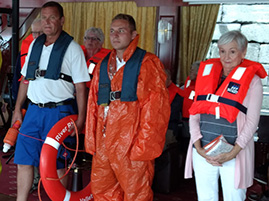
Safety Drill |
Next is Belgium beer time in the lounge while we listen to the Port Talk entitled “Legalized Prostitution in Antwerp.” Paula (real name Nada) works in the trade and shares her experiences in a most open, brave way. She’s 55 and survived the Serbian war. She landed in Antwerp as a refugee and survived again by becoming a successful “lady of the night.” She likes to sew, cook and make earrings. She adores her dog and has a 20-year relationship. She is very honest about her occupation. We learn about the red-light district, safety, men and their needs, etc. After the talk, I felt compelled to hug her – and she hugged back.
Dinner is a 7. We sit by Enrique and Elsa from New York City. They are celebrating their 60th wedding anniversary and shared a bottle of nice champagne with us. I didn’t really want it, but couldn’t say no. Didn’t sleep well – too much wine and champagne.
Wednesday, August 16, 2017
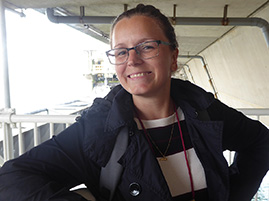
Paulina |
Breakfast buffet is everything you could ever want – or need. One thing is certain; I need to pace myself during this trip. We get to know our Program Director, Paulina. She is in charge of our “Yellow” team. She steals our hearts. She is funny, caring, open, energetic, smart and has so much to teach us. She takes us on a walking tour of Antwerp, her hometown, when she is not leading tours.
Antwerp is Belgium’s major port and has been commercially important in European trade since the eleventh century. This once grand city, dating from the 16th century, suffered great damage during both World Wars. In spite of being a little tattered, it remains a city of beautiful historic architecture.
Our morning tour is packed. We leave the boat and walk along the river’s edge on a cobblestone path. It once was an eloquent path where lacey roofing tin left from the 18th century covers the walkway.
Not far from the boat is an underground tunnel (Saint Anna Tunnel) with wooden escalators that connect to the other side of the river (left bank). It was built in 1933 and came in very handy during WW II. The locals use it for their daily commute. We didn’t explore it – too much to see above ground.
There is also a bridge built for a promenade – where young ladies and gentlemen could stroll in hopes of “hooking up.” However, this promenade/bridge goes only halfway across the river.
Pauline points out the blending of the modern buildings mixed in with the old – due to heavy bombings from WWII. (Luckily, the Old Customs House is still standing, a tribute to Antwerp’s grandeur.
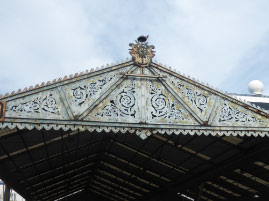
Saint Anna Tunnel |
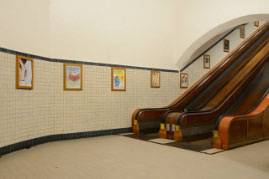
Saint Anna Tunnel |
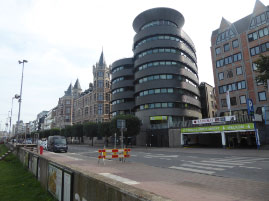
Antwerp |
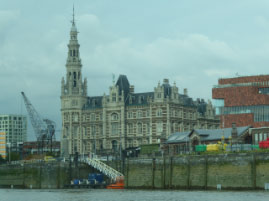
Antwerp |
A castle built on the river’s edge, partially destroyed by the bombings, keeps morphing into different uses. The statue was added in 1963. It represents legendary evil giant named Lange Wapper who is said to have terrorized the city through the ages. Here he is annoying two townsfolk, who had too much to drink. (Paulina tells us that the term “shit faced” came from Belgium because drunks coming home after a late night faced the possibility of by being doused by the neighbors tossing out the contents of their chamber pots.)
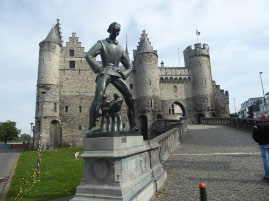
Medieval Castle Het Steen |
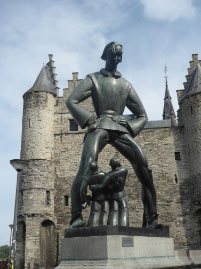
Lange Wapper |
We leave the river walkway and head into the town. We see sections of the old Roman wall still standing. We pass by the Bacon House built in 1504 as the meeting hall for the butcher’s guild. Pretty clever that the layers of white stones and red bricks make it resemble stacks of bacon. Overhead, we see Mother Mary, who is the town’s patron saint. The townspeople affixed statues of Mary on the outside of their buildings for protection them from the evil giant, Lange Wapper.
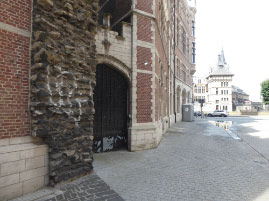
Antwerp |
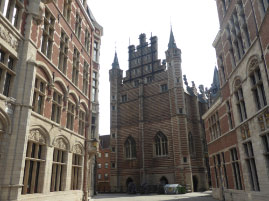
Antwerp |
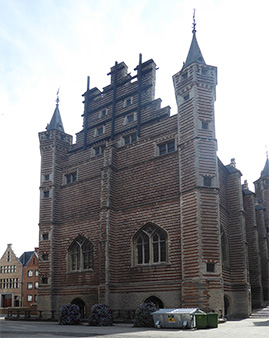
Antwerp |
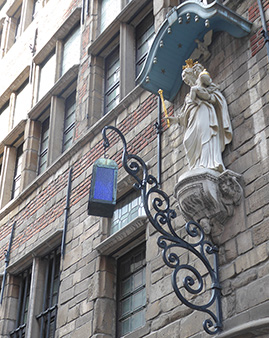
Antwerp |
The new housing, built to fill in the destruction from the bombs, mixes in nicely with the old. Much of the new housing is the government housing project (Belgium takes care of its people with housing, health coverage, education – and the people don’t mind paying high taxes for a nice quality of life for all.)
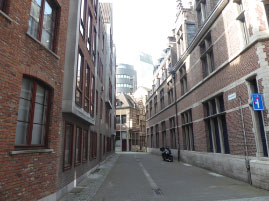
Antwerp |
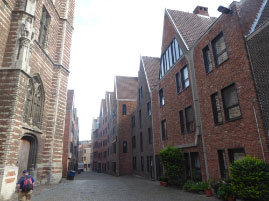
Antwerp |
We head to the city center and see the well-preserved Old Town, built around the Grote Markt (Town Square) and graced by the lovely old Town Hall and beautiful Guild Houses.
The guild houses played a big part in Antwerp’s development. Groups of merchants and tradesmen met in ornate buildings surrounding the main square. Each building is topped with golden statues signifying the business that the guild represented. They chose to build near City Hall because they wanted the close contact with the politicians to lobby for their own businesses. They must have been some of the world’s earliest lobbyists.
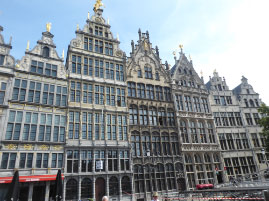
Antwerp |
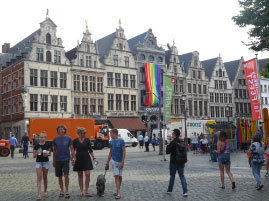
Antwerp |
The impressive Renaissance-style City Hall was built as a symbol of Antwerp’s power in the city’s golden age. However, by the time it was completed in 1565, time was running short for this prosperity. Ten years later Spain took over and ended the heyday. Lucky for us, the remarkable structures survived.
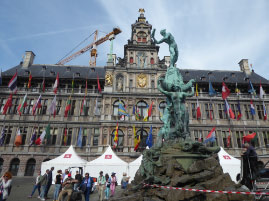
Antwerp |
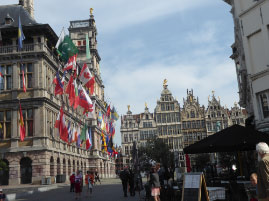
Antwerp |
A statue centered in the Town Square depicts Antigoon, Antwerp’s legendary giant. He charged a toll from anyone wishing to cross the river. If they refused, he cut off their hand. Finally, after years of this abuse, a young Roman soldier named Brabo stepped up, slayed the giant, then chopped off the giant’s hand and chucked it into the river. One minor details, the statue shows the young Roman throwing the hand in the wrong direction, away from the river. In any case, the “hand “became the symbol of Antwerp. You find it in all the souvenir shops – can even get hands made of chocolate.
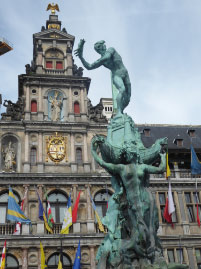
Antigoon |
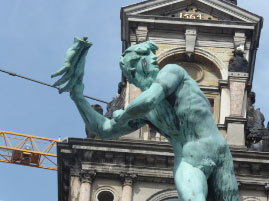
Antigoon |
One square over, we skirt around the Cathedral of Our Lady. It is difficult to photograph even though it has the tallest structure in the city (and will remain so by law). Construction began in 1352, and ended in 1521, but that one hundred and ninety years wasn’t long enough for the church to be officially completed. The church has been both Catholic and Protestant over the years – often suffering serious damage when it is in the process of converting from one to the other. It is closed so we only view the elegant spires of Cathedral of our Lady and the entryway. However, there is a Statue of the Apprentice outside – which fascinates me.
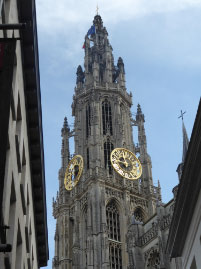
Antwerp |
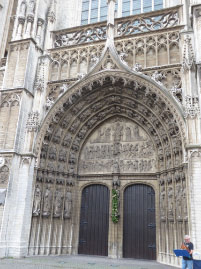
Antwerp |
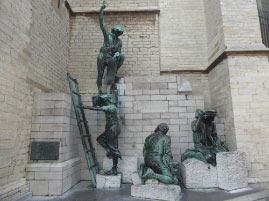
Antwerp |
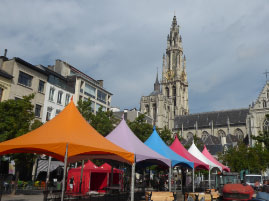
Antwerp |
Right off the square, Paulina shows us “Fritas” – Belgium’s fast food rage. (She doesn’t tempt us with these twice fried in animal oil covered with mayonnaise.)
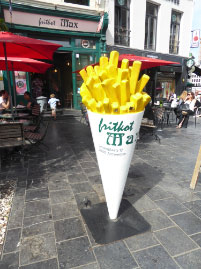
Antwerp |
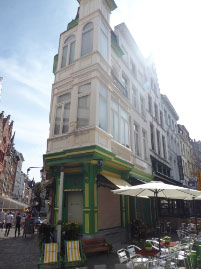
Antwerp |
After Pauline fills our brains with facts, it’s time to fill our bellies. The Yellow group disperses – many go back to the boat for a lavish lunch, we stay to soak up more of Antwerp. On Pauline’s recommendation, we have lunch at the “11th Commandment” – a funky place just off a side street of the Cathedral of Our Lady. By the way, the “11th Commandment” is “Thou shalt Drink Beer!” The old café is packed with crazy statues and paintings – most of which are very sacrilegious. It took a lot of time to order and get our lunch – but the beer was delightful
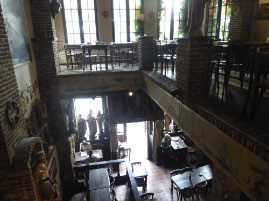
Antwerp |
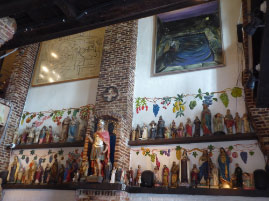
Antwerp |
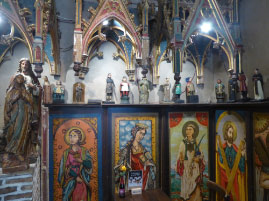
Antwerp |
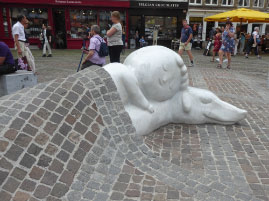
Antwerp |
Hot and tired, we find our way to the home of the great painter, Peter Paul Rubens. He bought the 16th-century house just off the Meir (shopping district) when he returned from Italy in 1608 and transformed it into one of the most elegant Renaissance-Baroque houses in the Low Countries. Rubens worked here and created many great works of art. We tour the rooms and some of his finest works and get an idea of how the master lived and worked. The gift shop was pretty nice, too.
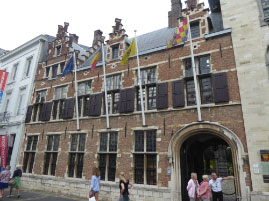
Rubens Home |
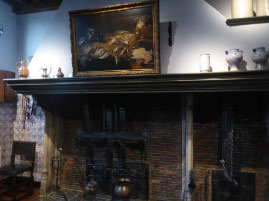
Rubens Home |
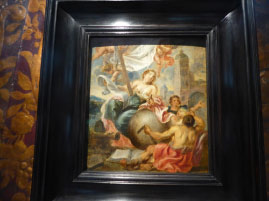
Rubens Home |
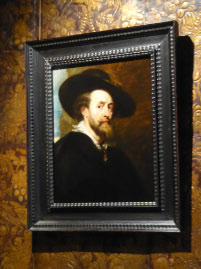
Rubens Home |
After Rubens’ house, we head back out along the Meir, the main shopping street. Among the sights, we see KBC, the first skyscraper in Europe.
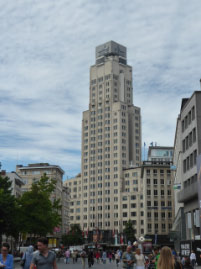
Antwerp |
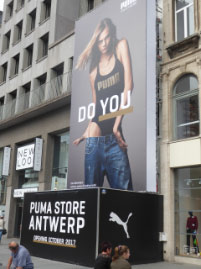
Antwerp |
We decide to make a fun, off the beaten path adventure for ourselves. Our goal is to find the Red Light district, where Nada, our new prostitute friend works. It wasn’t easy find the 2-block district because the tour book only gives clues where the district is located. Once in the general vicinity, it was a dead giveaway when I noticed several guys in the middle of the afternoon strolling along the sidewalks, checking out the windows. We make a B-line for the area and sure enough, Nada (in her sexy black, lacey bustier) wearing her black sequined cat mask, is in one of the windows waving frantically at us. She waves us in to show us her room (#5). We talk for almost an hour – a most fascinating talk – but then must dash off to catch our boat before it leaves Antwerp. I get a second wind on our mad dash to the ship – but no more time for exploring or we’ll miss the boat!
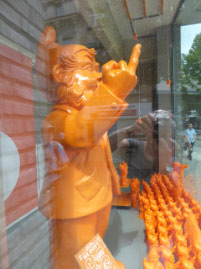
Nada's place |
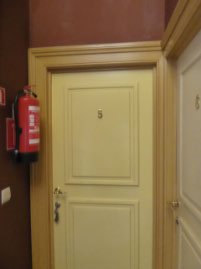
Nada's place |
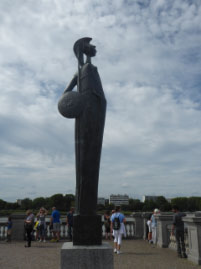
Back to the boat |
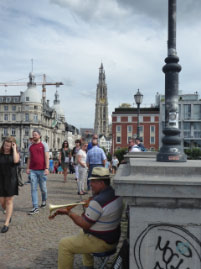
Back to the boat |
We arrive back at the boat in time for departure. We attend a most interesting discussion with a 25 year-old Muslim girl, Anissa, about Radicalization. She is beautiful, intelligent and wears a burka – which illicits anger, especially from the old white privileged guys on the boat. I hear brilliant comments like “why don’t you go back to where you came from.” Her answer was, “That would be a couple of blocks from here at the hospital where I was born.” I don’t get it – they weren’t angry with my prostitute friend. I come back to the room angry and ashamed to be associated in anyway with such limited thinking. (One thing is for sure – we’re not sitting next to the Iowa pig farmer anymore!)
Captain’s Welcome Cocktail Reception and dinner is delayed because our boat must wait to go through a lock – fun to experience the raising and falling of the boat.
At dinner, we join a couple from Virginia – they’re smart and fun – but against making ties with Cuba. (Guess we can’t sit with them again!)
NOTE: Pauline spent the afternoon and evening at the hospital worried about an appendix attack – but is declared well. She checks out of the hospital just in time to get back to the boat before we leave for Willemstad. Thank heavens, we have our fun, fearless leader!
Thursday, August 17, 2017
Our ship arrives in Dordrecht about 2:00 in the morning. We eat breakfast about 7:30 and then board a big OAT bus. We drive an hour to see the 19 windmills of Kinderdijk, built around 1740. These sturdy windmills were a rudimentary pumping system to keep the land behind the dykes dry. They are well-preserved, and in 1997 were became a UNESCO World Heritage Site.
In spite of the rain, we enjoy our visit. Elsa, the fun loving local and canal boat driver, keeps us entertained with her jokes as she drops us off at various stops along the canal. In 2014 Grand Circle made one of the windmills a working museum. It’s here where another village friendly soul, Miller Aard, shows us how to stop the windmill, add sails and put down the wall or trench blocking the water to the canal. I try to take the perfect photos -- but the grey, wet weather puts a damper on that. Here’s the best I could do.
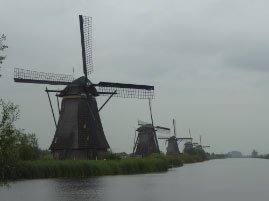
Windmills of Kinderdijk |
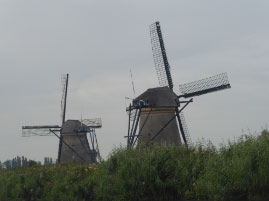
Windmills of Kinderdijk |
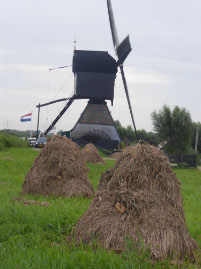
Windmills of Kinderdijk |
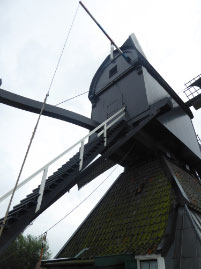
Windmills of Kinderdijk |
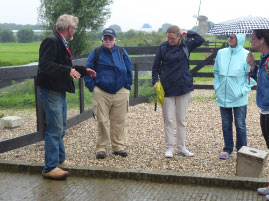
Windmills of Kinderdijk |
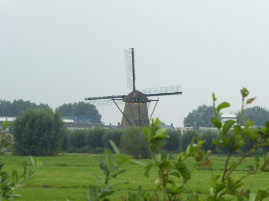
Windmills of Kinderdijk |
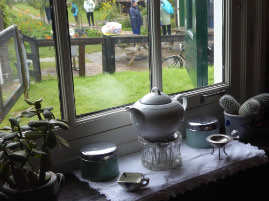
Windmills of Kinderdijk |
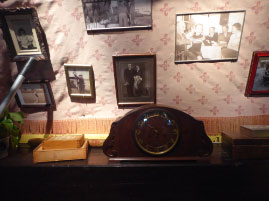
Windmills of Kinderdijk |
The bus takes us back at the ship when we change into dry clothes and have a lovely lunch.
We leave at 1:30 pm for a 1 ½ hour bus ride to see the Delta Works Flood Control project. It’s a hydro-engineering restoration project and well known as an engineering miracle.
Before the late 1980’s, the inhabitants of Zeeland lived on a collection of islands in Holland’s southwestern province. Constantly battered by the sea, it took the devastating storm of 1953 that claimed the lives of 1,800 people to do something about fixing the dyke system once and for all. The gigantic Delta Works flood control project did just that. They moved heaven and earth to shorten the Dutch coastline in order to reduce the number of dikes that had to be raised. The project cost $8.2 billion in the 1980’s – and finished on time and on budget!
We are blown away by the ingenious technical achievements designed over the past 64 years. A gargantuan series of dams, dikes, and bridges connect and protect the islands and can be manipulated to serve as storm surge barriers. We have a delightful guide who takes us into the bowels of one of the damn structures. The engineers had to come up with a design never used before – and one that could be built. They also had to build and design equipment and tools needed to install it all the while protecting the environment.
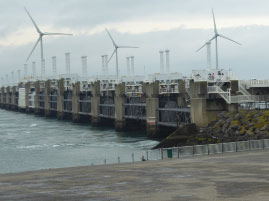
Delta Works |
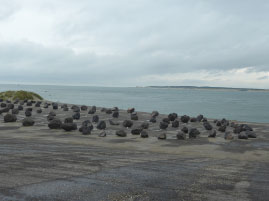
Delta Works |
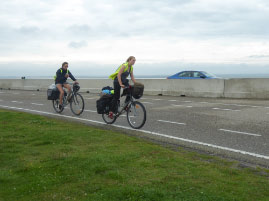
Delta Works |
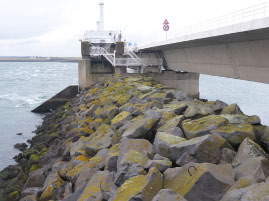
Delta Works |
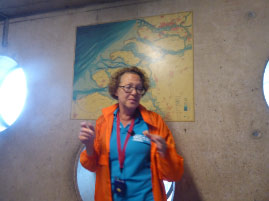
Delta Works |
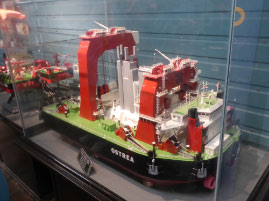
Delta Works |
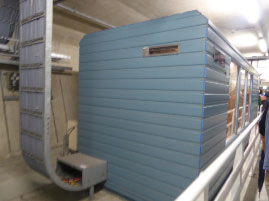
Delta Works |
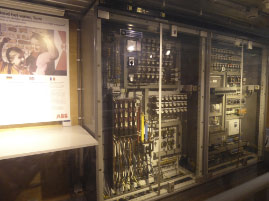
Delta Works |
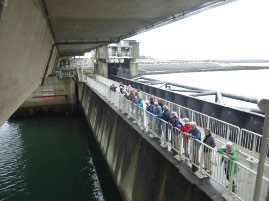
Delta Works |
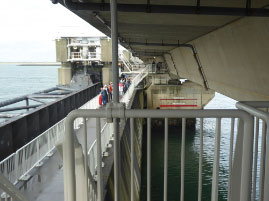
Delta Works |
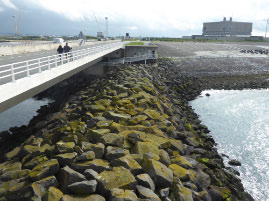
Delta Works |
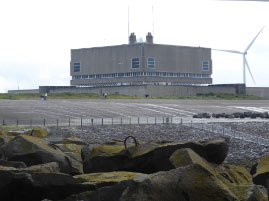
Delta Works |
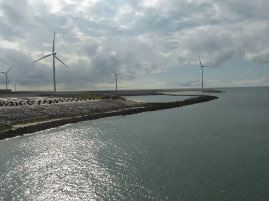
Delta Works |
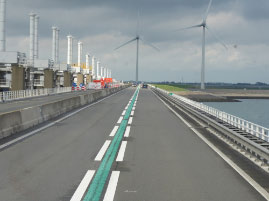
Delta Works |
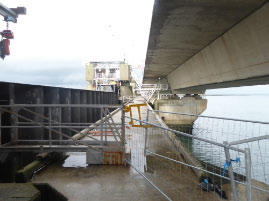
Delta Works |
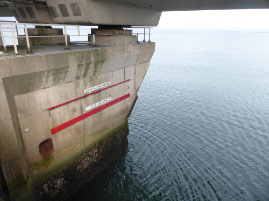
Delta Works |
Holland is all about fighting Mother Nature to keep the land. 20% of the country is below sea level. They proved that they could claim, reclaim, and protect their homeland from the threat of the sea. This is the place where New Orleans and Houston could learn some lessons!
We have a long bus ride back in the rain. The bus driver makes several amazing maneuvers on the little, muddy village roads. Paulina gives her usual interesting talk so we travelers don’t even notice the peril we are in.
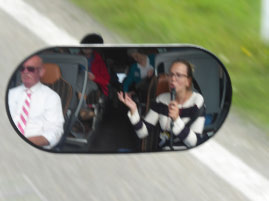
Back to the boat |
We arrive at the ship at 7, just in time for dinner. I pick the table with Enrique and Elsa. After dinner, we have “Live Music” with Krassy, a pianist who knows all the heartwarming songs from the “baby boomer” generations. (He was the audience in the palm of his Eastern European hand!)
Friday, August 18, 2017
After breakfast, we take a walking tour of 2,000-year-old Nijmegen, Netherlands’ oldest city. Located in the eastern part of the country near the German border, Nijmegen was built on seven hills overlooking the Waal River near its confluence with the Rhine. (Paulina claims it’s the only hill in Holland!)
Site of an important battle during World War II, the surrounding city was heavily damaged and almost completely rebuilt. However, the town center was remarkably unscathed. We see the new buildings post WWII on the way into the town. Just inside the city wall is mostly old buildings.
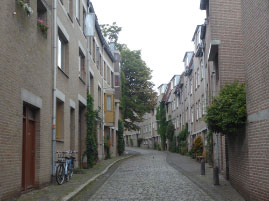
Nijmegen |
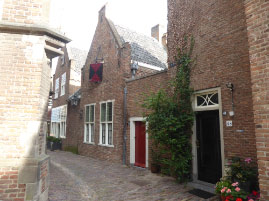
Nijmegen |
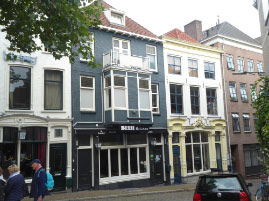
Nijmegen |
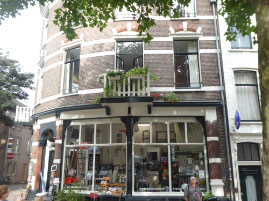
Nijmegen |
Paulina is delightful showing us the town and things that tweak her interest – like the sleek, baby carriage attached to a bicycle. (She and her hubby want a baby and probably will start trying after this cruise.)
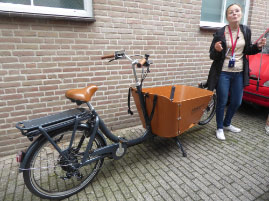
Baby Carriage |
She also points out the once strong Jewish community. Now there are reminders and tributes to the horrors they faced.
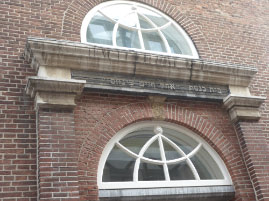
Nijmegen |
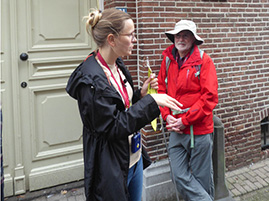
Nijmegen |
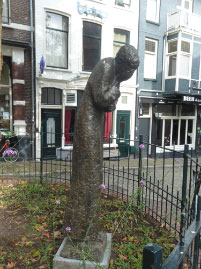
Nijmegen |
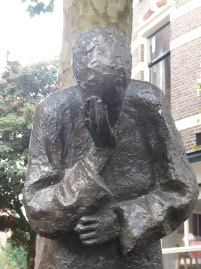
Nijmegen |
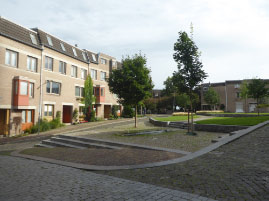
Nijmegen |
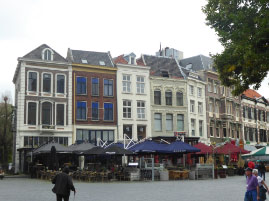
Nijmegen |
The town center is charming – and remains intact with guild houses, interesting architecture and statues. Just off the main town square, some of us (not me) taste herring like a real Dutchie!
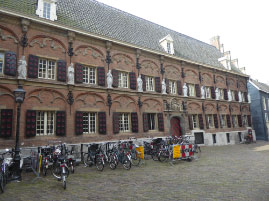
Nijmegen |
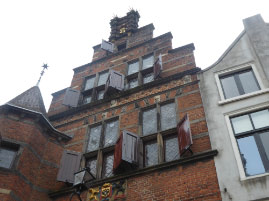
Nijmegen |
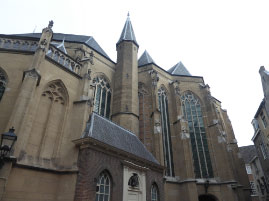
Nijmegen |
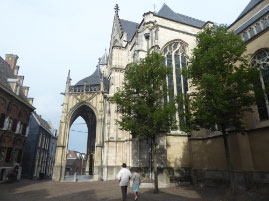
Nijmegen |
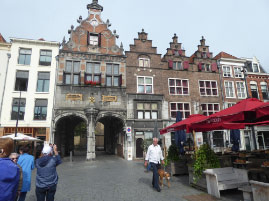
Nijmegen |
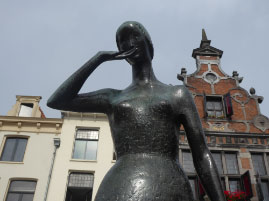
Nijmegen |
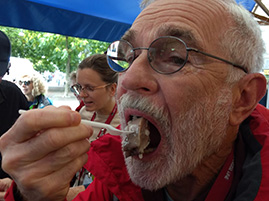
Nijmengen |
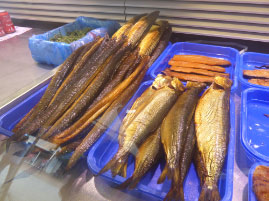
Nijmengen |
We meander back to the ship for lunch, and then set sail. Part of our meandering took us through historic Valkhof Park which has 2000 years of history, from the Romans to Charlemagne through the middle ages, Nazi's and nowadays. Charlemagne would rest here when traveling through his immense empire. Around 1155, Emperor Barbarossa had a castle here for protection. This was the view from the castle, if the castle still existed.
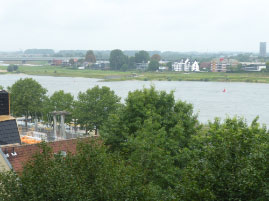
Valkhof Park |
At noon, Maarten, a local historian tells us Operation Market Garden -- an unsuccessful Allied military attempt fought in the Netherlands and Germany during September 17 – 25, 1944. The 1977 hit movie, “A Bridge Too Far’’ tells the dramatic story. The plan was to catch the Germans off guard and capture nine key bridges over the Rhine. The Allies needed the bridges to move troops and supplies to attack Northern Germany from the Netherlands. The mission was a major setback and delayed the Allies’ dream of ending the war by Christmas. It took another year and a half of fierce fighting until Germany was finally defeated in Remagen, Oppenheim, Rees and Wesel
Maarten, our lecturer, was a child of 6, when he witnessed the grueling battle fought here in Nijmegen. He saw the sky full of Allied paratroopers and the river filled with soldiers in small boats trying to cross the river to capture the Germans. He watched the Germans perched high on the German banks picking off soldiers like shooting ducks in an arcade. However, the allies saved the bridge spanning the River Waal. It was chilling to me to hear his stories while we sit in the lounge with a clear view of that very bridge outside.
Maarten’s stories shed a new light on this trip and broadened my perspective on how much the American / Allied troops gave and how much respect they gained. I am revisiting those heroic, tragic times by watching the war clips of WWII on my Kindle. I see the very cities we are visiting about 70 years earlier packed with tanks and artillery and soldiers. Thank you Maarten for expanding my limited experiences.
Note to WWII Buffs: YouTube has a clear, 7-minute explanation of the Operation Market Garden - www.youtube.com/watch?v=EejtTsIeLHU
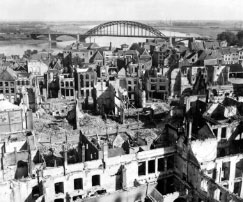
Nijmegen after WWII Battle |
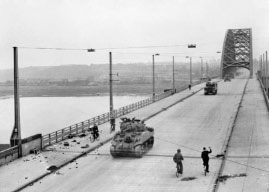
British cross the bridge after battle |
At 4 pm, we take a tour of the galley with Chef Martin. Amazing how tiny that little kitchen is – and what they are able to turn out! Everyone loves Chef Martin!
Later we enjoy another remarkable dinner and then have German language lesson afterwards. (I am so bad at languages! – Wunderbar.)
Saturday, August 19, 2017
After breakfast, we “do” Bonn – the former capital of West Germany, our first stop in Germany. Paulina leads us along an ancient Roman wall that hugs the Rhine River. Bonn was founded in the first century BC as a Roman settlement – one of many settlements along the Rhine. Things that Romans built last forever!
We turn inland from the river to see the town. We stop at the University of Bonn, a massive university complex to meet Lena, a German student. Her talk only lasts about 20 minutes, but it is the most boring talk ever. A few members of our group kept asking her questions that nobody cared about.
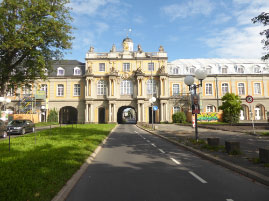
University of Bonn |
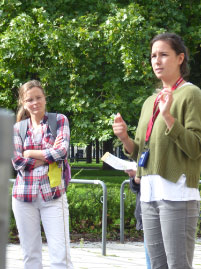
Lena at University of Bonn |
We finally say good-bye to Lena and head off to the large central square that include a statue of Beethoven standing in front of a beautiful post office (that once was a former palace). This is the hometown of Ludwig van Beethoven and his statues are scattered everywhere.
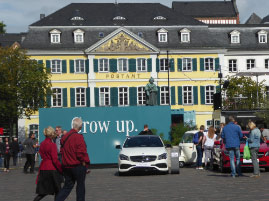
Bonn Central Square |
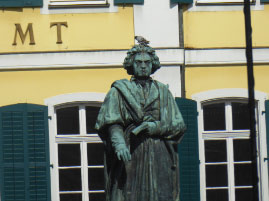
Ludwig van Beethoven |
On another side of the square stands a Roman Catholic Church (called by many different names to make things confusing – Munster / Cathedral?). It is one of Germany's oldest churches, built in 1248 during the transition from Romanticism to Gothic period -- the same year the construction for Cologne Cathedral started. They were building cathedrals like crazy back when the church was crazy rich. Some claim the history of the place really goes back to 235 AD when two Christian Roman soldiers, Cassius and Florentius, were martyred for their faith. Two large statues of their heads lay strewn in outside the church – made me wonder why – so that’s why you got this extra detail.
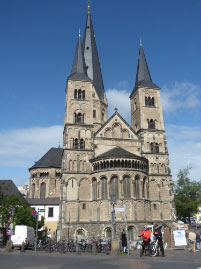
Bonn Minster |
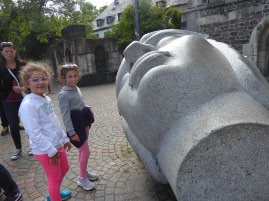
Statue of Head |
We stroll through the shopping district. Paulina wants us to see Beate Uhse sex shop – a legitimate establishment that draws plenty of customers. See why we like Paulina so much!?!
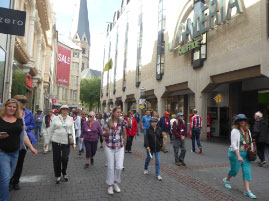
Bonn Shopping District |
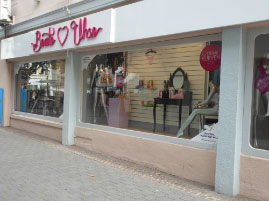
Beate Uhse sex shop |
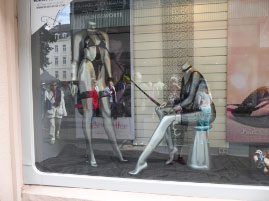
Beate Uhse sex shop |
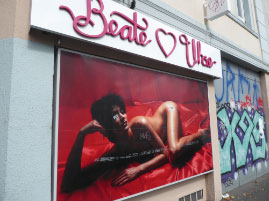
Beate Uhse sex shop |
In the old town, we see the Baroque City Hall. Check out the clever numbering on the clock – I forgot how the time-telling system works. The courtyard in front of city hall has titles of famous books scattered about the stepping stones. I think the design is because books were once burned here – probably by Hitler’s gang.
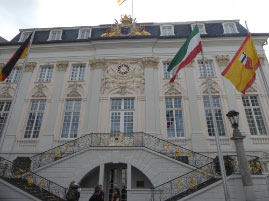
Bonn City Hall |
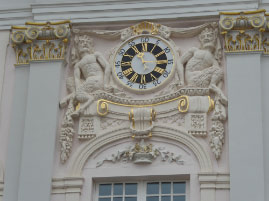
Bonn City Hall |
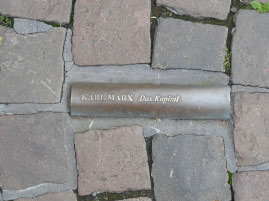
Books on stepping stones |
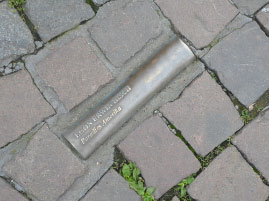
Books on stepping stones |
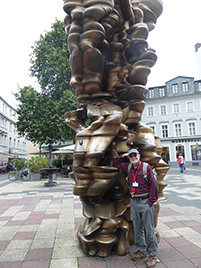
Bonn Old Town |
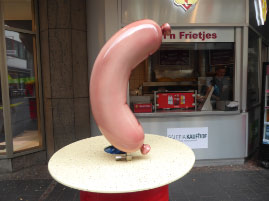
Bonn Old Town |
Our morning walking tour ends and we’re on our own for afternoon entertainment. We find the Bonn train station and grab a 30-minute train ride to Cologne. The Cologne Cathedral is directly across from the train station.
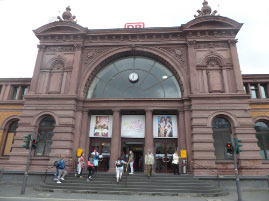
Bonn Hauptbahnhof |
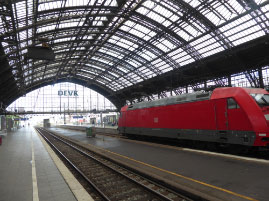
Bonn Hauptbahnhof |
We ogle at the magnificent spirals and doorways on the cathedral’s exterior. (I was in Cologne on a business trip years ago and couldn’t wait to see the cathedral again – I wasn’t disappointed.)
Cool sidewalk chalk drawings distract us from the church long enough for us to decide we were hungry and need lunch. Bill finds a wonderful old place that has specialized in brats and sour kraut for centuries. It hits the spot.
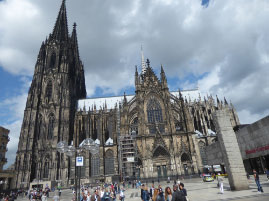
Cologne Cathedral |
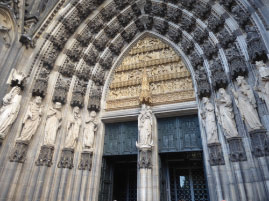
Cologne Cathedral |
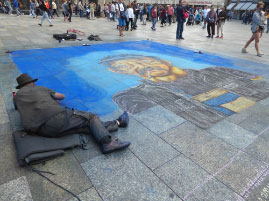
Sidewalk chalk drawings |
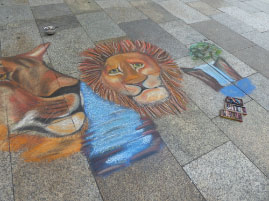
Sidewalk chalk drawings |
After lunch we return to explore the inside of the church. We decide to book a tour. The guide is very knowledgeable, but we are very tired. I try to retain the information – but end up getting hopelessly lost from the group. Here are some of my wowie-zowie shots of the interior.
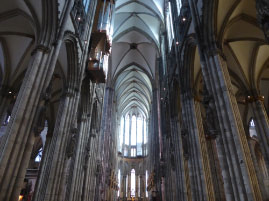
Cologne Cathedral |
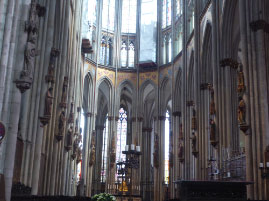
Cologne Cathedral |
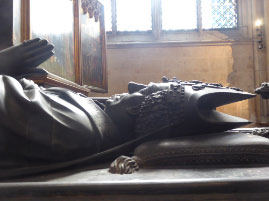
Cologne Cathedral |
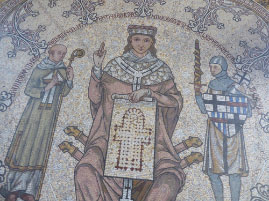
Cologne Cathedral |
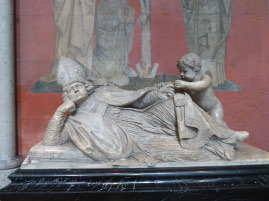
Cologne Cathedral |
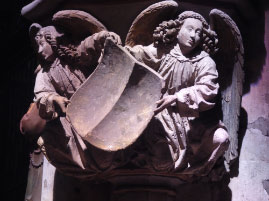
Cologne Cathedral |
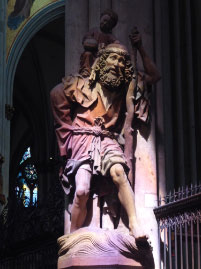
Cologne Cathedral |
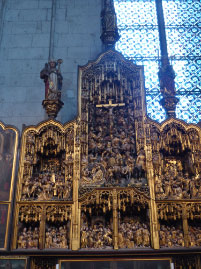
Cologne Cathedral |
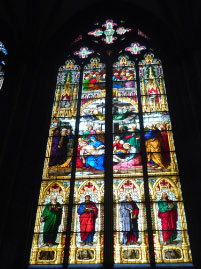
Cologne Cathedral |
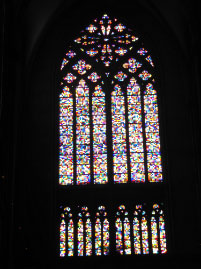
Cologne Cathedral |
After a couple of hours, we catch a train back to Bonn – however we catch the wrong train going the wrong direction. We are able to correct our mistake quickly, but with an added a layer of stress. In no time, we arrive back in the heart of Bonn.
From the train station in Bonn, we should have gone back to the ship after our PACKED day, but no, I have to see Beethoven’s birthplace. It’s a lovely home with nice gardens. The last tour was over so we amble around the house aimlessly trying to make sense of the authentic documents and objects that Beethoven fans would kill to see.
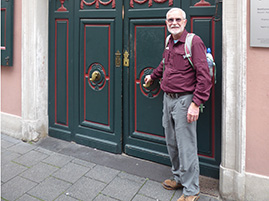
Beethoven’s birthplace |
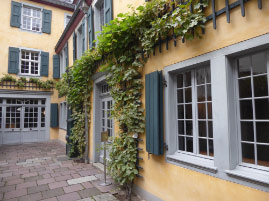
Beethoven’s birthplace |
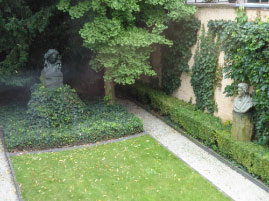
Beethoven’s birthplace |
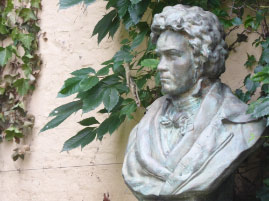
Beethoven’s birthplace |
We finally walk back to the ship. We relax and then have another huge dinner at 7, just as we set sail for Cochem.
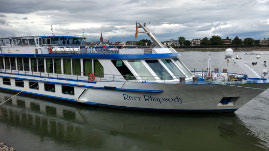
Back to the ship |
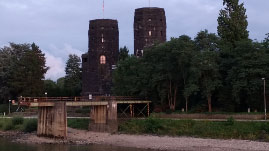
Good bye Bonn |
Sunday, August 20, 2017 - Cochem
Ah, it’s great to wake up on the narrow Mosel River and see farmlands, vineyards, and the quaint town of Cochem with a “Sleeping Beauty” castle perched above it all. Cochem, about halfway down the Mosel River from Koblenz, is a medieval riverside town surrounded by vineyards.
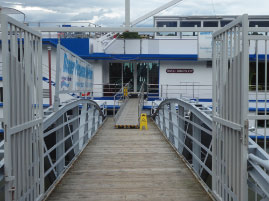
Hello Cochem |
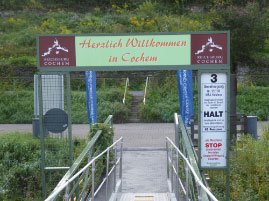
Hello Cochem |
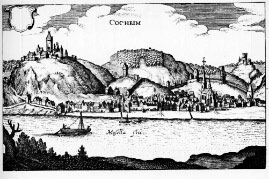
Cochem 1646 |
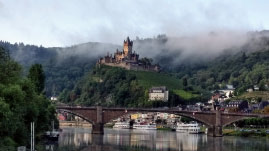
“Sleeping Beauty” castle |
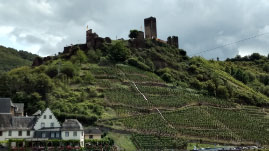
Cochem |
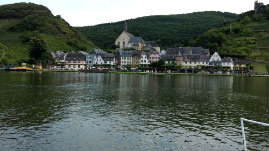
Cochem |
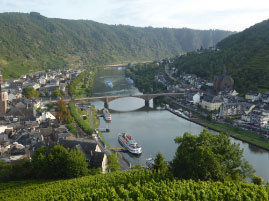
Cochem |
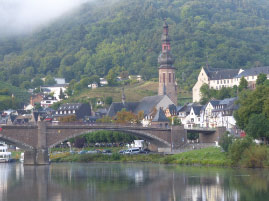
Cochem |
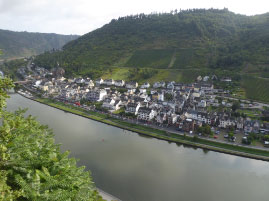
Cochem |
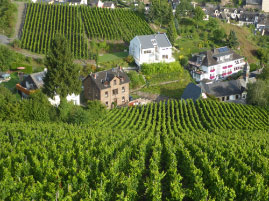
Cochem |
We start the day by driving up a steep hill to the Reichsburg Castle, constructed in the 11th century. The views of the town below are gorgeous. In 1151 King Konrad III, who live in the castle, declared it an Imperial castle. It was burned to the ground by King Louis XIV of France in 1689 during the War of the Palatine Succession. The castle lay in ruins until 1868 when it was purchased by Louis Ravene. He was an entrepreneur from Berlin and made a fortune in the steel industry. He picked it up for about $300,000 (a steal) turned it into a luxurious summer home for his family. Unfortunately, he died of cancer a few years later. Sad to say, after his cancer diagnosis, his wife left him for a younger man (23 years younger) and they had 6 or 7 kids together -- scandalous.
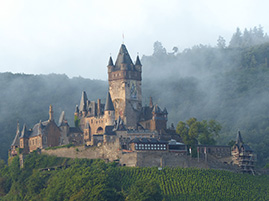
Reichsburg Castle |
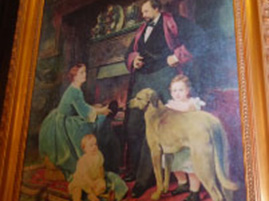
Reichsburg Castle |
In 1942, the Ravene heirs were forced to sell their castle to the Nazi government who used it for a training center for lawyers. Since 1978, the City of Cochem has owned the castle. They opened it up to the public – what a good thing to share it with the people.
Our guide was a darling young German girl. She did very well managing our rather large group. She led us through seven or so beautiful rooms with great views and several secret passages. Amazing collections of antiques got our attention – shining armor uniforms (for Knights), 3 legged stools (designed to help the Knights navigating in their armor), antlers on the wall, weaponry of all ages (guns, spears, knives), decorative horns (for drinking wine), paintings (portraits and scenery), dining tables, carved hutches, and my favorite thing to do, rub the tummy of a carved light fixture to have your wish come true.
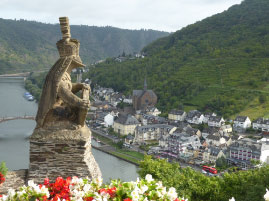
Reichsburg Castle |
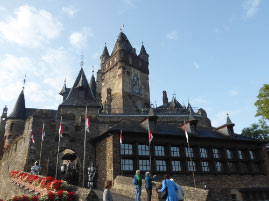
Reichsburg Castle |
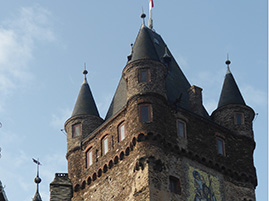
Reichsburg Castle |
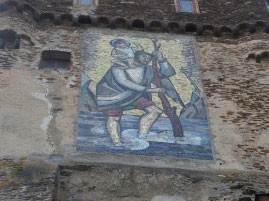
Reichsburg Castle |
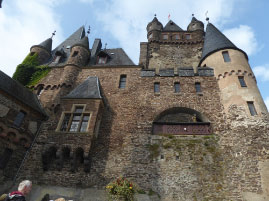
Reichsburg Castle |
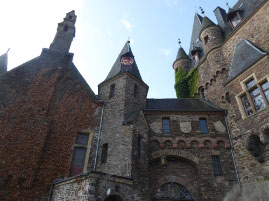
Reichsburg Castle |
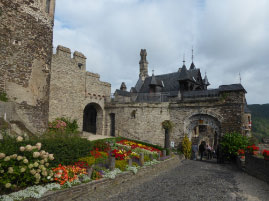
Reichsburg Castle |
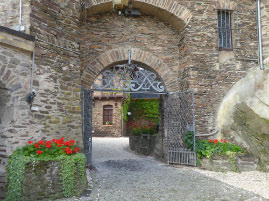
Reichsburg Castle |
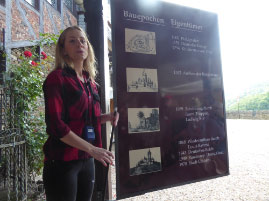
Reichsburg Castle |
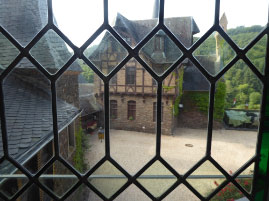
Reichsburg Castle |
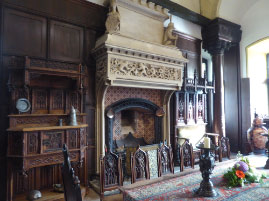
Reichsburg Castle |
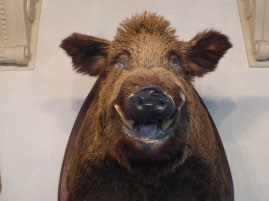
Reichsburg Castle |
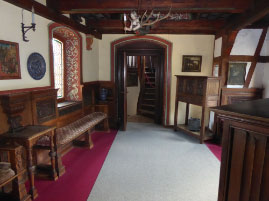
Reichsburg Castle |
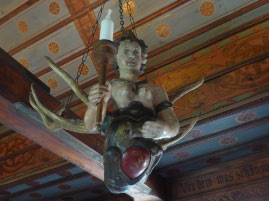
Reichsburg Castle |
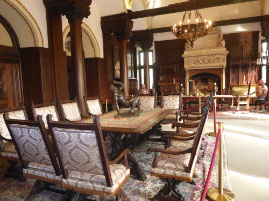
Reichsburg Castle |
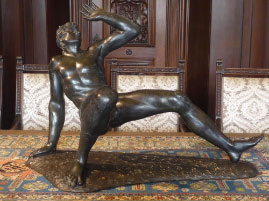
Reichsburg Castle |
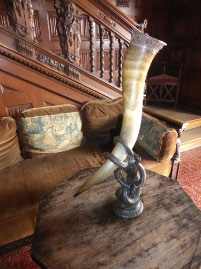
Reichsburg Castle |
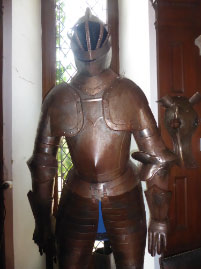
Reichsburg Castle |
We take the bus down the hill to Cochem where Paulina takes us on a walking tour of the town. We walk by a large cemetery outside the town that honors German soldiers who were killed in World War I and World War II.
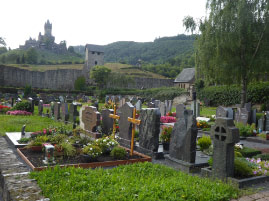
Cochem Cemetery |
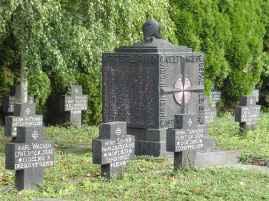
Cochem Cemetery |
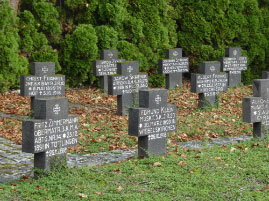
Cochem Cemetery |
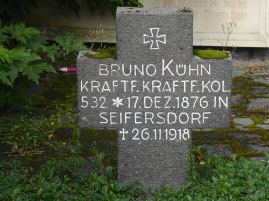
Cochem Cemetery |
Cochem is delightful with its narrow lanes with half-timbered houses and medieval gates. Surprisingly, the city’s wall has survived, including three of four 14th-century gates – built when Cochem was an Imperial Estate. We were charmed by the marketplace with its Baroque town hall dating from 1739. The bombings from WW II were kind to Cochem and spared most of the half-timbered houses with few repairs necessary. The town is well known for its mustard and has the old mustard factory in Europe. Although the town casts that fantasy – perfect Disneyland feel, it is the real deal!
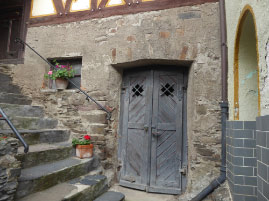
Cochem |
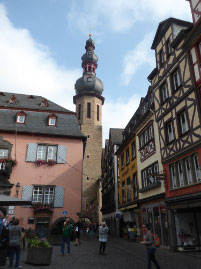
Cochem |
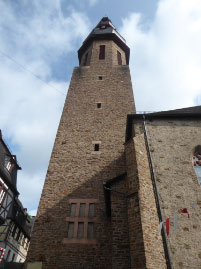
Cochem |

Cochem |
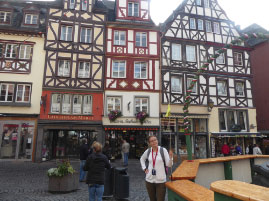
Cochem |
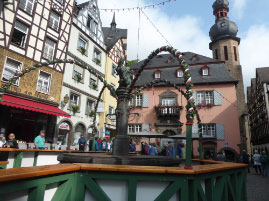
Cochem |
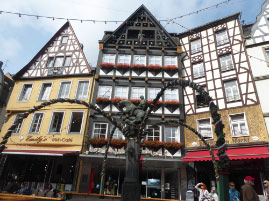
Cochem |
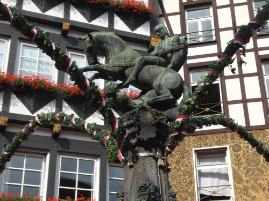
Cochem |
Paulina adds to our understanding of how businesses in this part of Germany formed close ties with the Nazi regime did very well – and still do.
We all know about the famous clothing label “BOSS.” Hugo Boss started his fashion business in 1924 in Metzingen, Germany, a small town south of Stuttgart, where it is still based. In 1931, Hugo became a member of the Nazi Party, which served his business very well. His sales greatly increased and in 1932, the Hugo Boss company designed and produced the black uniforms for the SS.
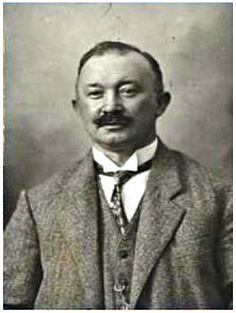
Hugo Boss |
The company used slave labor from 1942 to 1945. They forced Jewish people from concentration camps and French prisoners of war to work in the factories and live in barracks where there were lice and fleas. The labor force was worked to death or eventually sent to Auschwitz and Buchenwald to be killed.
After the war, in a 1946 judgement, Boss was stripped of his voting rights and his business, and fined a very heavy penalty. He appealed and won a lesser sentence. He died in 1948, but his business survived. It went public in 1988. In 2011, the company issued a statement of "profound regret to those who suffered harm or hardship at the factory run by Hugo Boss under National Socialist rule." Now Boss is a major global fashion house with more than 1,100 company-owned retail stores worldwide. (Life isn’t fair.)
The Coca-Cola Company also ended up benefitting from the war. When the Nazis came to power in 1933, Coca-Cola’s business in Germany was booming under the leadership of a man named Max Keith. However, later that year, profits were hurt when the Nazi government began to limit imports from foreign nations, including Coca-Cola syrup. In any case, the president of the Coca-Cola Company convinced Hermann Göring, Hitler’s second in command, to allow the importation of this syrup.
In 1940, as World War II progressed, Keith began to worry about import restrictions and developed a new syrup from local ingredients to be used if they could not get access to the official Coca-Cola syrup from America.
They called the new drink Fanta (from the German word “fantasie” for “imagination” ) and came up with new soda dubbed “Fanta.” When the United States entered the war in 1941, all official contact was severed between Keith’s German affiliate and the larger Coca-Cola Company.
When the German branch had entirely run out of Coca-Cola, the company began selling Fanta, which was a smash hit among the Germans. After the war, the Coca-Cola Company took back control of their German branch. Max Keith was ousted by the occupying U.S. military as Nazi collaborator.
Paulina takes the group for some famous Curry wurst taste testing. We like is OK – I think you have to grow up with it. Bill and I have a little lunch at a café, then join the group to take a bike ride along the most beautiful bike path we’ve ever seen. Many of our Grand Circle biking mates haven’t biked in years – and caused a few crashes. Luckily we were at the front of the group and avoided the disasters. Our group took a ferry to the precious little town of Beilstein where we took a break. Bill and I climbed to the top of the town for some terrific views.
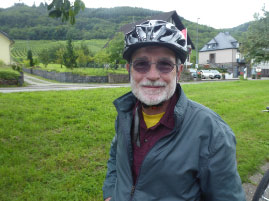
Beilstein |
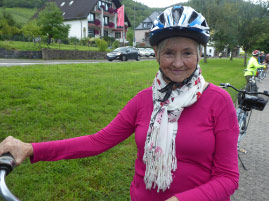
Beilstein |
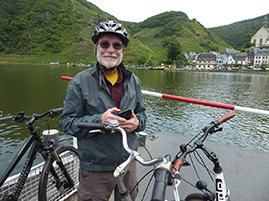
Beilstein |
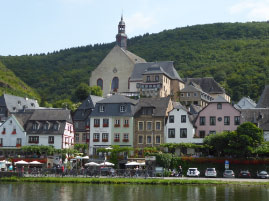
Beilstein |
We return our bikes to Cochem and then return to the ship. Our sweetheart captain gives a nautical talk before dinner – Everyone is crazy about him.
Monday, August 21, 2017 - Trier
We listen to a lecture on the European Union by a professor named Wolfe Something. He is very knowledgeable and his accent is not bad, but I only manage to gleam a few “ah ha’s” from the talk.
Ah Ha #1 – It might just be a good thing that Britain left the EU. They held all the power and made demands that were only good for Britain so good riddance.
Ah Ha #2 – EU is an Economic Federation that allows for free flow and goods and people among the members. (This is one of the main reasons Britain voted to exit because they wanted nothing to do with the Syrian refuges.)
Bill, with his economics background, gets a lot out of the talk and I come away with a shifted perspective and a few ah ha’s.
After the talk, we take a walking tour of Trier, the oldest city in Germany. Settlements were first established here during in fourth century B.C. In 15 BC, the Roman Emperor Augustus found a thriving city to rule all of the Roman Empire west of Rome- (roughly Germany, France, Spain and England in today’s maps). The ruins are magnificent and our local guide was passionate about her city.
She first takes us to the Porta Nigra (Black Gate), a towering gateway built around 200 AD and the largest surviving city gate from Roman times. It’s a massive, 3 story high impenetrable structure that dominates the city and served not only as a means of protection, but also a symbol of power and strength. Later, Bill and I climb to the top for amazing views of the city. No one would ever (or could ever) destroy this gate – a tribute to the Roman’s engineering genius.
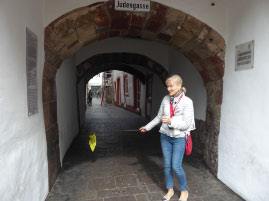
Trier Porta Nigra |
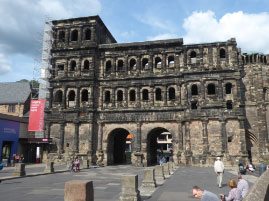
Trier Porta Nigra |
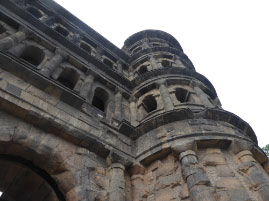
Trier Porta Nigra |
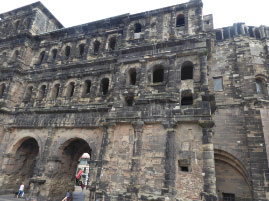
Trier Porta Nigra |
In the shadow of the Black Gate is the house where Karl Marx was born in 1818. His family moved to another house in Trier a year later. His birthplace still stands in Brückengasse 10 and has been converted into a museum (anyone can see it for a fee). Interesting to note, but not worth the time with bigger fish to fry in this amazing town.
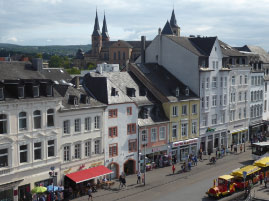
Karl Marx Birthplace |
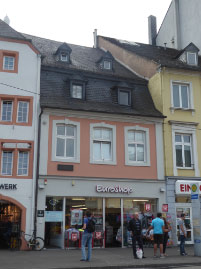
Karl Marx Birthplace |
On our way to the market square, Paulina points out a fascinating building -- The House of the Three Magi, built around 1230 even before the medieval city wall was completed. The house was occupied by a wealthy family. Back then, the main entrance to the house was located on the first floor and could only be reached by a ladder that could be pulled up to prevent unwelcome guests from entering.
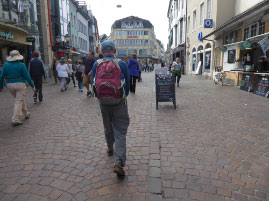
Trier Market Square |
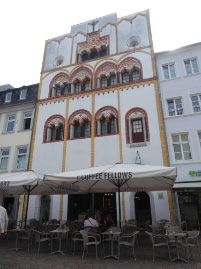
House of the Three Magi |
Our guide leads us to the center city and around a large, thriving market square. The well-preserved townhouses create a mixed of Renaissance, Baroque, and Classicist architecture. The tower of St. Gangolf’s church overlooks the square.
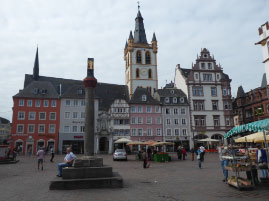
Trier Market Square |
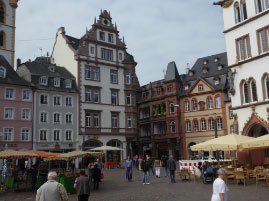
Trier Market Square |
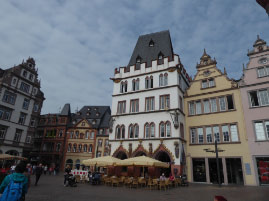
Trier Market Square |
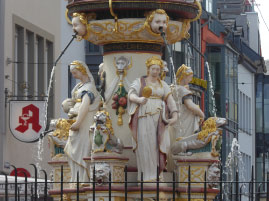
Trier Market Square |
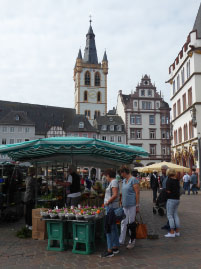
Trier Market Square |
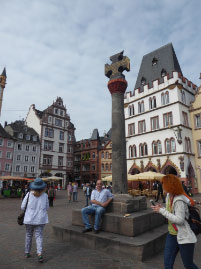
Trier Market Square |
Next we visit Aula Palatina, the Roman Emperor Constantine’s massive Basilica / Imperial Throne Room, erected in 310 AD. In the basilica, our guide shows us a picture of a statue head of Constantine and becomes very emotional about what a great man he was. He legalized Christianity in the Roman Empire in 312 AD and put the “holy” in the Holy Roman Empire. His mother, Helena, now a saint, allowed her palace in Trier to be used as the first church on this spot.
I have to take a minute to realize that we have stepped into history and are in the Roman Emperor Constantine's throne room where he held audience with his constituents. Emperors are always trying to impress and I'm certain that any of the Emperor’s subjects entering in during the Roman Empire would have felt very intimidated.
The "basilica" is now an evangelic Church. It is barren and spacious and gives one a sober, empty feeling when you enter the massive doors. In spite of the sparse walls in a great big room, the modern organ at the back knocks your socks off. This is a most Impressive building – the largest surviving single-room structure from Roman times and a Unesco World Heritage site.
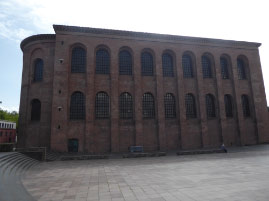
Aula Palatina |
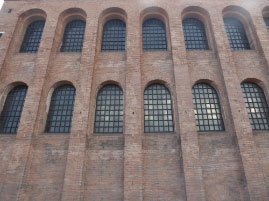
Aula Palatina |
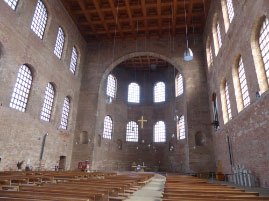
Aula Palatina |
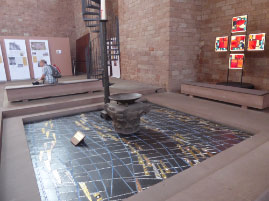
Aula Palatina |
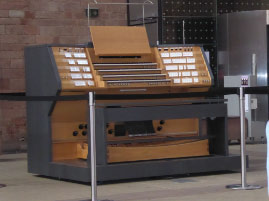
Aula Palatina |
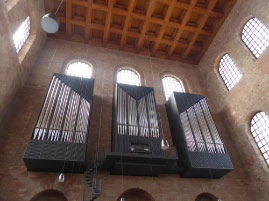
Aula Palatina |
Just around the corner from Constantine’s Basilica (and about 1500 years later), is Palace of Electors (Kurfurstliches Palais), a stunning and picturesque Rococo pink building surrounded by well-maintained beautiful gardens and open green lawns framed by graceful statues. (It reminded me of the palaces we saw in Russia – ornate and Romanesque.) It is considered one of the most beautiful rococo palaces in the world. The knock-your-socks-off staircase reveals the splendor of the Electors and Archbishops. Now local government employees use this staircase to get to their offices.
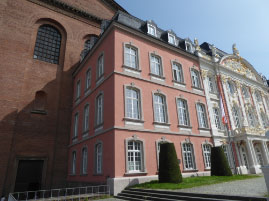
Palace of Electors |
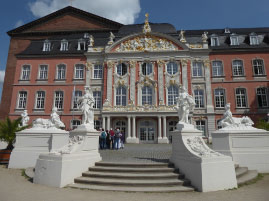
Palace of Electors |
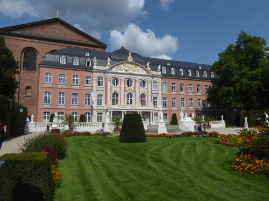
Palace of Electors |
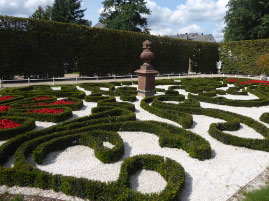
Palace of Electors |
We head back toward the market place to see two famous churches – Massive St. Peter's and with Church of our Lady, its smaller buddy right next door.
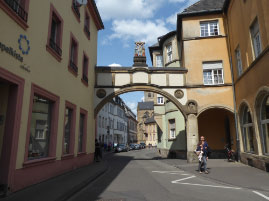
Trier |
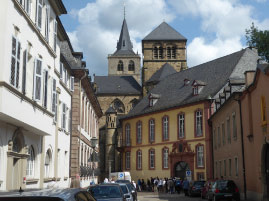
Church of our Lady and St. Peter's |
St. Peter’s Cathedral (Dom) is the oldest church in Germany. To celebrate the 20th anniversary of his reign in 326 AD, Constantine began the construction of two great churches – St. Peter’s in Rome and another St. Peter’s here in Trier. Lucky me, I visited them both!
The original cathedral in Trier was destroyed by fire and replaced. Later it was torn down by Constantine – and replaced once again. A baroque chapel was later added in the 18th century.
This beautiful Cathedral is tucked behind the marketplace. Once you turn a corner, you are taken y its sheer size. Right outside is a huge rock – just a bit of Roman scrap stone which was one part of a 60-ton ancient granite column once used as one of the four columns in the 4th Century Roman Church.
There are stunning statues, stain glass windows and in the Sanctuary of Christ’s Seamless Robe is where the most precious relic resides – the alleged Holy Robe of Christ, said to be found by St. Helena on a pilgrimage to Jerusalem. We found the sign, but couldn’t find the Sanctuary. Don’t think we missed anything –because the robe is rarely on display.
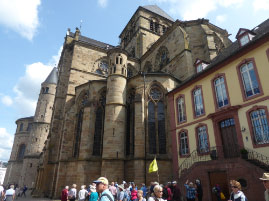
St. Peter’s Cathedral |
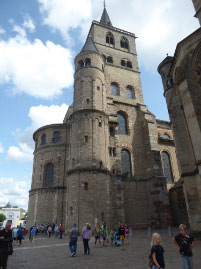
St. Peter’s Cathedral |
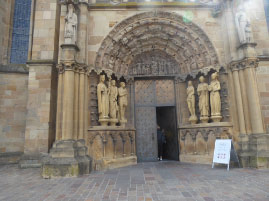
St. Peter’s Cathedral |
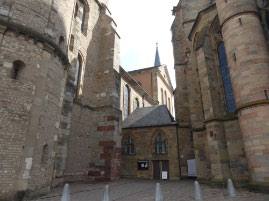
St. Peter’s Cathedral |
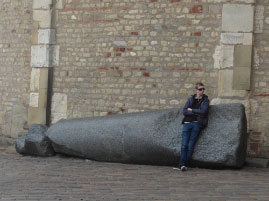
St. Peter’s Cathedral |
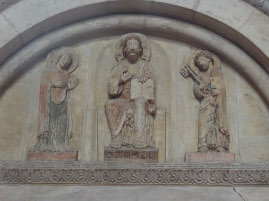
St. Peter’s Cathedral |
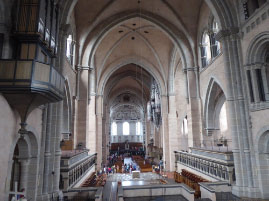
St. Peter’s Cathedral |
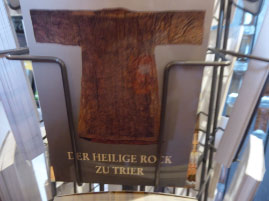
St. Peter’s Cathedral |
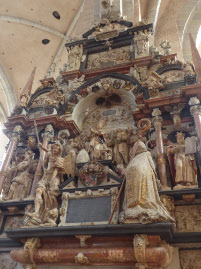
St. Peter’s Cathedral |
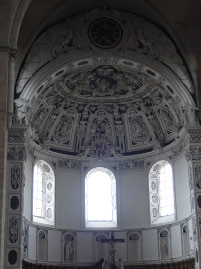
St. Peter’s Cathedral |
We couldn’t find the adjoining interior passageway to the Church of Our Lady, so we take the back exit into a peaceful garden surrounded by Cloisters between the Dom and the Church of Our Lady.
After a short stroll in the garden, we join the group for lunch on the square – took a while to be served, but was good. After lunch we say good-bye to our guide. Most of our colleagues go back to the boat for an afternoon snooze, but we push on because we don’t want to miss a thing, even though we’re a bit brain-dead and probably due for a nap.
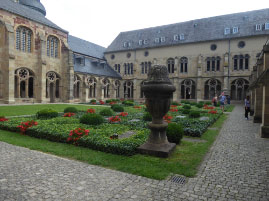
Church Garden |
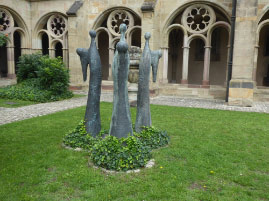
Church Garden |
After lunch we explore “Our Lady” dating from 1235 and the oldest Gothic church in Germany. French architects were brought in to do “Gothic” and paid with money from Cologne when the project went over budget. “Our Lady” is a total contrast to the massive “Dom” cathedral next door. She felt more like a church and was much more beautiful than her Cathedral neighbor next door. Her soaring stained glass windows are very impressive and create a lovely peaceful atmosphere. I snap a few photos without knowing the significance of the tombs or religious relics.
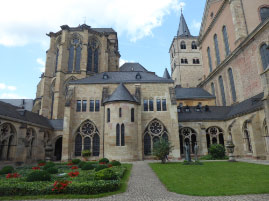
Church of Our Lady |
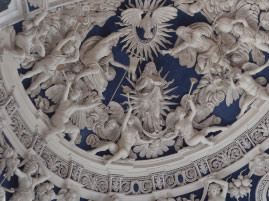
Church of Our Lady |
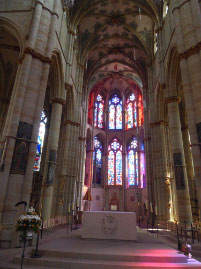
Church of Our Lady |
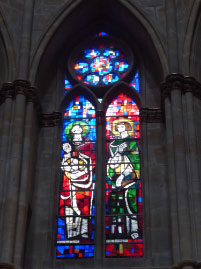
Church of Our Lady |
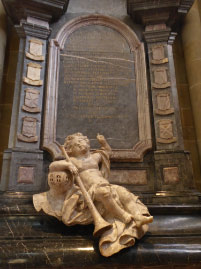
Church of Our Lady |
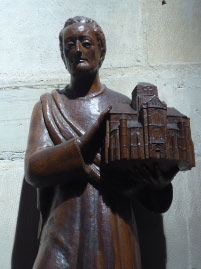
Church of Our Lady |
We “did” the churches and now off to the Roman ruins – some of the best-preserved from the area north of the Alps. Founded under Augustus in 16 B.C., its grandeur earned it the title Roma Secunda -- the second Rome. For nearly five centuries, well into the Christian era, Trier remained one of Europe's power centers.
We are blown away by the Imperial Baths. Once frequented by Constantine, they have stood for over 2,000 years. They are the BEST, GRANDEST baths anywhere. It was great fun exploring them – especially going into the network of underground tunnels. We join Harriet and Anisley, a mother and daughter Texan Team from our ship. We try to interpret the displays and when we can’t make sense of them, we make up our own – usually more fun than having a guide point out “THE FACTS!”
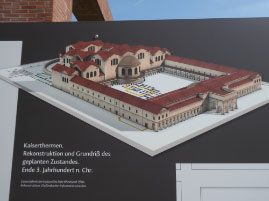
Imperial Baths |
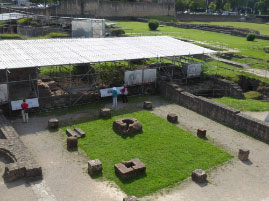
Imperial Baths |
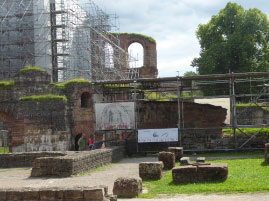
Imperial Baths |
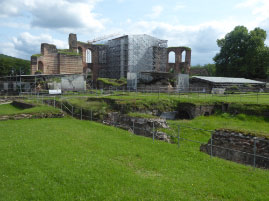
Imperial Baths |
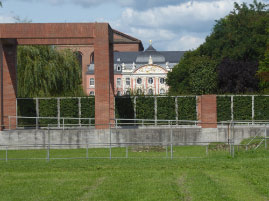
Imperial Baths |
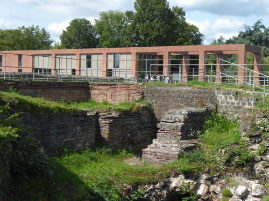
Imperial Baths |
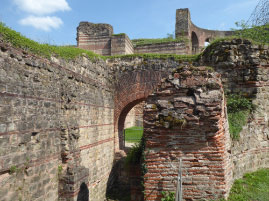
Imperial Baths |
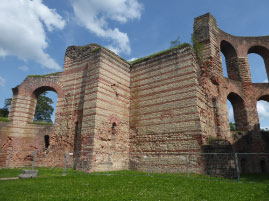
Imperial Baths |
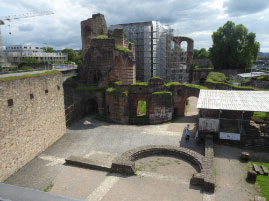
Imperial Baths |
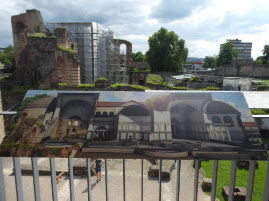
Imperial Baths |
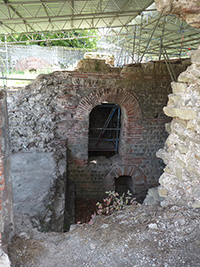
Imperial Baths |
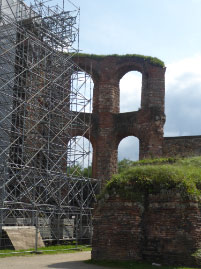
Imperial Baths |
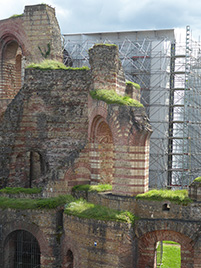
Imperial Baths |
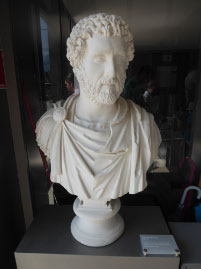
Imperial Baths |
We stroll back down the marketplace in the beautiful sunshine with happy Germans who know how to enjoy life. We stop back by the Black Gate once more and pay the entrance fee to explore the inside of the amazing old Roman Gate.

Black Gate |
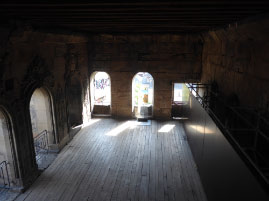
Black Gate |
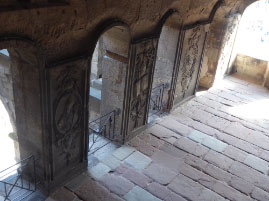
Black Gate |
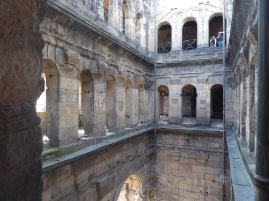
Black Gate |
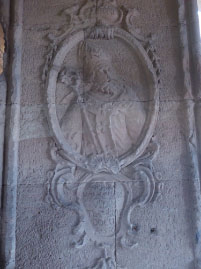
Black Gate |
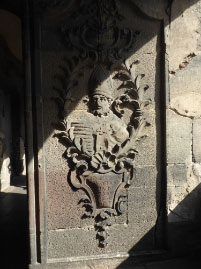
Black Gate |
The views of Trier we get from the Black Gate are picture postcard. Really like this place.
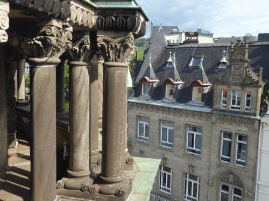
View from Black Gate |
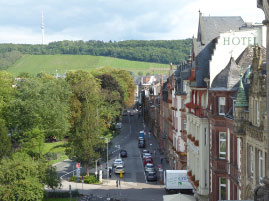
View from Black Gate |
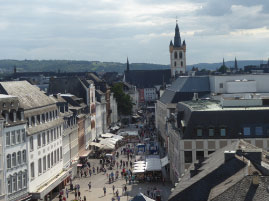
View from Black Gate |

View from Black Gate |
We walk back to the boat where we shower, check emails and catch up on the big happening in the US – the solar eclipse – a definite sign from God that the Donald must go!
Dinner is comforting and delicious -- Bavaria night with as many meat selections as you can imagine. I wolf down the roasted pig and Brats. This is too sinful. We sit with Steve and Patsy (from Rancho Bernado – near where we live) and are amazed at how much we have in common … even with Steve and Bill’s parallel former life in Milwaukee
After dinner, a local men’s chorus does a concert. We were warned to sit close to the exit if the music was not to our liking … Bavarian music can get annoying. We make a quick escape.
Back in the cabin, we call Amy. Great talking to her. It’s Zion’s first day of school – Can’t believe she’s starting the 11th grade!
Tuesday, August 22, 2017 – Scenic Cruise
We start the day by cruising along the Mosel River, passing by quaint villages and lush vineyards on the steep hills. We also pass through one of the many locks along the river. The day is gorgeous. (However, part of me wishes we had taken the optional tour to Luxembourg to see the Battle of the Bulge Cemetery. I didn’t know I would become a WW II fanatic on this trip!)
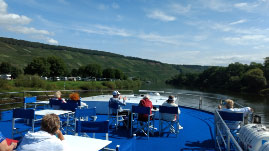
Cruising along the Mosel River |
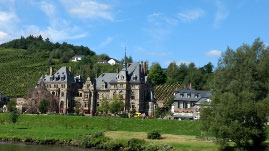
Cruising along the Mosel River |
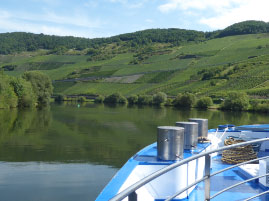
Cruising along the Mosel River |
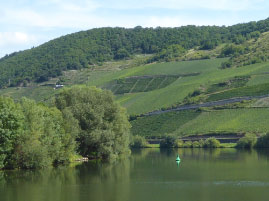
Cruising along the Mosel River |
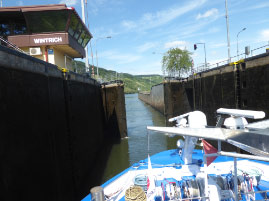
Cruising along the Mosel River |
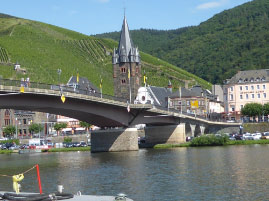
Cruising along the Mosel River |
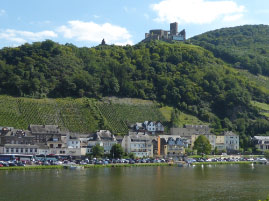
Cruising along the Mosel River |
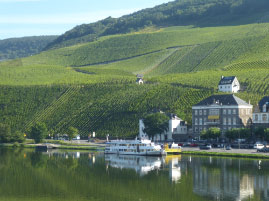
Cruising along the Mosel River |
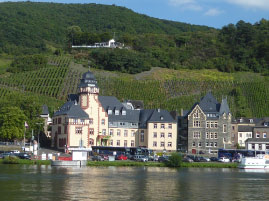
Cruising along the Mosel River |
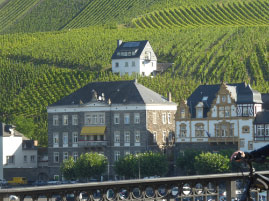
Cruising along the Mosel River |
The boat docks in Bernkastel. Martin leads a group into the charming little village square with it’s signature half-timbered houses. Some of the hardier group members continue uphill with Martin to Landshut Castle (Burg Landshut), perched on a high hill overlooking the Mosel River. We take a trail up through steep vineyards and then return through the woods.
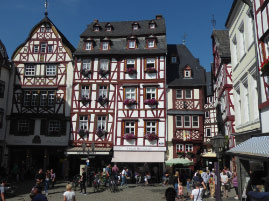
Bernkastel |
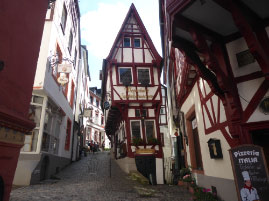
Bernkastel |
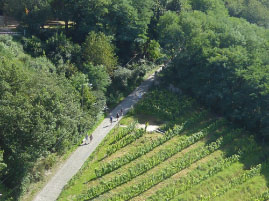
Bernkastel |
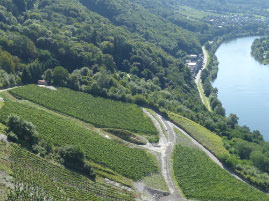
Bernkastel |
The castle ruin is one of the oldest buildings on the Mosel. It was built around the year 1162 after Holy Roman Emperor Frederick I decided he needed additional defense to secure the empire. According to the latest findings, the fort was constructed on an older fort dating back to the 4th or 5th century. It’s beautifully maintained, but very little signage – so I didn’t really know what I was looking at. However, I did recognize a lovely café. We climb among the ruins and take lots of photos of the panoramic views below.
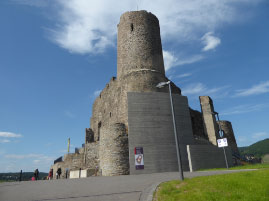
Bernkastel |
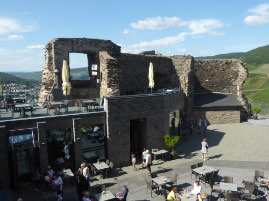
Bernkastel |
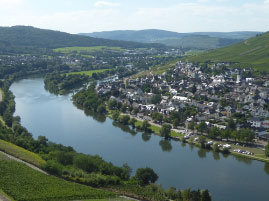
Bernkastel |
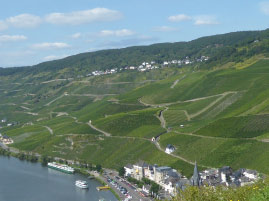
Bernkastel |
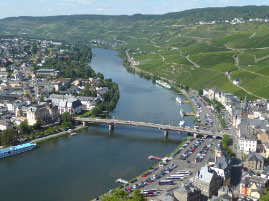
Bernkastel |
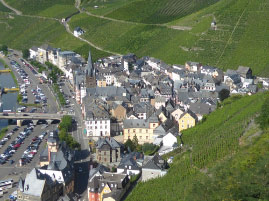
Bernkastel |
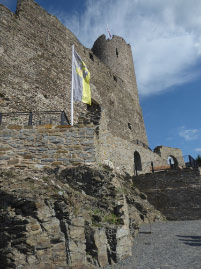
Bernkastel |
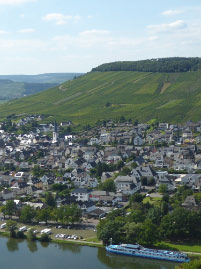
Bernkastel |
We take the woods trail back down through picturesque Bernkastel and then back to the boat. Beautiful, BEAUTIFUL DAY!
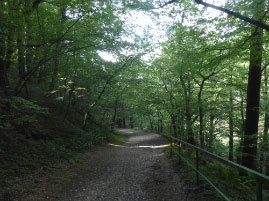
Bernkastel |
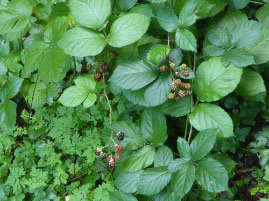
Bernkastel |
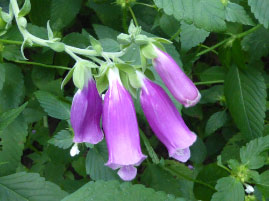
Bernkastel |
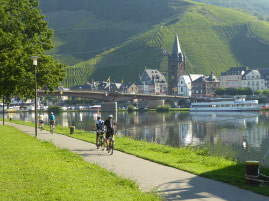
Bernkastel |
Wednesday, August 23, 2017 – Bernkastel
After breakfast, Paulina takes us for a stroll around Bernkastel, one of the prettiest little medieval towns in the Mosel Valley. (Actually Bernkastel is two towns with its sister town, Kues, on the opposite bank of the Mosel.) People flock to the town(s) to shop at the famous Christmas market.
Paulina has incredible energy and always makes everything more fun. She dashes off to the main square and points out the key buildings. She demonstrates how the town “ne’er-do-wells” are chained to the City Hall and put on display as a bad example. Paulina shows us all the cool shops making us want to buy everything, even the blood sausages from the Butcher’s shop.
She points out the crazy statues and all the grape vines that cling to the old buildings. This town is at the epicenter of a major wine region.
Of course Paulina makes time for a little history lesson. The church tower of St. Michael's is the only remaining tower of the old stone walls that once surrounded Bernkastel and still remains after Louis XIV destroyed the rest. The walls and tower came first, then came the church – a nice mix of religion and war – and practicality.
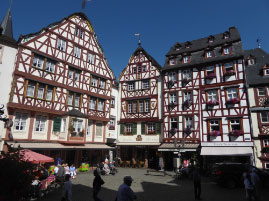
Bernkastel |
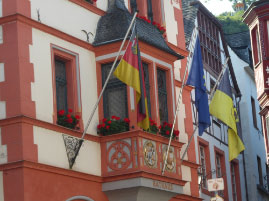
Bernkastel |
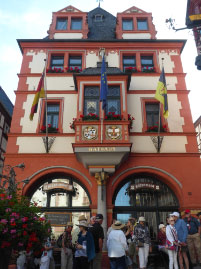
Bernkastel |
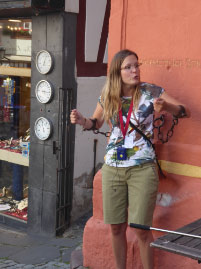
Bernkastel |
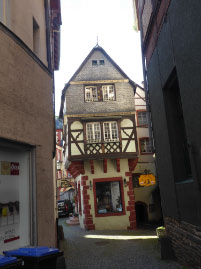
Bernkastel |
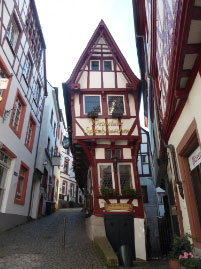
Bernkastel |
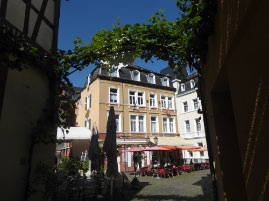
Bernkastel |
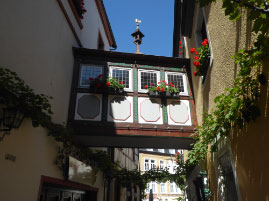
Bernkastel |
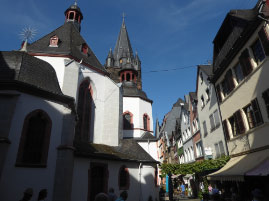
Bernkastel |
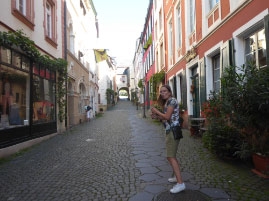
Bernkastel |
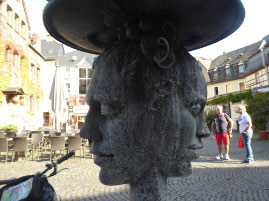
Bernkastel |
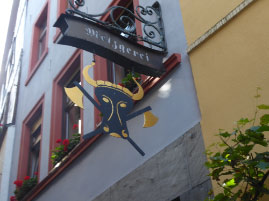
Bernkastel |
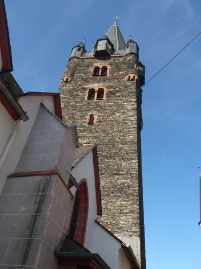
Bernkastel |
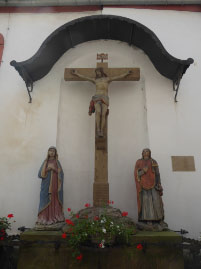
Bernkastel |
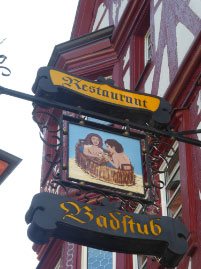
Bernkastel |
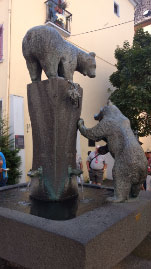
Bernkastel |
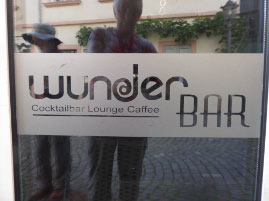
Bernkastel |
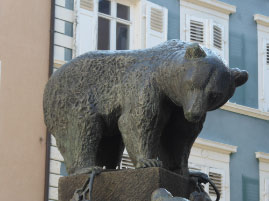
Bernkastel |
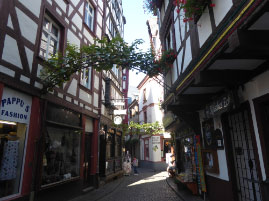
Bernkastel |
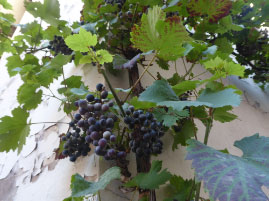
Bernkastel |
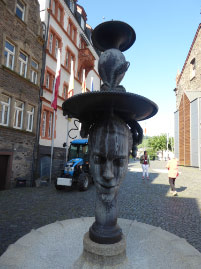
Bernkastel |
After exploring the town center, we walk only a few blocks to visit one of Bernkastel’s most famous wineries, referred by Grand Circle as “The Famous Doctor Vineyard.” The winery is 382 years old and is considered one of the best wine producers of the Mosel region. We are greeted by a lovely couple who happen to be the owners. They lead us to a dark, cool cellar (which happens to be under the town we were just exploring). They share their delightful stories and remarkable knowledge about wine. Sofia is sharp and part of the 11th generation to run the business. Her husband is loveable and funny. They make a wonderful blend … just like their wines. I’m not even a fan of Rieslings, but what I tasted was extraordinary.
NOTE: A brief history of the winery, taken from the internet -- dating back to 1636, the winery is currently overseen by 11th generation Sofia Thanisch. Back in the late 1890’s, a married couple, Dr. Hugo Thanisch and Katharina Thanisch, ran the estate together. In 1895, Hugo died at the age of only 42. Katharina was only thirty years old with three small children to raise and an estate to run. The name then changed to Wwe. Dr.H. Thanisch. “Wwe” refers to ”Witwe”, meaning “widow” and thus begin the story of strong women. Sofia, currently in charge, is the fourth woman to manage the estate. With two daughters, Juliane and Christina, the latter having studied international wine business at Geisenheim, so it appears the 12th generation to lead the estate will be another strong woman.
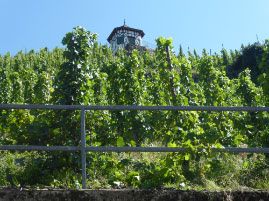
Bernkasteler Doctor Vinyard |
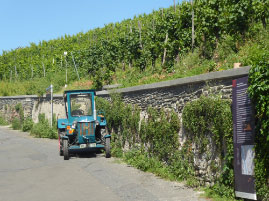
Bernkasteler Doctor Vinyard |
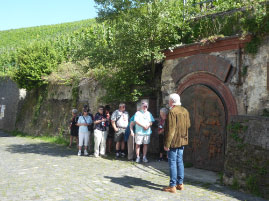
Bernkasteler Doctor Vinyard |
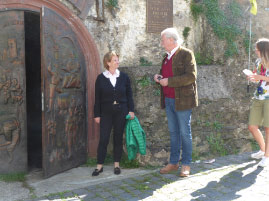
Bernkasteler Doctor Vinyard |
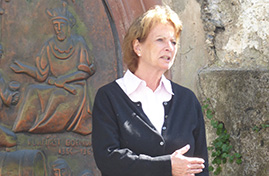
Bernkasteler Doctor Vinyard |
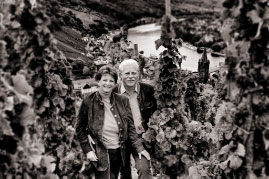
Bernkasteler Doctor Vinyard |
After lunch, we continue our cruise down the Mosel River. Lovely, relaxing day.
Thursday, August 24, 2017 – Boppard
There is an optional tour to Marksburg Castle – but we choose to spend the day exploring Boppard, a designated UNESCO World Heritage site because of its importance as a cultural and historic center for the middle Rhine region. We walk along the river promenade to Boppard.
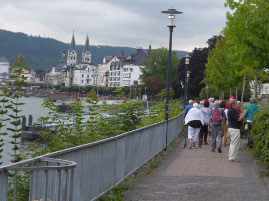
Boppard |
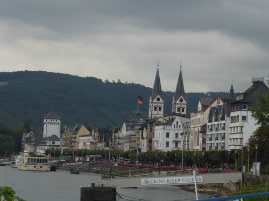
Boppard |
We walk to the main square, which is dominated by the twin towers of St. Severus Church. This 13-century Romanesque church has the most stunning stain glass windows. The five bells housed in the church resonate across town every day at 10am and 12 noon.
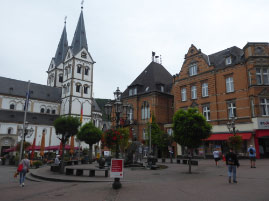
Boppard |
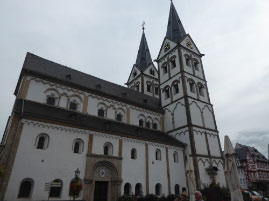
Boppard |
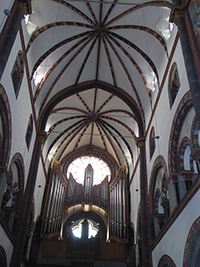
Boppard |
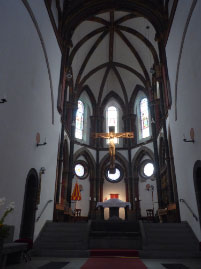
Boppard |
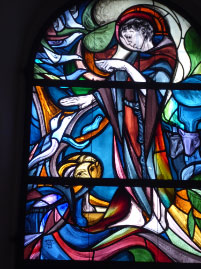
Boppard |
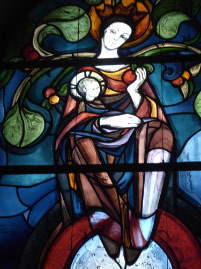
Boppard |
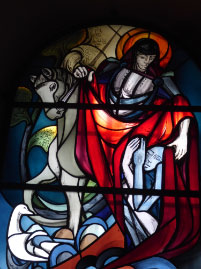
Boppard |
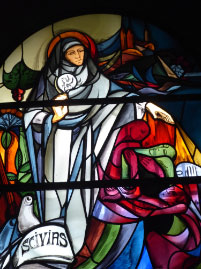
Boppard |
We explore the town and do a little shopping. Boppard is known for its funky chairs. One of the fountains is dedicated to chairs – and they are loveable.
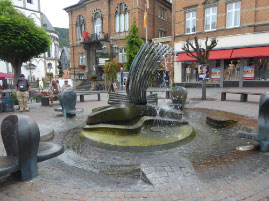
Boppard |
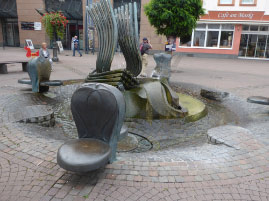
Boppard |
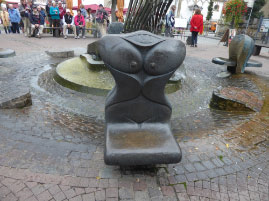
Boppard |
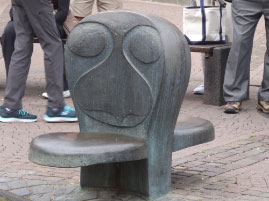
Boppard |
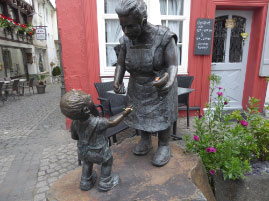
Boppard |
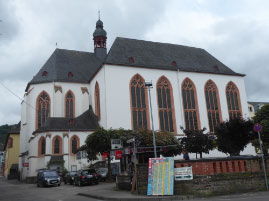
Boppard |
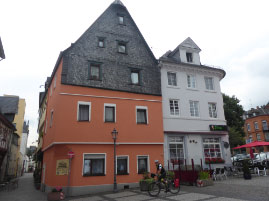
Boppard |
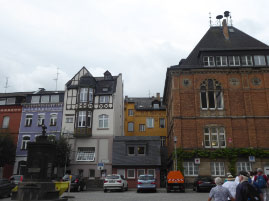
Boppard |
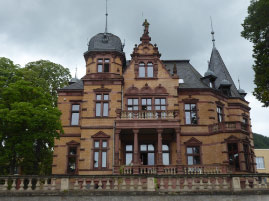
Boppard |
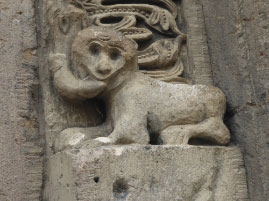
Boppard |
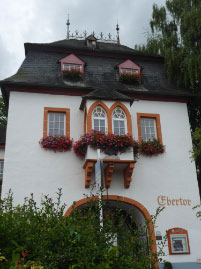
Boppard |
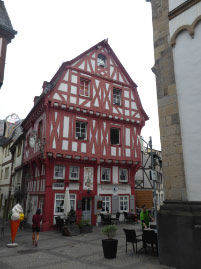
Boppard |
We follow Paulina through the town’s medieval walls. These ancient structures never go out of fashion! They actually blend seamlessly with the modern infrastructure. It’s interesting to see how parts of the walls and gates have been modified to make room for modern structures.
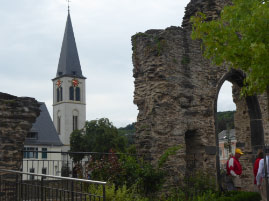
Boppard |
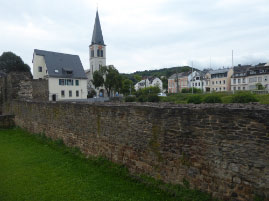
Boppard |
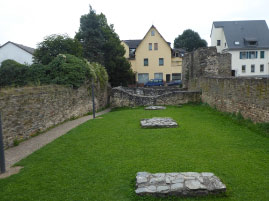
Boppard |
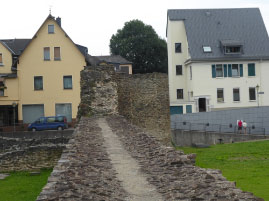
Boppard |
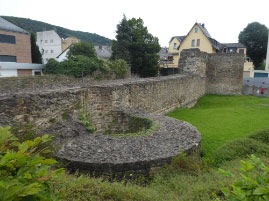
Boppard |
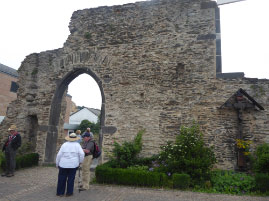
Boppard |
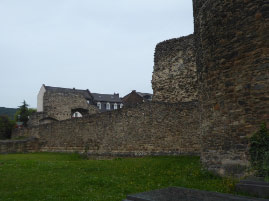
Boppard |
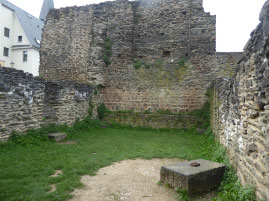
Boppard |
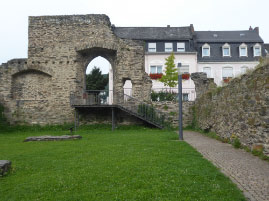
Boppard |
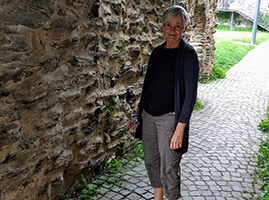
Boppard |
The group goes their separate ways after the town tour. We join Patsy and Steve from Rancho Bernado to hike up to the Vierseenblick. The Boppard Sesselbahn is a 915-metre-long two-seater chairlift that carries travelers off to the observation point in 20 minutes. The sweeping views over the Rhine Valley were priceless. To add to the fun, Patsy harmonized with a choir group who filled the on-coming car. They sang Edelweiss – or maybe it was “The Sound of Music” – either case, it was just perfect!
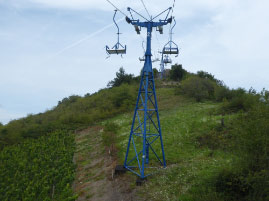
Boppard Sesselbahn |
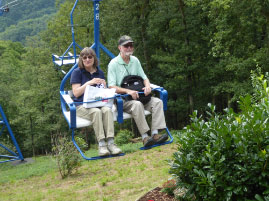
Boppard Sesselbahn |
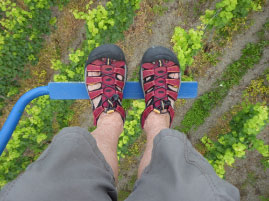
Boppard Sesselbahn |
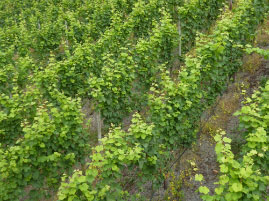
Boppard Sesselbahn |
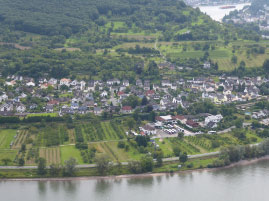
Boppard Sesselbahn |
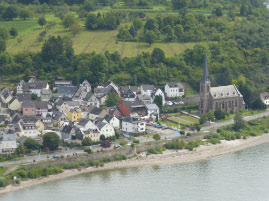
Boppard Sesselbahn |
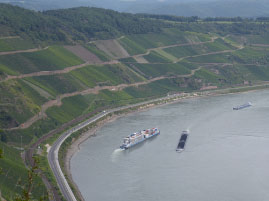
Boppard Sesselbahn |
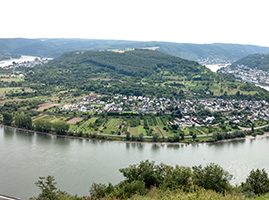
Boppard Sesselbahn |
We walk back to the ship with Patsy and Steve.
We spend a couple of hours on the deck, sailing in the most beautiful part of the Rhine, dotted with massive castles and quaint villages. We see an imposing rock rising 440 feet above the river. Since ancient Greek mythology, there have been legends of sirens, who lure sailors to their death with sweet songs. Ancient Germanic legend places one such siren—Lorelei—here, and it is said she enticed sailors to destruction on the reef below the rock. One of our group leaders cross-dresses as Lorelei to woo the old codogers.
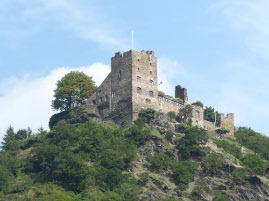
Cruising Along the Rhine |
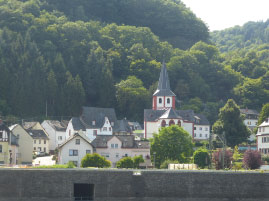
Cruising Along the Rhine |
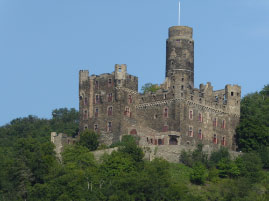
Cruising Along the Rhine |
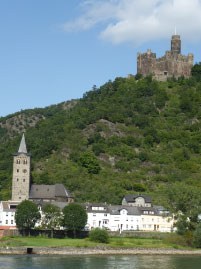
Cruising Along the Rhine |
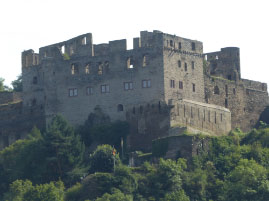
Cruising Along the Rhine |
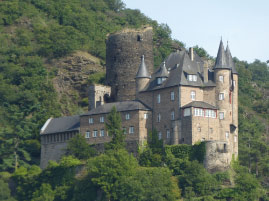
Cruising Along the Rhine |
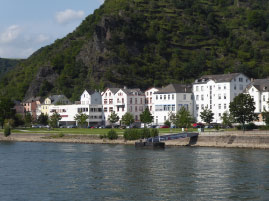
Cruising Along the Rhine |
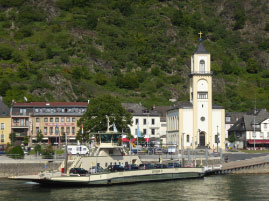
Cruising Along the Rhine |
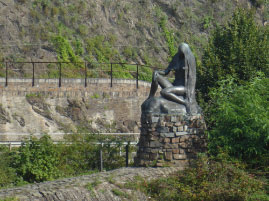
Cruising Along the Rhine |
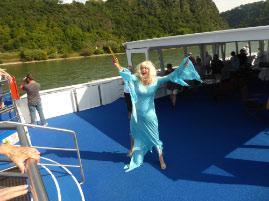
Cruising Along the Rhine |
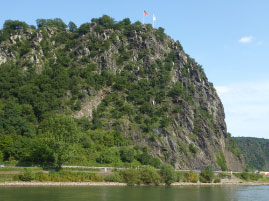
Cruising Along the Rhine |
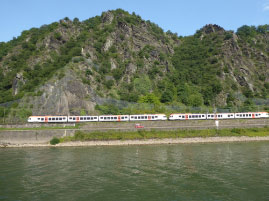
Cruising Along the Rhine |
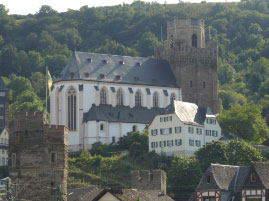
Cruising Along the Rhine |
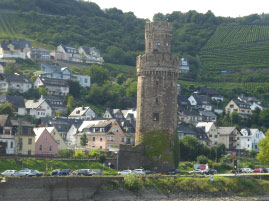
Cruising Along the Rhine |
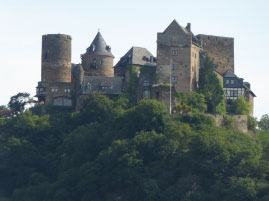
Cruising Along the Rhine |
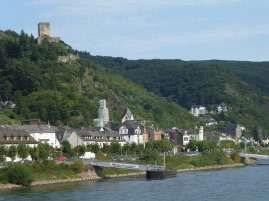
Cruising Along the Rhine |
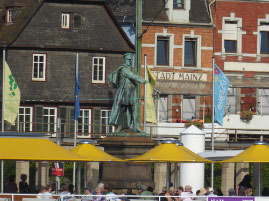
Cruising Along the Rhine |
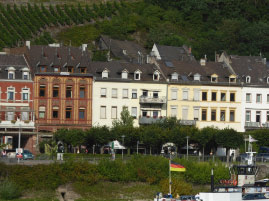
Cruising Along the Rhine |
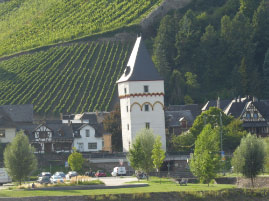
Cruising Along the Rhine |
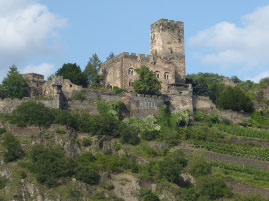
Cruising Along the Rhine |
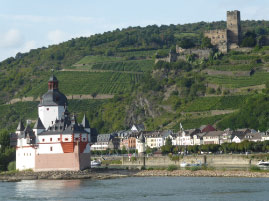
Cruising Along the Rhine |
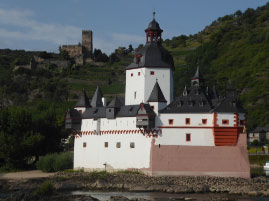
Cruising Along the Rhine |
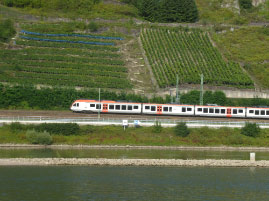
Cruising Along the Rhine |
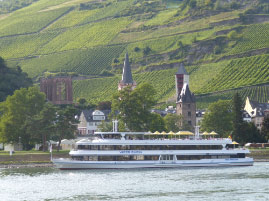
Cruising Along the Rhine |
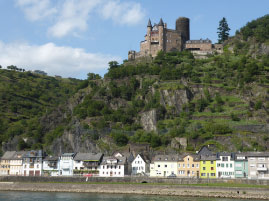
Cruising Along the Rhine |
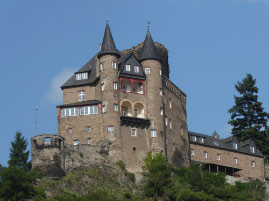
Cruising Along the Rhine |
We set sail for Speyer. Another lovely dinner tonight followed by Karaoke – I’m not interested. More fun to watch old WW II clips on Youtube.
Friday, August 25, 2017 – Speyer
After breakfast, Paulina takes us on a walking tour of Speyer, a town founded by the Romans in approximately AD 50. It became a grand city and flourished during the Middle Ages. Unfortunately, much of Speyer was destroyed in the 17th century during the Palatine War of Succession. The good news is that the town was re-built in the 18th century and still looks good (on 18th century standards)
A few remnants of Speyer’s glorious Medieval past survive – the most notable is the Imperial Cathedral (St. Mary and St. Stephen), an amazing Romanesque Cathedral.
Before we explore the Cathedral, Paulina shows us some impressive statues on the grounds. The Roman statue reminds us of the presence and the power of Romanesque times. Another statue is a group representing the royalty associated with the Cathedral. In fact, the cathedral contains the royal tombs of four emperors, three empresses, and four German kings, as well as a row of bishops' tombs. Some of the names include Salian, Staufer, and Habsburg rulers. There’s no doubt that the cathedral of Speyer functioned as the center of the medieval emperorship.
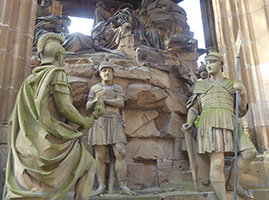
Speyer |
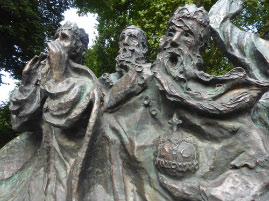
Speyer |
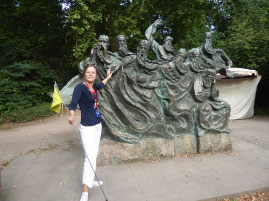
Speyer |
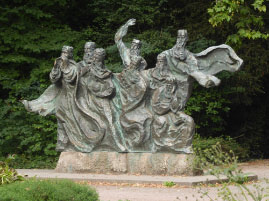
Speyer |
The cathedral, built between 1030 and 1125, is the largest Romanesque building in Germany. Now it is an Episcopal church. It was finally restored back to its original shape during an intensive renovation that ran from 1957 to 1961. In 1981, it was added to the UNESCO World Heritage list – and for good reason!
I enter the church and am immediately taken by the simple, stark, vast interior which is lit by the muted daylight from above.
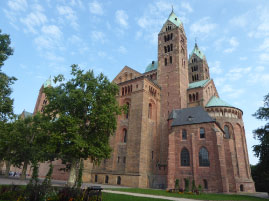
Imperial Cathedral |
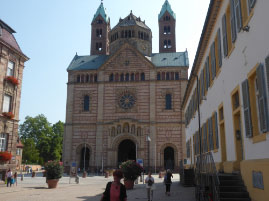
Imperial Cathedral |
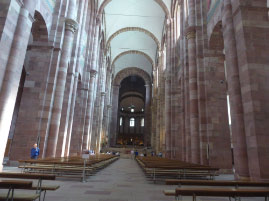
Imperial Cathedral |
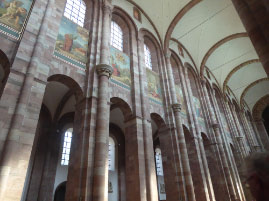
Imperial Cathedral |
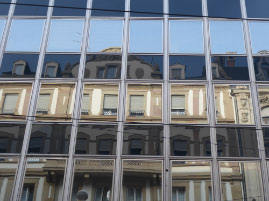
Imperial Cathedral |
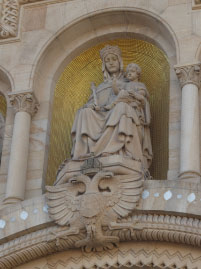
Imperial Cathedral |
The Cathedral dominates the large square, surrounded by other important buildings. A huge, round container (pictured below), once held gallons of wine for the townsfolk to come regularly and share in a massive communion. Pauline tells us it was a ruckus event.
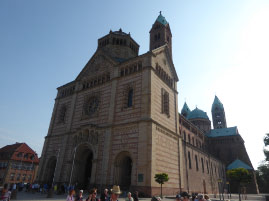
Speyer |
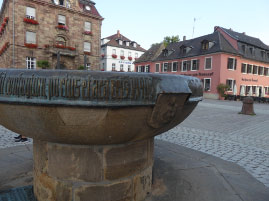
Speyer |
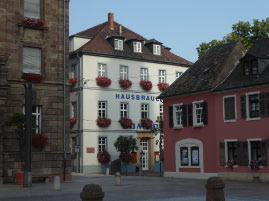
Speyer |
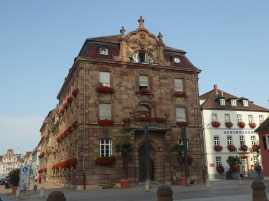
Speyer |
Speyer is the cradle of German Protestantism and the Cathedral played a big part in Martin Luther’s Protestant Reformation. In fact, Germany just celebrated the 500th anniversary of the Protestant Reformation. (I am fascinated by Martin Luther – made Speyer very special to me.)
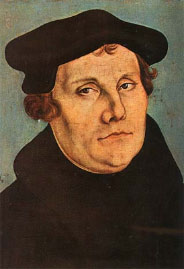
Martin Luther |
A Brief History of Martin Luther – Optional Reading
Martin Luther was born in the region on November 10, 1483. He followed his father’s wishes and he went to law school. On a fateful afternoon, while out in a fierce thunderstorm, he was nearly struck by lightning. He felt that this was a sign that he should give up law school and become a monk. Later, Luther joined a monastery in Germany and began to dedicate his life to learning and teaching the Gospel. The more he studied, the more he felt that the Catholic Church had gone astray. He compiled a list of 95 different points of doctrine where he felt that the Church had gone off track. Others, like Luther, were having their own doubts about the Catholic religion. The increasing wealth in Europe and the invention of the printing press produced more readers and more thinkers – thinkers who doubted the edicts of the powerful Catholic Church.
On October 31, 1517, Luther wrote his 95 disagreements with the church and put them on a placard and nailed it to the door of the Catholic Church in Wittenberg, Germany. These 95 bullet points were published and sent throughout Germany. As a result, the Catholic Church began losing support and worse, losing money from its collections. One previous cash cow for the Catholic Church was the “sale of indulgences.” You sin – no problem, just buy forgiveness for your sins from the church. (This was only one of the 95 practices that Martin Luther disagreed with.)
As the money from the sale of indulgences decreased, Pope Leo X grew more and more upset. He sent his men to Martin Luther in an attempt to get him change his tune. Martin Luther refused to do so. He felt he had an obligation to God to do what was right.
By 1520 A.D., the Catholic Church had had enough with Luther’s antics. They declared him a heretic -- a crime punishable by death. Luther escaped and went into hiding, where he translated the Bible into German.
Later, Martin Luther founded a new religion (known as Lutheranism) showing how a Christian church could separate from Catholicism. This thinking marked a turning point in Christian thinking, and established Luther as one of the most important figures in European history. (NOTE: Luther died in 1546 – and somehow managed to marry and have six children during his very full life.)
After the cathedral, Paulina walks us to the once thriving Jewish quarters -- a significant Jewish community from medieval times up until 1940 and WW II.
We only heard about (but didn’t see) the remains of a "Romanesque" style medieval synagogue and a 13th Century Mikwe (the ritual bath used by Jewish women for centuries, built around 1120).
But Paulina takes us through the small neighborhood to a hidden little courtyard, filled with whimsical art. Paullina is disappointed that the artist in residence wasn’t at home. She said we would have liked his craziness.
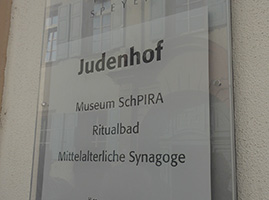
Jewish Quarter |
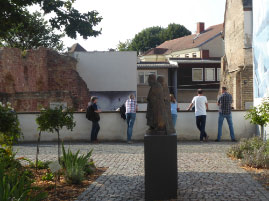
Jewish Quarter |
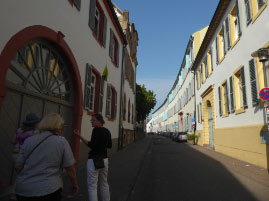
Jewish Quarter |
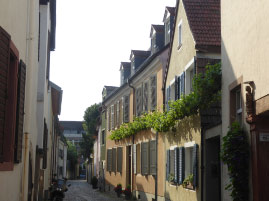
Jewish Quarter |
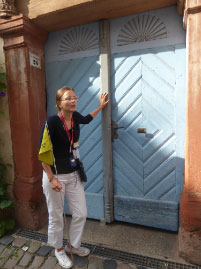
Jewish Quarter |
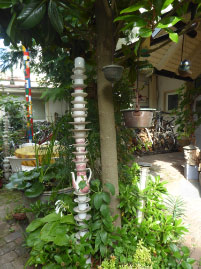
Jewish Quarter |
Next stop is City Hall and the Main Square, established way back in 1500 BC. We roam the main pedestrian area.
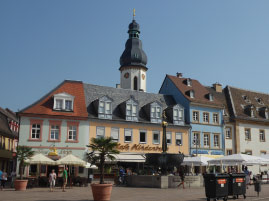
City Hall and the Main Square |
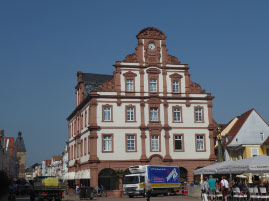
City Hall and the Main Square |
Paulina points out City Hall -- where bride and grooms flock to get married. Right across the street is a walking man statue with some legend attached, but I can’t remember it now.
After lunch, I pop into an upscale woman’s fashion shop to try on a dirndl (traditional German woman’s dress). I didn’t buy the dress. I just look fat in it while posing with the darling sales gal. Our group (Paulina’s Yellow Team) is competing with the other teams, coming up with specific assigned photos. We needed a photo of someone in the group wearing an authentic German outfit. I am so easily pressured by my peers.
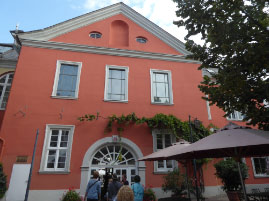
Speyer |
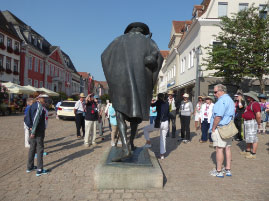
Speyer |
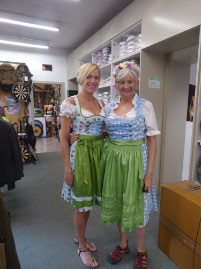
Trying on a dirndl |
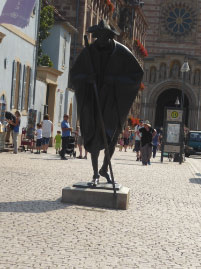
Speyer |
We say “good-bye” to the group and meander on our way. Bill stops to get a pretzel for some quick energy. We wander through more cool squares and see more cool churches. I especially like the one with a large statue of Martin Luther in the foyer. This town is something very special.
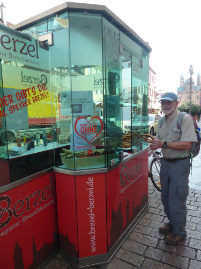
Speyer |
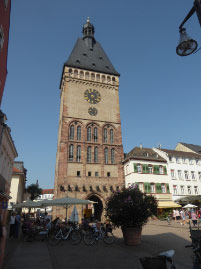
Speyer |
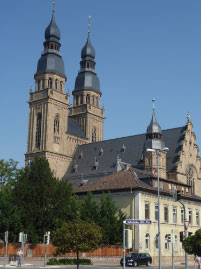
Speyer |
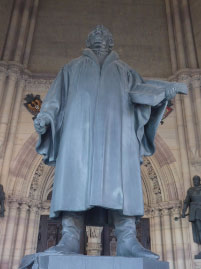
Speyer |
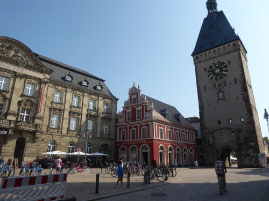
Speyer |
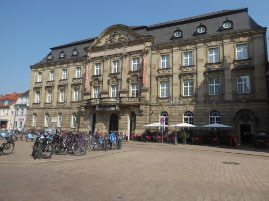
Speyer |
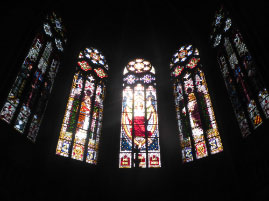
Speyer |
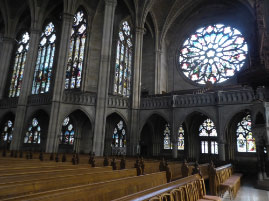
Speyer |
We head back to the boat and regroup for the afternoon outing. We pair up with Georjean and Bruce, retired National Park Rangers who live in Prescott. A van picks us up and drops us at the home of a local family for a traditional Kaffeeklatsch to share coffee, cake, and conversation. The desserts are divine and the conversation fun. The wife is a serious, gracious host and chef extraordinaire. Her husband is a wild and crazy guy. He drives up late – from a mad dash to London and back to watch the Germans / Brits soccer match. He has been up for over 24 hours and when we meet, he seems hyped from drinking and driving his very fast car on the autobahn. We enjoy them both very much and the amazing chemistry they create. He shares his lovely wines and she shares her newspaper clippings. (They have two sons who are now attending college.)
Georjean and Bruce, our American pals are fascinating too. Georjean was like having Alexa around – you can ask her anything and she answers (and with the right answer at that). She was one of the grand winners on the TV game show “Jeopardy.” I stay as close to her on the trip because I am hooked on learning new things, but I try not to be too obnoxious.
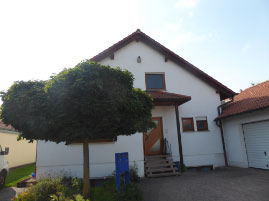
Home of our German hosts |
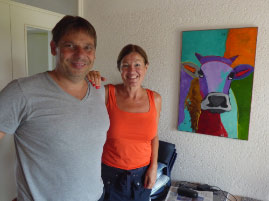
Our German hosts |
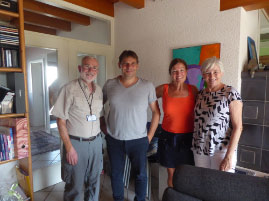
Bill and Nancy with our hosts |
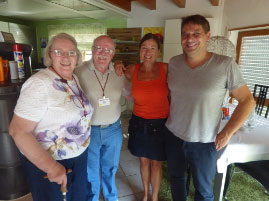
Georjean and Bruce with our hosts |
We have dinner on the boat and later, the crew entertains us with a whacky show.
Saturday, August 26, 2017 – Strasbourg
Early in the morning, we dock in Strasbourg, France -- love how these boats deliver you to from town to town and country to country.
Strasbourg is 300 miles southeast of Paris. Strategically important since ancient times, Strasbourg became a free imperial city of the German Empire in 1262, and then was occupied by France in 1681 and then Germany in 1871. France recovered the city in 1919 after World War I and now it seems firmly in the hands of the French.
NOTE: Years ago Bill and I explored Strasbourg and the Alsace region looking for his German Jewish family from the 18th Century. We found the official records in the town hall and the Strasbourg library and managed to locate several headstones. (Napoleon made things difficult because every time he conquered an area, all the records had to be returned to the year “0.”) We didn’t sign up for a day in the Alsace region, because we spent a week there and want to rediscover Strasbourg.
Paulina shows us how to ride a streetcar like a local into the city where we meet Gabriel, our local guide. Gabriel is fun guy. We all loved his quirky spirit.
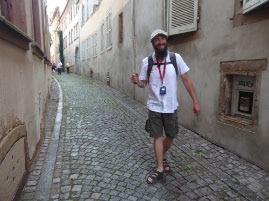
Gabriel |
We start with the UNESCO World Heritage Site, La Petite France and follow Gabriel through a maze of 16th-century half-timbered houses, cobbled streets, covered bridges, guard towners, and charming squares.
La Petite France sits on a small island right in the center of Strasbourg, surrounded by scenic canals on four sides. In the 15th century, this is where the leather tanners, the fishermen and the mill workers used to live. This is also where a hospital was built for the sole purpose of treating the soldiers returning from the Italian wars with syphilis, called "the French disease.” (That’s where the name of La Petite France came from.)
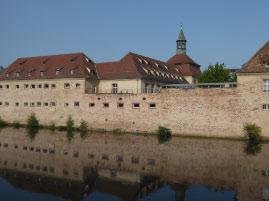
Strasbourg |
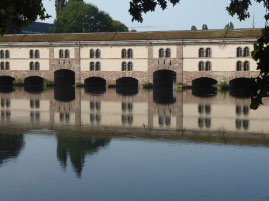
Strasbourg |
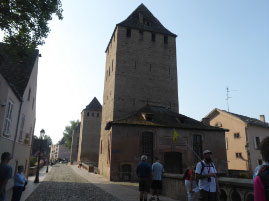
Strasbourg |
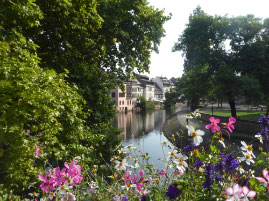
Strasbourg |
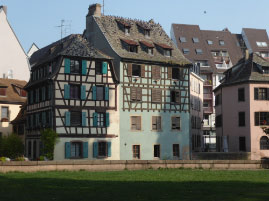
Strasbourg |
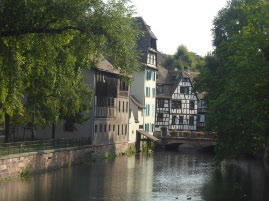
Strasbourg |
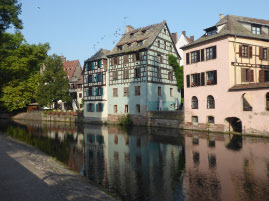
Strasbourg |
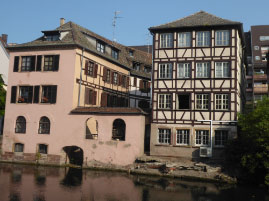
Strasbourg |
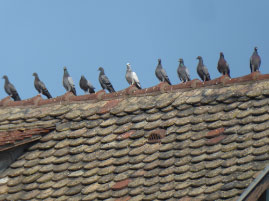
Strasbourg |
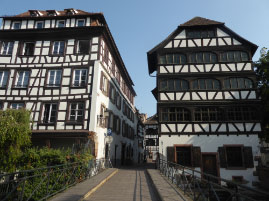
Strasbourg |
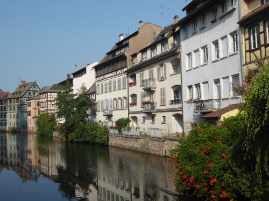
Strasbourg |
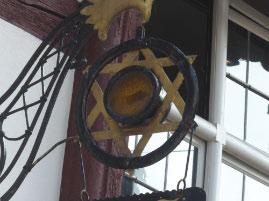
Strasbourg |
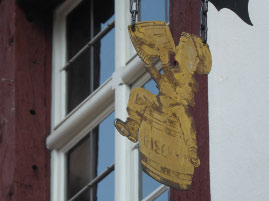
Strasbourg |
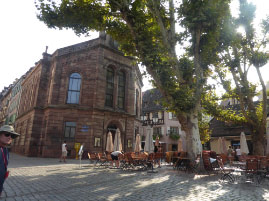
Strasbourg |
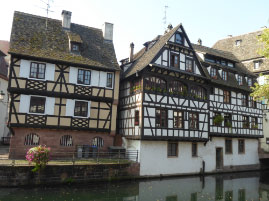
Strasbourg |
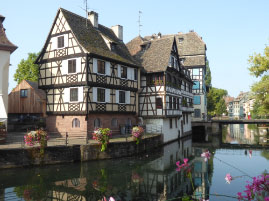
Strasbourg |
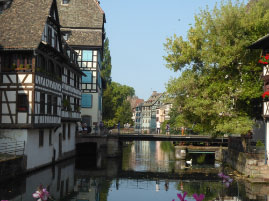
Strasbourg |
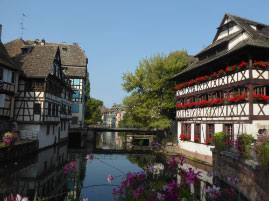
Strasbourg |
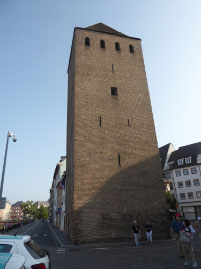
Strasbourg |
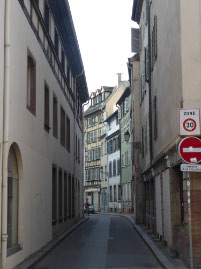
Strasbourg |
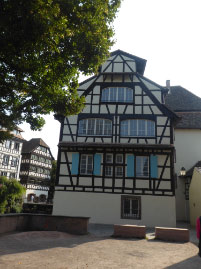
Strasbourg |
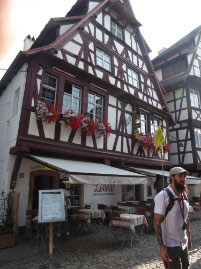
Strasbourg |
After Petit France, we wind our way towards the center of town. We stop briefly at one of the city’s oldest squares (place Gutenberg). The central statue (1840), by David d’Angers, is of Gutenberg, who perfected his printing press in Strasbourg in the winter of 1436 and 1437.
The former town hall, now the Hôtel du Commerce, was built in 1582 and is one of the most significant Renaissance buildings in Alsace. The neighborhoods within a few blocks of the city’s Notre Dame Cathedral are loaded with medieval references and historical charm.
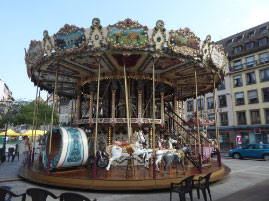
Strasbourg |
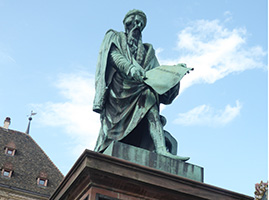
Strasbourg |
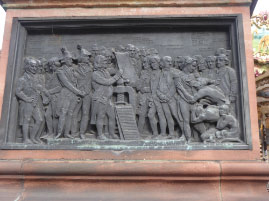
Strasbourg |
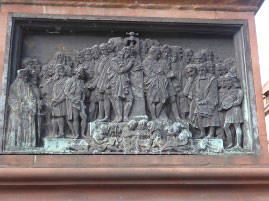
Strasbourg |
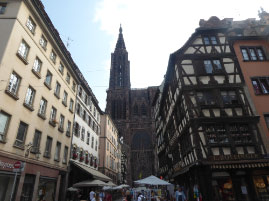
Strasbourg |
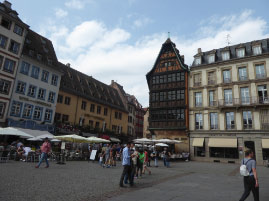
Strasbourg |
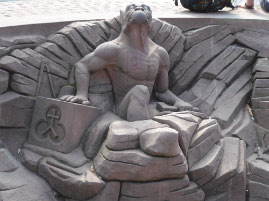
Strasbourg |
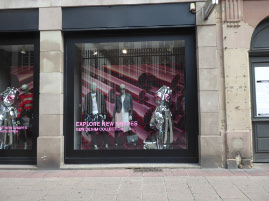
Strasbourg |
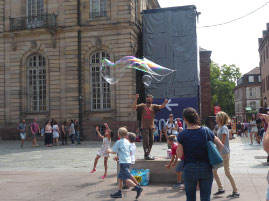
Strasbourg |
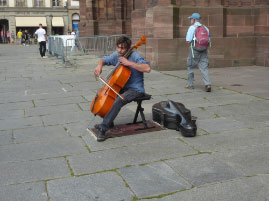
Strasbourg |
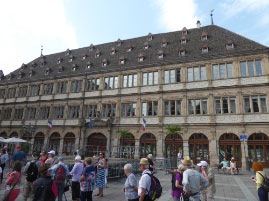
Strasbourg |
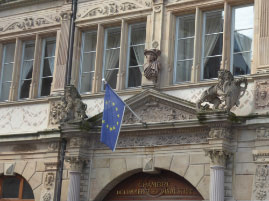
Strasbourg |
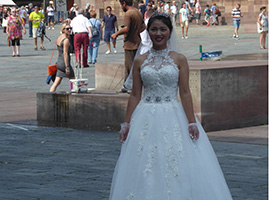
Strasbourg |
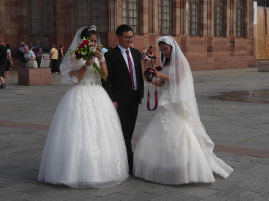
Strasbourg |
We arrive at the majestic gothic Cathedral Notre-Dame, crown jewel of Strasbourg. Construction began in 1176, but the tower in rose-colored stone was not completed until some 250 years later. The tower stands at 462 feet. -- the tallest one from medieval times. This cathedral is still in use and one of the most visited monuments in Europe. The stained-glass windows, by Max Ingrand, depicts emperors and kings.
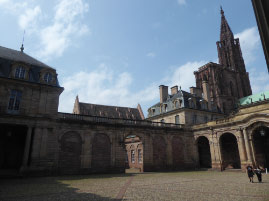
Cathedral Notre-Dame |
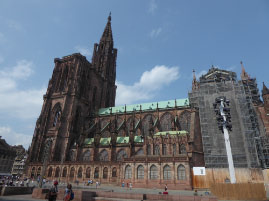
Cathedral Notre-Dame |
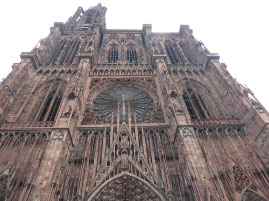
Cathedral Notre-Dame |
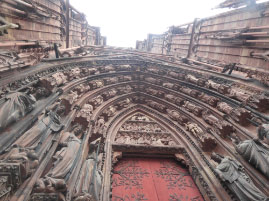
Cathedral Notre-Dame |
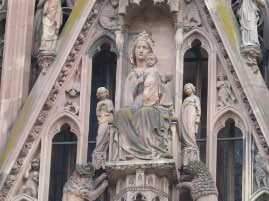
Cathedral Notre-Dame |
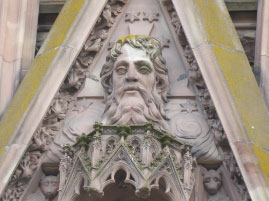
Cathedral Notre-Dame |
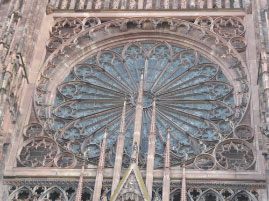
Cathedral Notre-Dame |
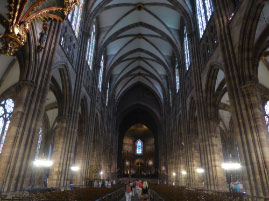
Cathedral Notre-Dame |
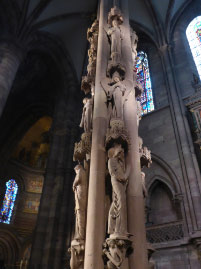
Cathedral Notre-Dame |
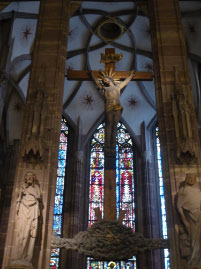
Cathedral Notre-Dame |
The cathedral’s most prized possession is an astronomical clock, built between 1547 and 1574. It stopped during the French Revolution, and from 1838 to 1842, and then the mechanism was replaced. Each day crowds gather to see the movement of allegorical figures -- Apollo and his sun horses; Jupiter and his eagle, etc. The body of the clock has a planetarium based on the theories of Copernicus.
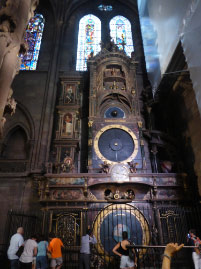
Cathedral Notre-Dame |
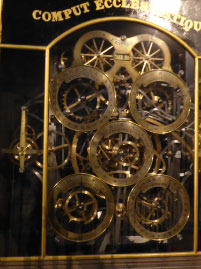
Cathedral Notre-Dame |
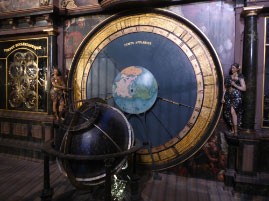
Cathedral Notre-Dame |

Cathedral Notre-Dame |
Strasbourg Cathedral is so stunning, and so dominant, that it is easy to miss the Palais de Rohan -- among the best Rococo palaces in France. This former bishop’s palace, adjacent to the cathedral, is now the home of 3 museums - Archeological Museum (one of the best in France), the Decorative Arts (gives a view of what it’s like to be a former nobles), and a Fine Arts Museum.
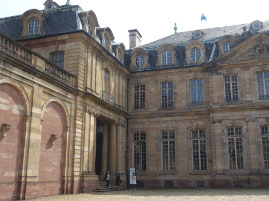
Palais de Rohan |
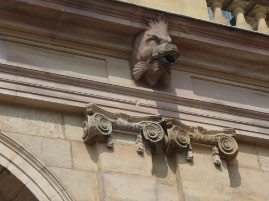
Palais de Rohan |
My favorite was seeing the 18th century lavish apartments of the cardinals of Rohan with the elegantly furnished rooms, tapestries, ceramics, silverwork, etc. (By the way, I learned that this was also the palace of the cardinal whose stupidity led to his involvement in the affair of the diamond necklace that doomed Marie Antoinette in the eyes of French public -- No wonder there was a French Revolution!)
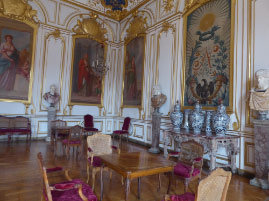
Palais de Rohan |
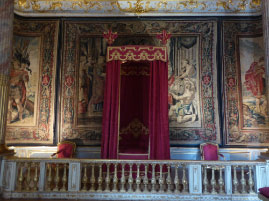
Palais de Rohan |
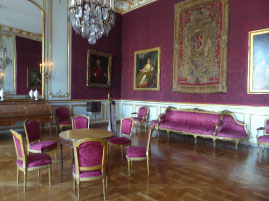
Palais de Rohan |
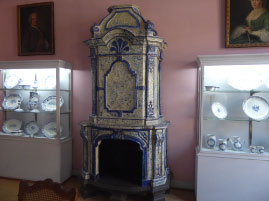
Palais de Rohan |
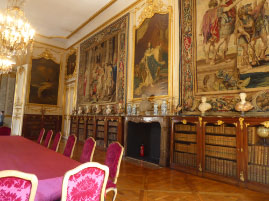
Palais de Rohan |
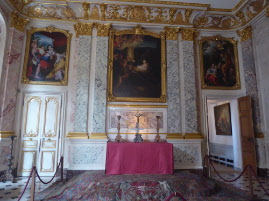
Palais de Rohan |
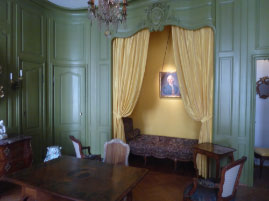
Palais de Rohan |
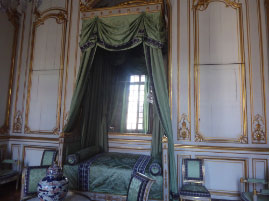
Palais de Rohan |
Next, we did the archaeological museum in the basement and were overwhelmed by all the antiquities. There was simply no time to do the Fine Arts Museum.
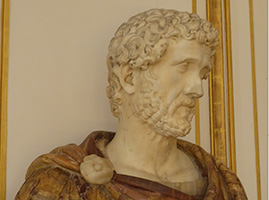
Palais de Rohan |
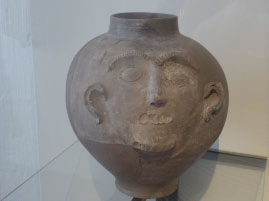
Palais de Rohan |
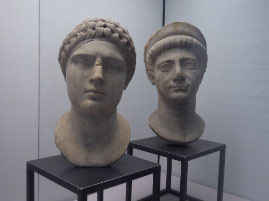
Palais de Rohan |
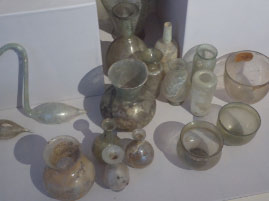
Palais de Rohan |
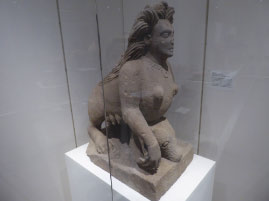
Palais de Rohan |
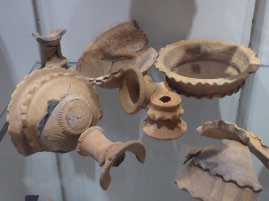
Palais de Rohan |
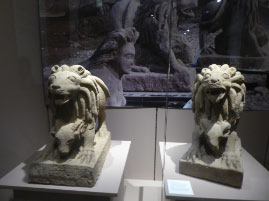
Palais de Rohan |
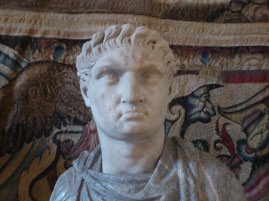
Palais de Rohan |
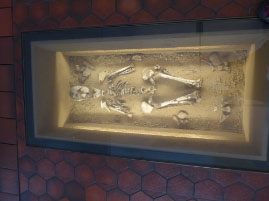
Palais de Rohan |
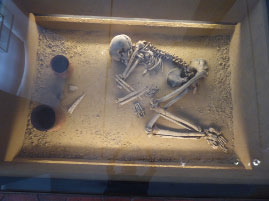
Palais de Rohan |
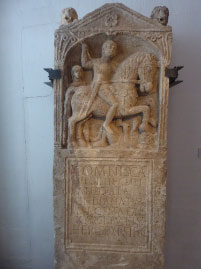
Palais de Rohan |
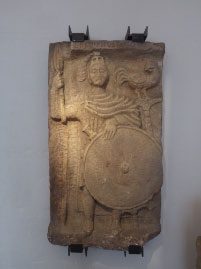
Palais de Rohan |
We use our valued map and public transportation pass to make our way back to the tram that takes us to ship. We relax, then enjoy happy hour before we pork out in the dining room.
We return to the Strasbourg Cathedral for a stunning light and sound show. It was late when we return to the boat – but oh so worth it. What they can do with lights and sounds in the night air in an old medieval town!
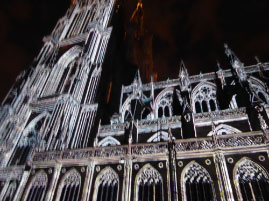
Strasbourg Cathedral light show |
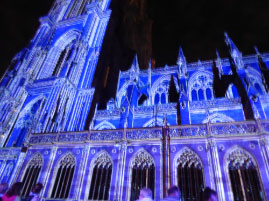
Strasbourg Cathedral light show |
Sunday, August 27, 2017 – Strasbourg, Baden-Baden, Germany • Captain’s Farewell Dinner
Our ship remained docked in Strasbourg overnight. After breakfast, we take the bus to the spa town of Baden-Baden, nestled in the thick, deep green forests. The town, Baden-Baden (the name comes from the German word for bath) is renowned for its thermal baths since Roman times.
To get there, we drive through the Black Forest, a new National Park just opened in 2014. The park encompasses 39 square miles of forests and moors. I enjoy the views from the bus, in spite of the fog and misty outside. The mood is great for Paulina’s Grimm Brothers’ fairy tales that originated from this area. The most entertaining is a poem that shows a different side of the Cinderella story, from Revolting Rhymes, a collection of six Roald Dahl poems published in 1982. God, we’re going to miss Paulina.
I think of my sister-in-law, who lived in the Black Forest in her early years, before she immigrated to the U.S. with her grandmother and father. Her mother (pregnant with her) and her grandmother lived in one of these little villages while her father was in the war. It wasn’t an easy place for two women (albeit two strong German women) to survive during WW II.
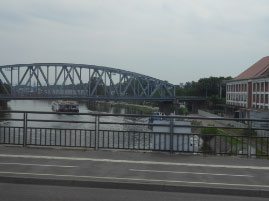
Going to Baden-Baden |
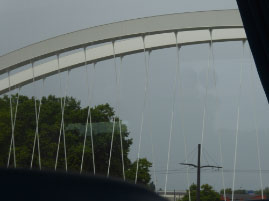
Going to Baden-Baden |
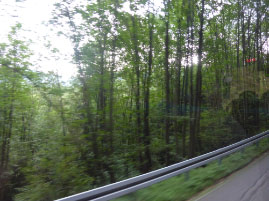
Black Forest National Park |
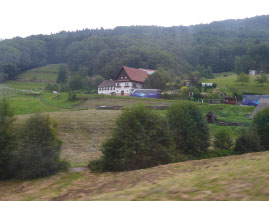
Black Forest National Park |
We arrive in in Baden-Baden – it’s very quiet today. It still gives off an aura of long ago wealth and privilege. Roman emperor Caracalla came here to ease his arthritic aches 2,000 years ago. Queen Victoria, Kaiser Wilhelm I, Napoleon III, Berlioz, Brahms, and Dostoevsky are among the elite who put Baden-Baden on the map as the most elegant spa resort Germany. Tolstoy even set a scene in “Anna Karenina” here.
We explore the town – there’s lots to do – but no time to really do it. We stroll the old European cobbled streets with its squares, gardens, statues, churches, etc.
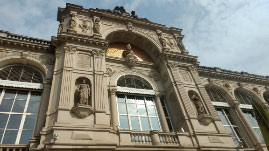
Baden-Baden |
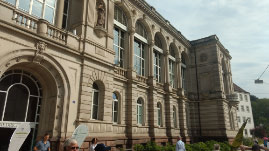
Baden-Baden |
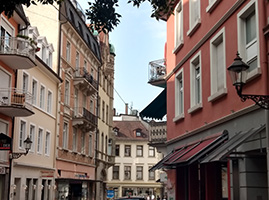
Baden-Baden |
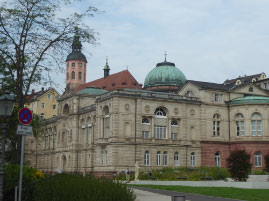
Baden-Baden |
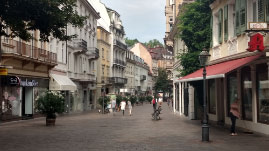
Baden-Baden |
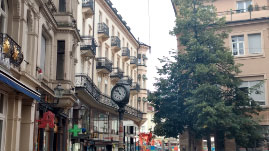
Baden-Baden |
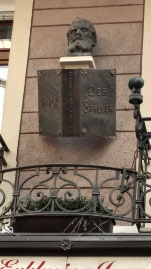
Baden-Baden |
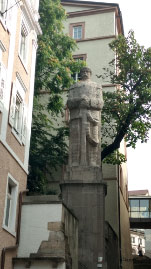
Baden-Baden |
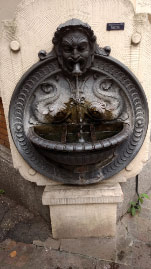
Baden-Baden |
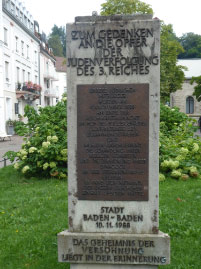
Baden-Baden |
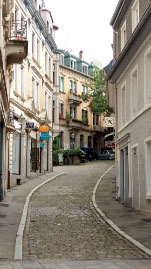
Baden-Baden |
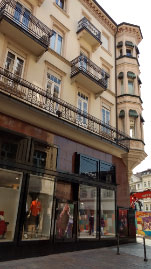
Baden-Baden |
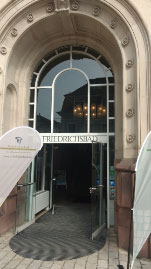
Baden-Baden |
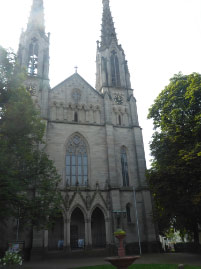
Baden-Baden |
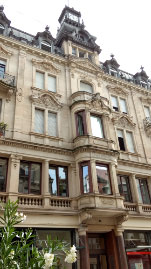
Baden-Baden |
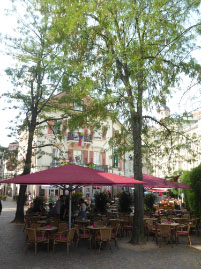
Baden-Baden |
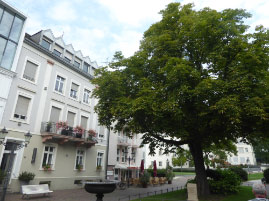
Baden-Baden |
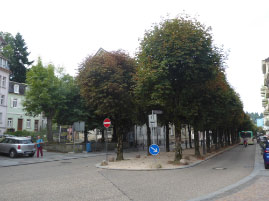
Baden-Baden |
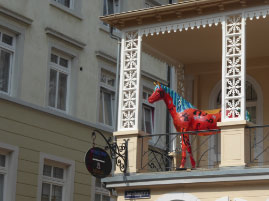
Baden-Baden |
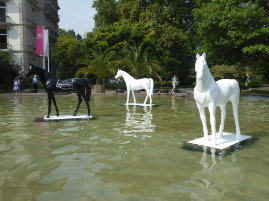
Baden-Baden |
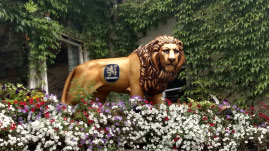
Baden-Baden |
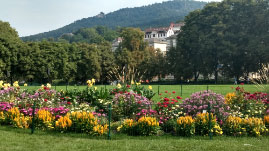
Baden-Baden |
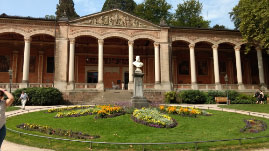
Baden-Baden |
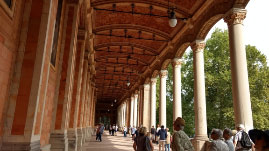
Baden-Baden |
We marvel at Kurhaus (White House), a spa resort and casino. The structure was designed in 1824 by Friedrich Weinbrenner. Although a casino was incorporated from the inception of the Kurhaus, it only became an internationally famous hangout in the mid-1830s, when gambling was forbidden in France. Marlene Dietrich said that Kurhaus was "the most beautiful casino in the world.
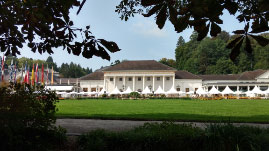
Baden-Baden |
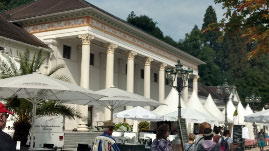
Baden-Baden |
Baden-Baden has many lovely gardens and parks. “Lichtentaler Allee,” a historic park and arboretum, was established from 1850 – 1870. Trees were planted along a 1.5 mile avenue on the west bank of the river Oos. The avenue is as beautiful as ever and has about 300 types of native and exotic woody plants.
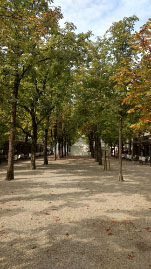
Baden-Baden |
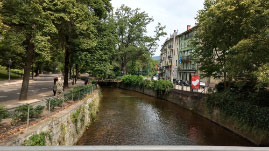
Baden-Baden |
Paulina gives us a choice – either soak up more of the town – or soak in one of the thermal spa establishments. I selected the thermal springs SPA option while Bill selects the on-land option. (He goes back to town with his land locked friends for some adventure – not sure where they went or what they saw.)
My group enters the Caracalla SPA (named for Caracalla, the arthritic Roman Emperor). We change into our bathing suits and indulge in some slightly radioactive waters, rich in sodium chloride, bubble up from artesian wells at 160-degree temperatures. There are a host of other soaking options – cooler pools (inside and out), saunas, and footbaths. It was fun and relaxing, after we figure out the complicated lock / key system.
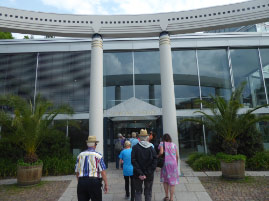
Baden-Baden |
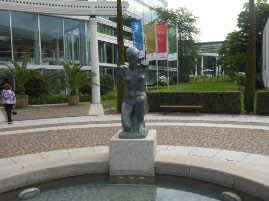
Baden-Baden |
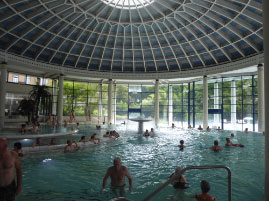
Baden-Baden |
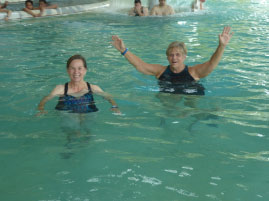
Baden-Baden |
One last stop before we leave Baden-Baden and head back to the ship – and that is Black Forest Cake. The cake is not directly named after the Black Forest mountain range – but rather from the specialty liquor of the region that is distilled from tart cherries. Everyone seems so excited to taste the cake. I’m not a fan of cherries and I don’t want anyone messing up my chocolate!
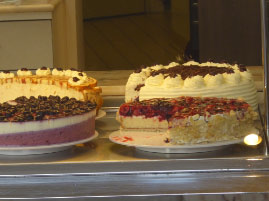
Baden-Baden |
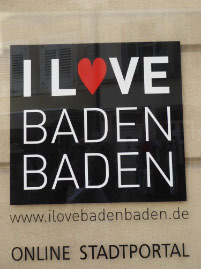
Baden-Baden |
We return to the ship for lunch.
Later, Tim (one of the tour leaders) gives a lecture about gun laws. (How I wish Americans had the same reasoning and logic as our European brothers and sisters!)
Tonight it’s the Farewell Drink and Captain’s Farewell Dinner. Afterwards, we are treated to French songs from two amazing French vocalist, André and Simone. After La Vie en Rose, I was like putty in their hands. (Clearly made up for the German men’s group!)
Monday, August 28, 2017 – Basel, Switzerland
It is our last day of the trip and we have one more town (Basel) to conquer before we’re homeward bound. Basel stands on the Rhine at the point where the French, German, and Swiss borders meet. The town was a Roman fort in A.D. 374, named Basilia, and was later ruled by prince-bishops for about 1,000 years. After Basel joined the Swiss Confederation in 1501, it became a Protestant region. During the onset of the Reformation in 1529, Basel was a safe refuge for victims of religious persecution. They flooded in from Holland, Italy, and France – and became part of laying the foundation for the city's great golden age in the 18th century.
Paulina, with her endless energy, leads us from the boat to the tram to start our tour of Basel.
Daughter Ainsley has one more day with her delightful Mama Harriett. (We’re going to miss them)
We board the tram. Paulina makes it a point to involve us with the locals. Today, she engages with Trudy, an older Swiss lady who is a bit crazy. Paulina knows when to move on. We feel free to get to know the dogs on the tram – especially Ainsley – She misses her puppy.
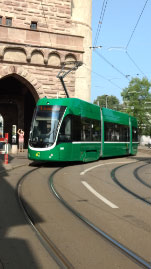
Basel |
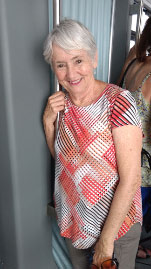
Basel |
We arrive in the city. Basel gives off a vibe of old European grandeur and quaintness with its network of narrow alleys from medieval times. However, it is the second largest city in Switzerland and a banking and industrial center. In addition, Basel's chemical and pharmaceutical industry is one of the most important in the world.
With more than 30 museums, Basel is a well-known center of art and culture. Dating to 1662, the Museum of Fine Arts is considered the oldest public art museum in Europe. Every June, Basel hosts a world famous Art Festival.
Back in 1356, a devastating earthquake (of 6 or 7 on the Richter scale) killed 300 people and changed everything. The earthquake even took out many of the ancient Roman walls -- not an easy feat.
Paulina takes us into a Bank – the UBS bank and tells us that during WW II, the banks took money from the Jewish people and refused to return it. (I’d never bank there!)
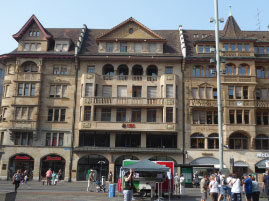
Basel |
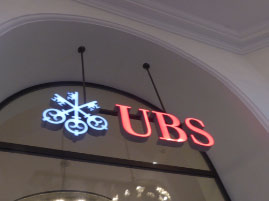
Basel |
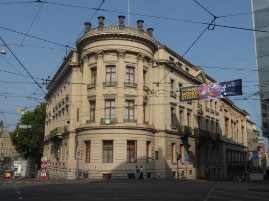
Basel |
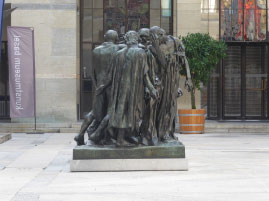
Basel |
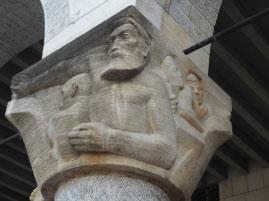
Basel |
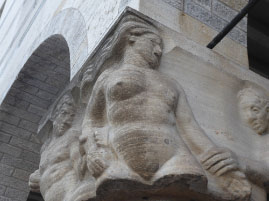
Basel |
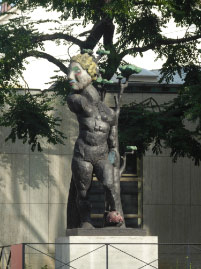
Basel |
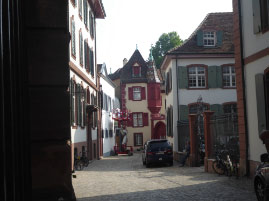
Basel |
Paulina takes us through the one of the ritziest neighborhoods – a place that only the owners of internet companies can afford.
A few blocks later, Paulina shows us the school for international school. She tries to engage the kids – but they were not friendly probably their teachers were annoyed – so we moved on.
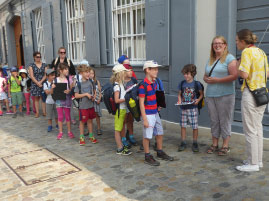
Basel |
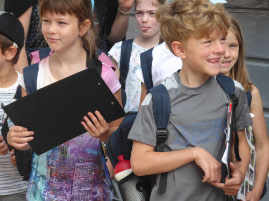
Basel |
Every Monday brides and grooms come into the city to get married. We saw several happy couples. I photographed the cooler couples -- one already with a baby carriage and another who was the happiest of all, but no longer “Spring Chickens” – Good for them!
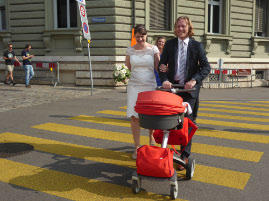
Basel |
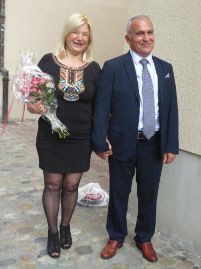
Basel |
Münster
Muster Cathedral has three sections – the main Cathedral, the view outback by the Rhine River and the Cloister.
We start with the Cloister. The cloister has lovely gardens, beautifully arched corridors, stone plaques and sculptures. The six-sided star, not star of David, is displayed prominently in the main, round window. However, it has no religious significance, but represents the Brewery who paid for the church.
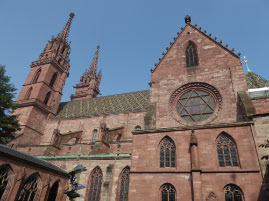
Münster Cathedral |
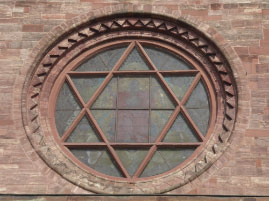
Münster Cathedral |
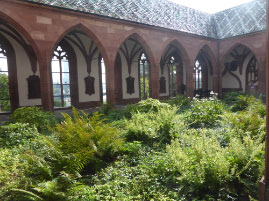
Münster Cathedral |
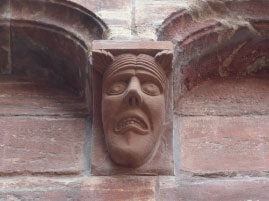
Münster Cathedral |
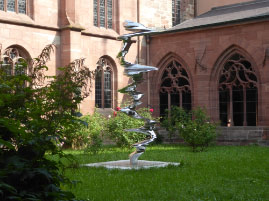
Münster Cathedral |
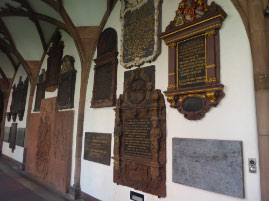
Münster Cathedral |
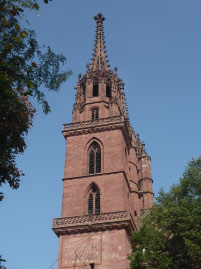
Münster Cathedral |
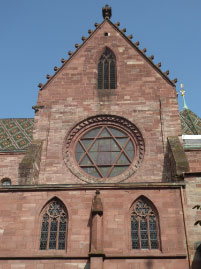
Münster Cathedral |
As one of Switzerland's most important cultural centers, Basel saw the development of the printing press and the book trade. In 1516, Erasmus, the great Dutch humanist and writer, published here the first edition of the New Testament in the original Greek. He is buried in the cathedral. Another famous resident was the German philosopher Friedrich Nietzsche, who taught at the University of Basel.
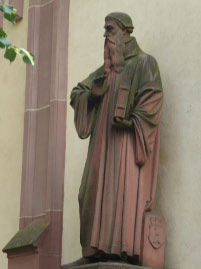
Münster Cathedral |
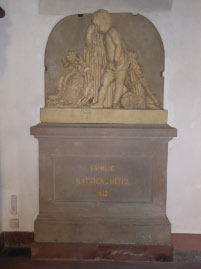
Münster Cathedral |
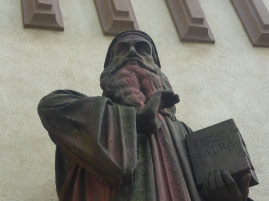
Münster Cathedral |
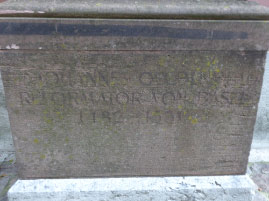
Münster Cathedral |
From the Cloisters, we walk to the treed terrace area overlooking a panorama view of the Rhine River. It is possible to take a steep stairway and climb down to the riverbank and take the ferry to the other side. “Rheinfahre” ride with the Basel ferry boats, costs very little and takes only a few minutes to cross the Rhine. The current carries the boats which are pulled by a cable from one side to the other.
Paulina tells us that the Swiss were not involved in WW II, but hid explosives under the bridges – just in case. Blowing up the bridges to keep the Germans out of town was a wise plan to have in their back pocket.
(By the way, I never noticed before that the Swiss Flag is square (with a white cross). Most countries have rectangular flags.
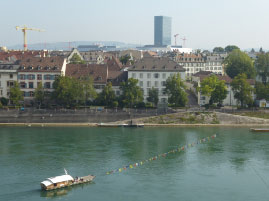
Basel Ferry |
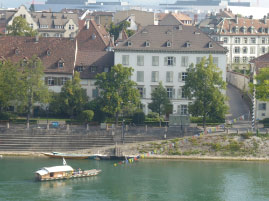
Basel Ferry |
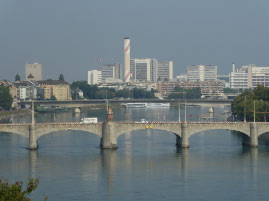
Basel Ferry |
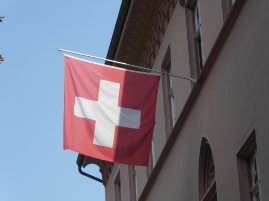
Swiss Flag |
From the back terrace, we walk to the front of the Munster (cathedral). This twelfth-century, red sandstone cathedral is the top historical and architectural sight in Basel. It sits on a hill above river Rhine and towers over the Old Town. It was consecrated way back in 1019. Between 1019 and 1500 it served as a Catholic cathedral. But since 1529, it has been an Evangelical Reformed Protestant church. Destroyed by an earthquake in 1356, it was rebuilt along Romanesque and Gothic lines with a green-and-yellow-tile roof.
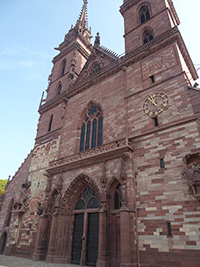
Münster Cathedral |
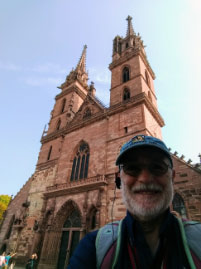
Münster Cathedral |
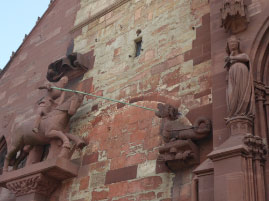
Münster Cathedral |
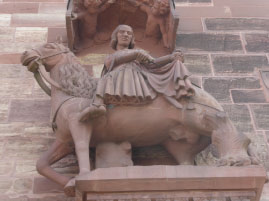
Münster Cathedral |
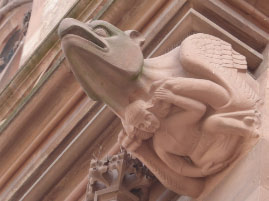
Münster Cathedral |
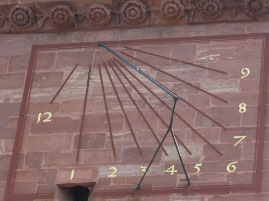
Münster Cathedral |
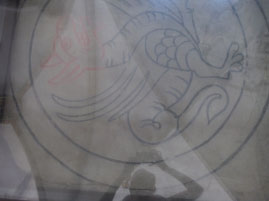
Münster Cathedral |
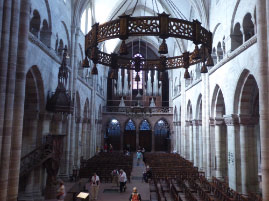
Münster Cathedral |
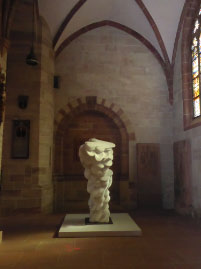
Münster Cathedral |
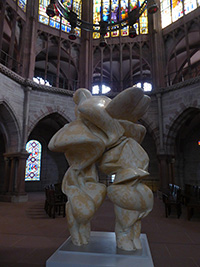
Münster Cathedral |
DOWNTOWN
Right smack dab in the middle of Marktplatz (Market Place), sits the Rathaus, the sandstone medieval City Hall. The Town Hall dates back to the early 1500s, although the current building was reconstructed from the beginning of the twentieth century. We enter the courtyard. I have not seen anything like it before. The frescos are unique and reflect a bygone era -- paintings of allegorical images, historic figures, and scenes of the Swiss confederation. There is a statue of Lucius Munatius Plancus, a Roman Senator and founder of the town.
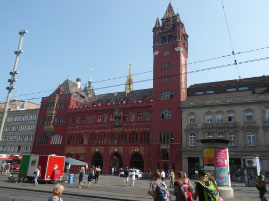
Rathaus |
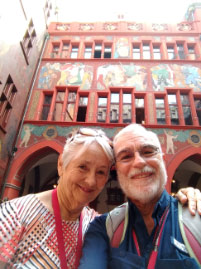
Rathaus |
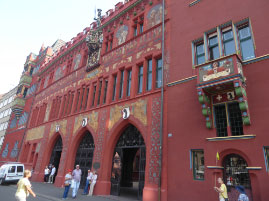
Rathaus |
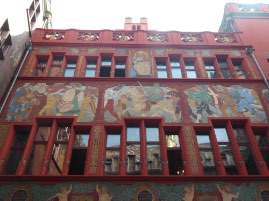
Rathaus |
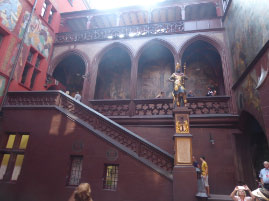
Rathaus |
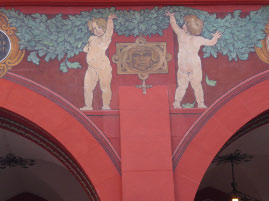
Rathaus |
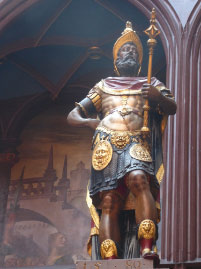
Rathaus |
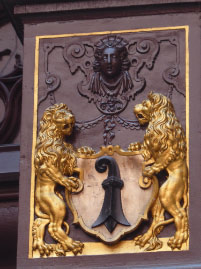
Rathaus |
Released from the group, Bill and I take off on a side street from the Marketplace. On our independent walk, we discover:
- The town well (left over from eons ago),
- Plagues with names of famous Swiss people lining the wall (Roger Federer is a Swiss professional tennis player who is currently ranked world No. 2 in men's singles tennis by the Association of Tennis Professionals),
- Cute little shops with our favorite, “Ass Bar” near the City Gate
- City Gate
- A most adorable Swiss lady with her dogs with such style and class
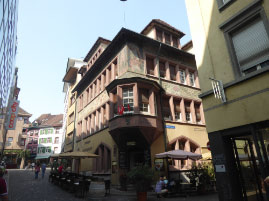
Basel |
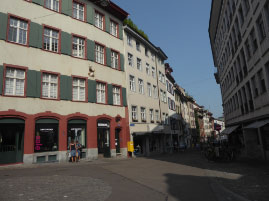
Basel |
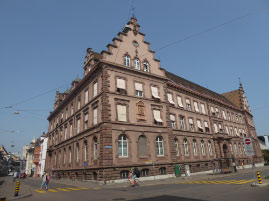
Basel |
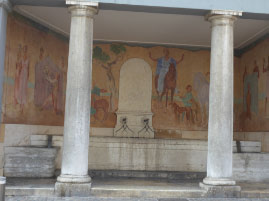
Basel |
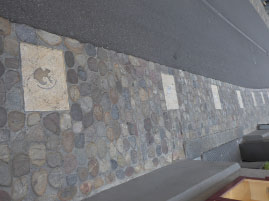
Basel |
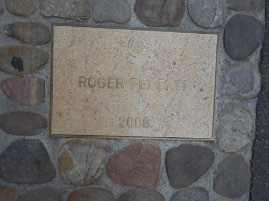
Basel |
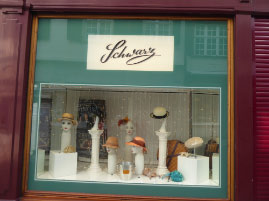
Basel |
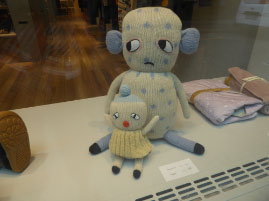
Basel |
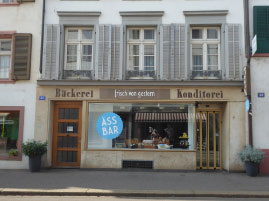
Basel |
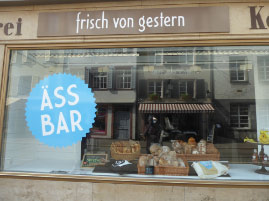
Basel |
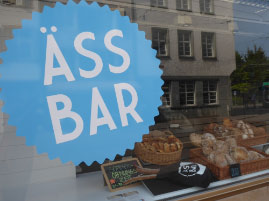
Basel |
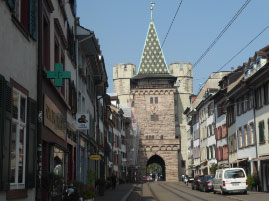
Basel |
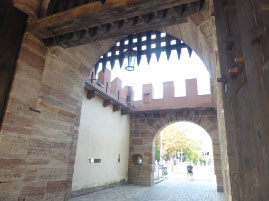
Basel |
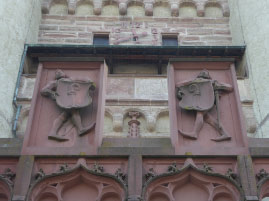
Basel |
We were tired so we left with Paulina at noon to take the streetcar back to the boat. Back at the boat, we had a nice lunch with Steve and Patsy.
After a rest, we went to a talk about Switzerland Today with someone named Kew.
That evening, we have dinner with Patsy and Steve, Bob Strassheim (widower) and our queen, Paulina. There were lots of Hugs and thanks and love. Beautiful trip.
Tuesday, August 29, 2017 – Fly home!
After breakfast and a complicated system of color coded luggage tags, we’re off to the airport and then home. Flying from Europe is a piece of cake – home in no times.
|











